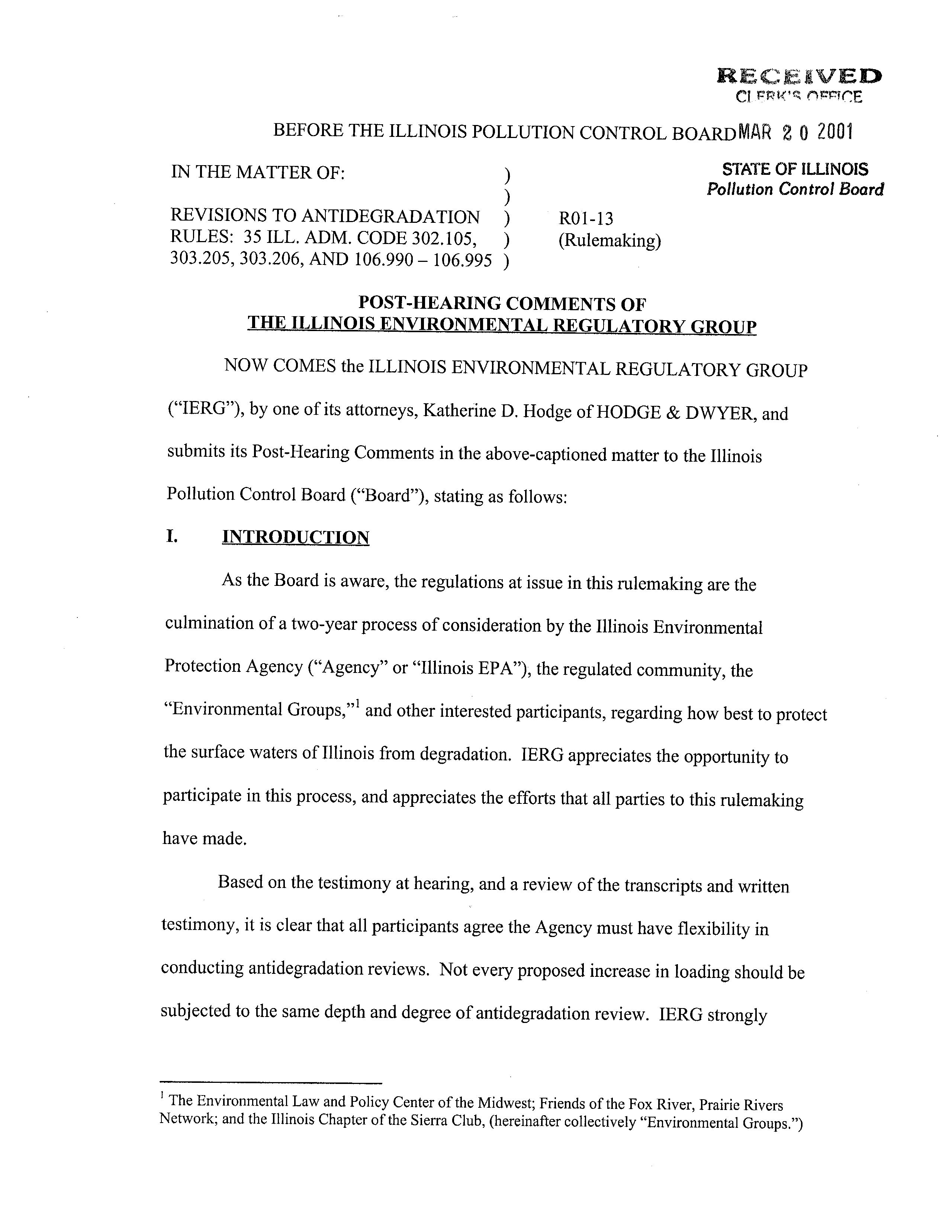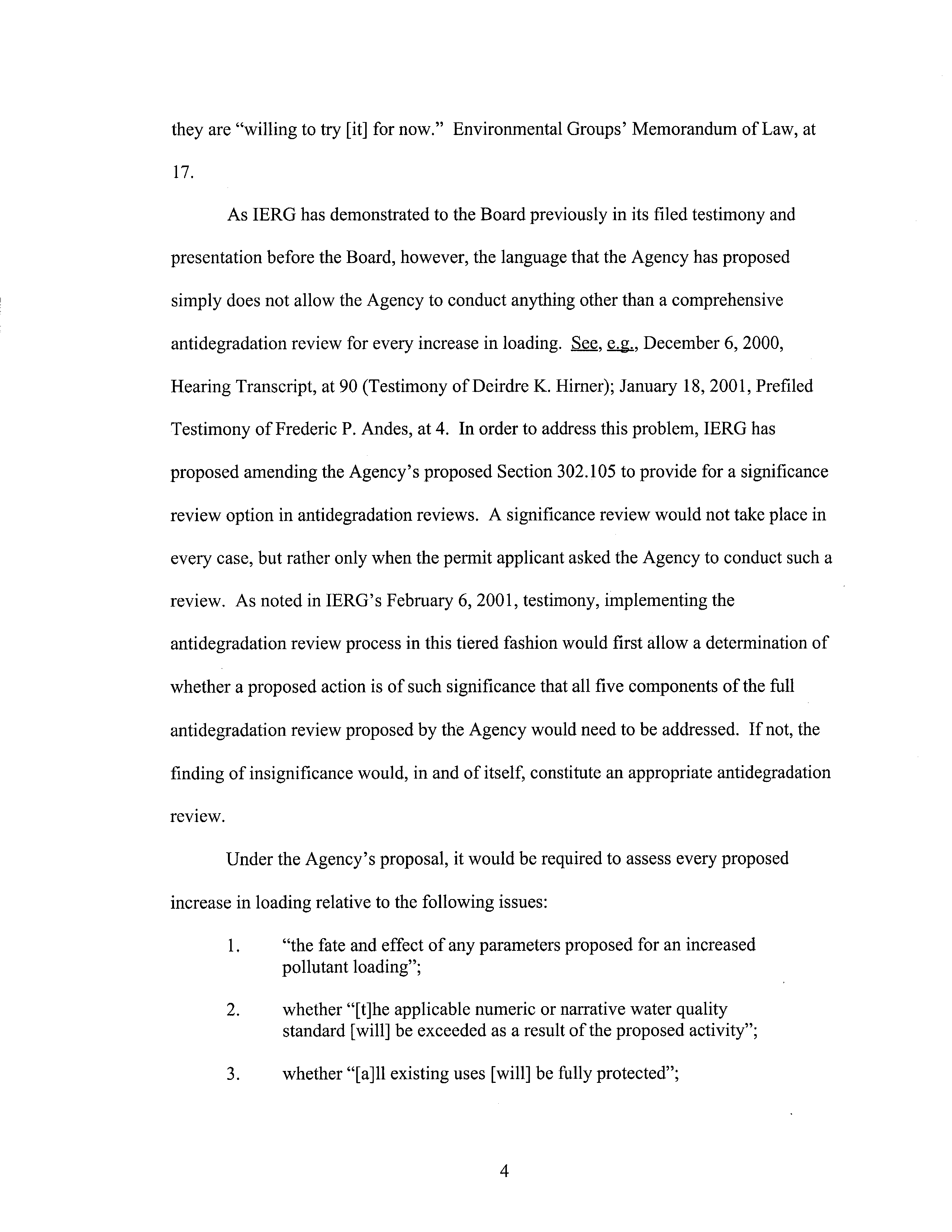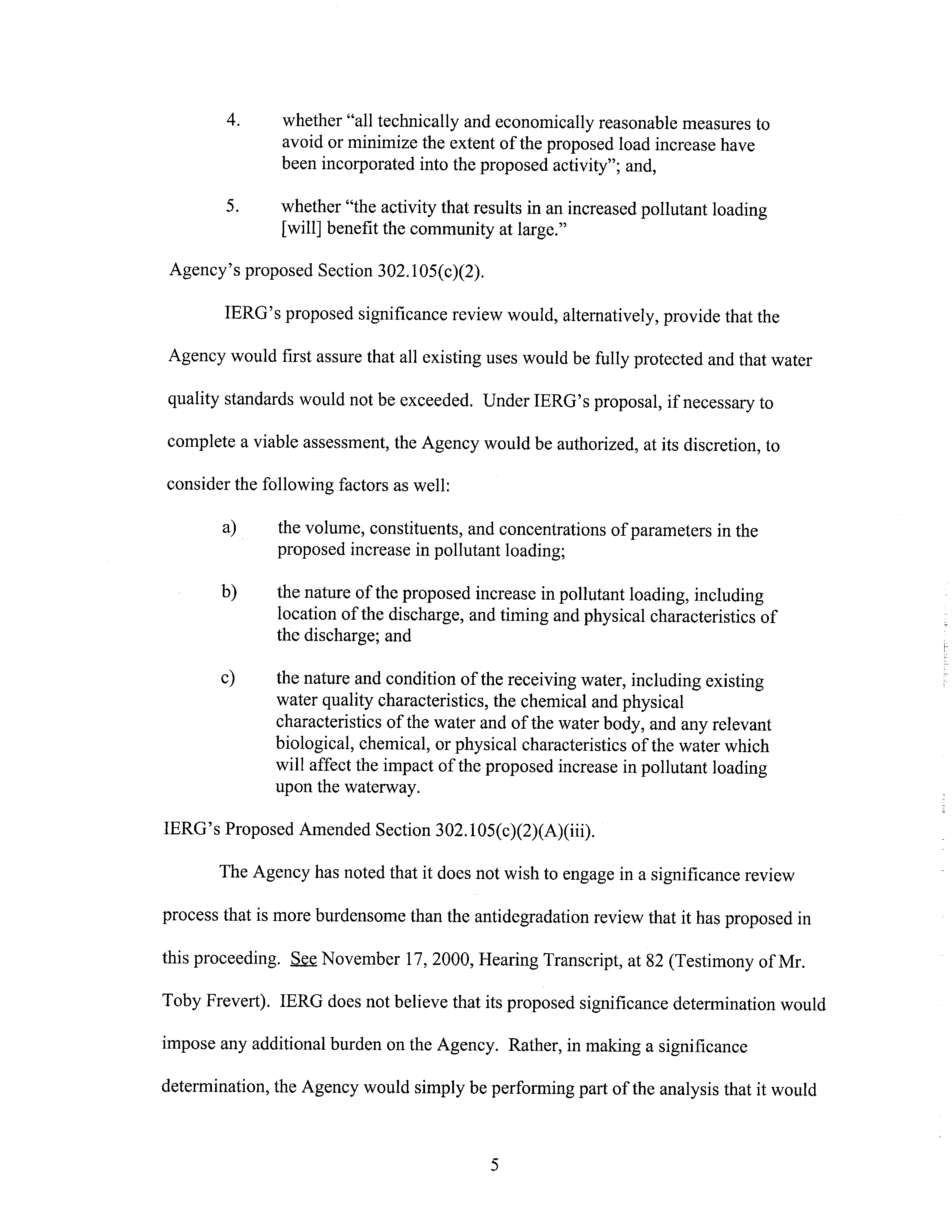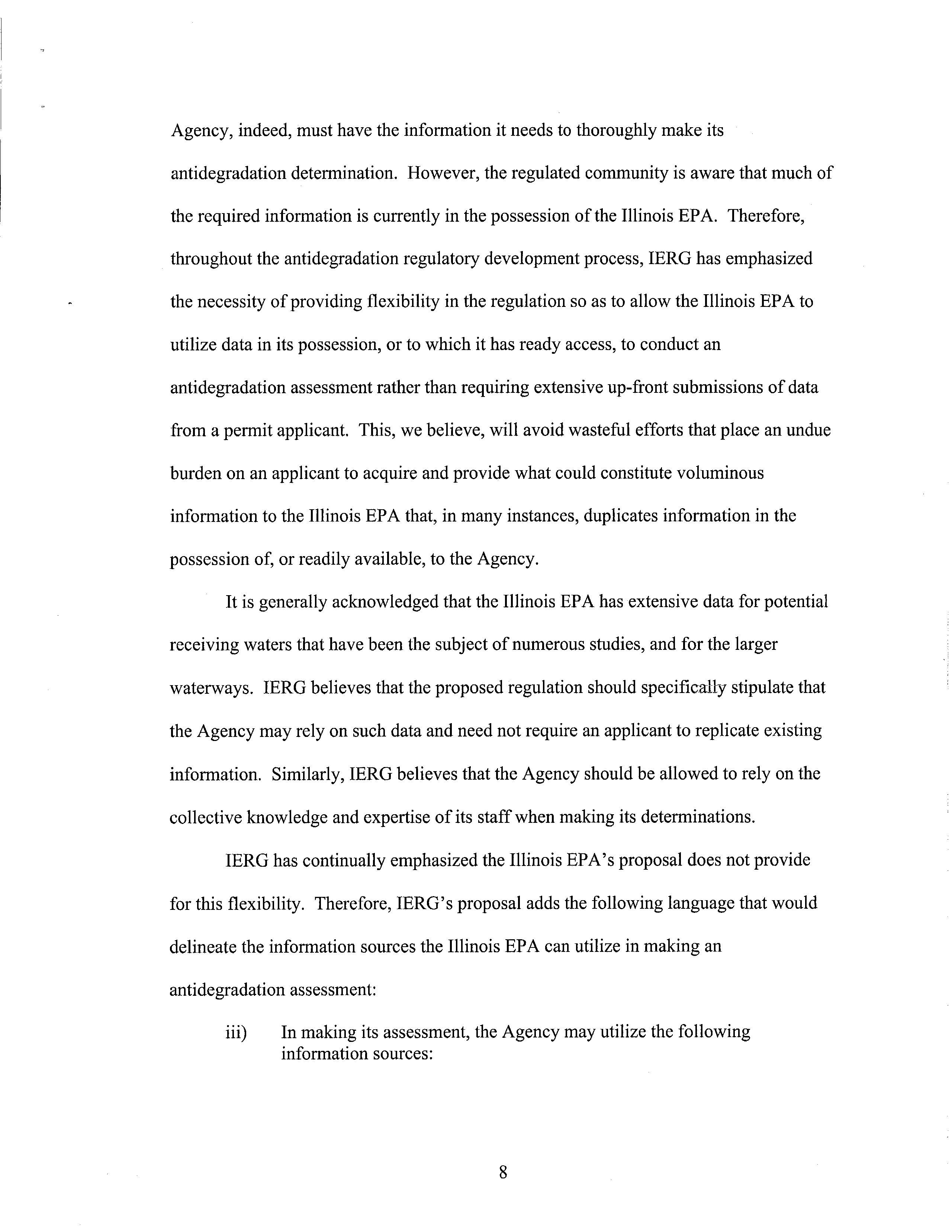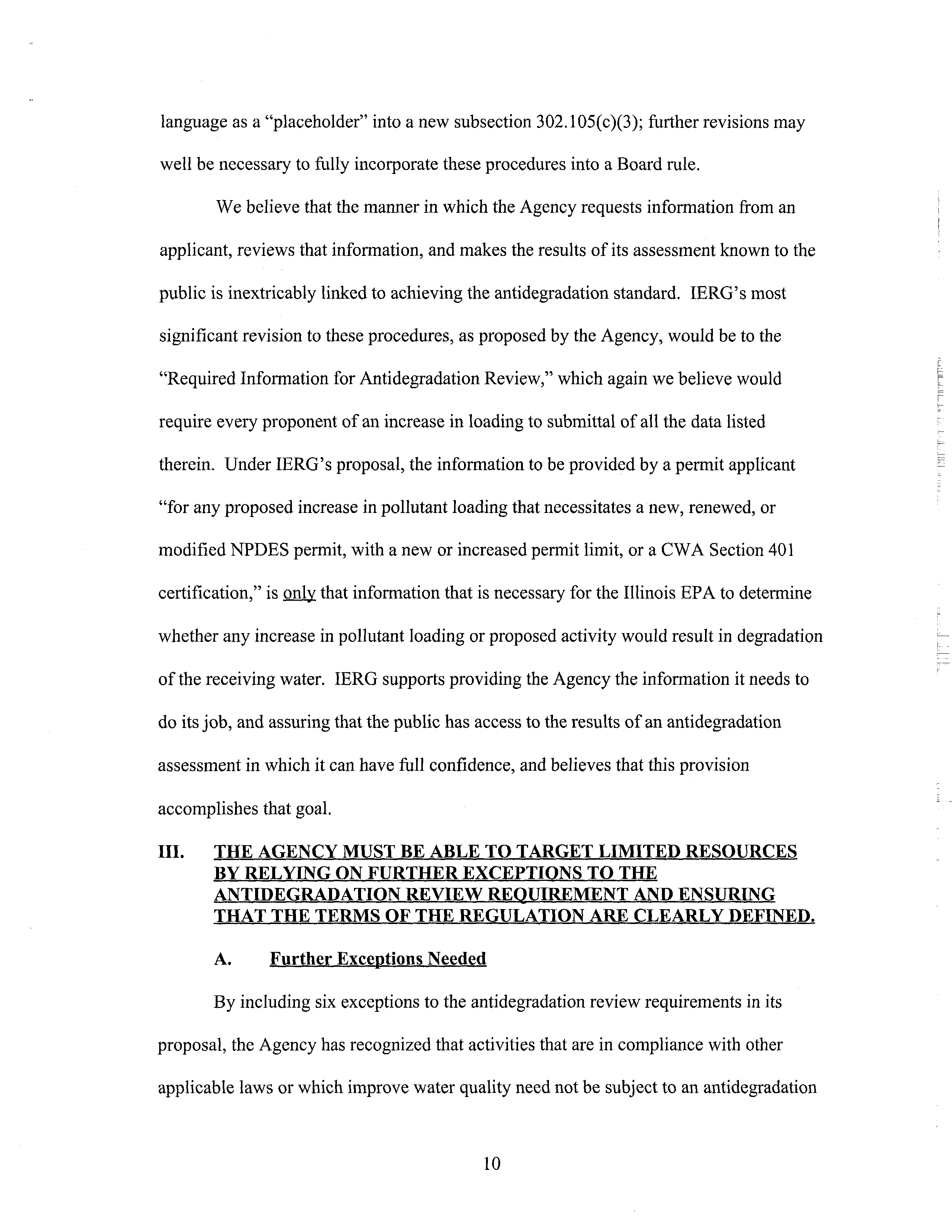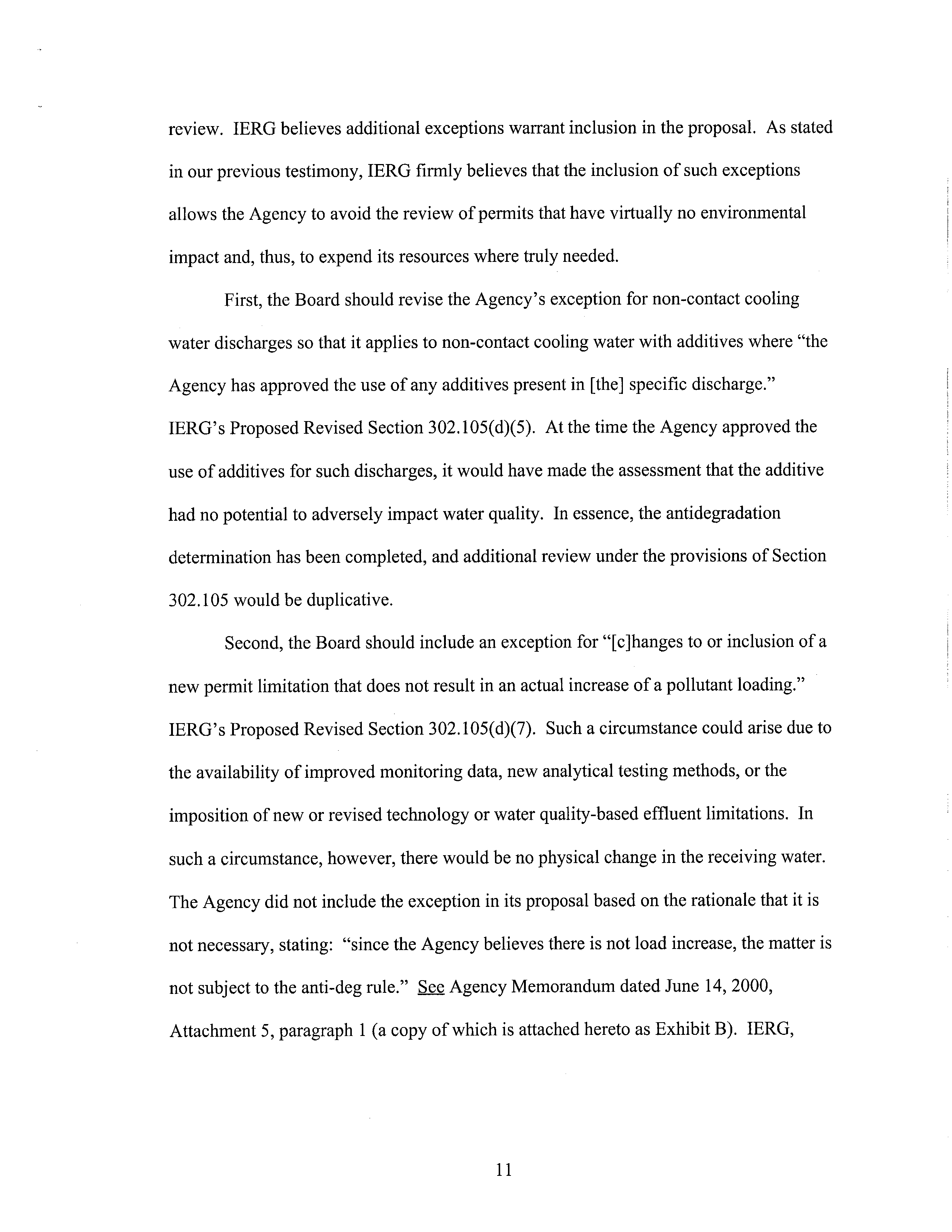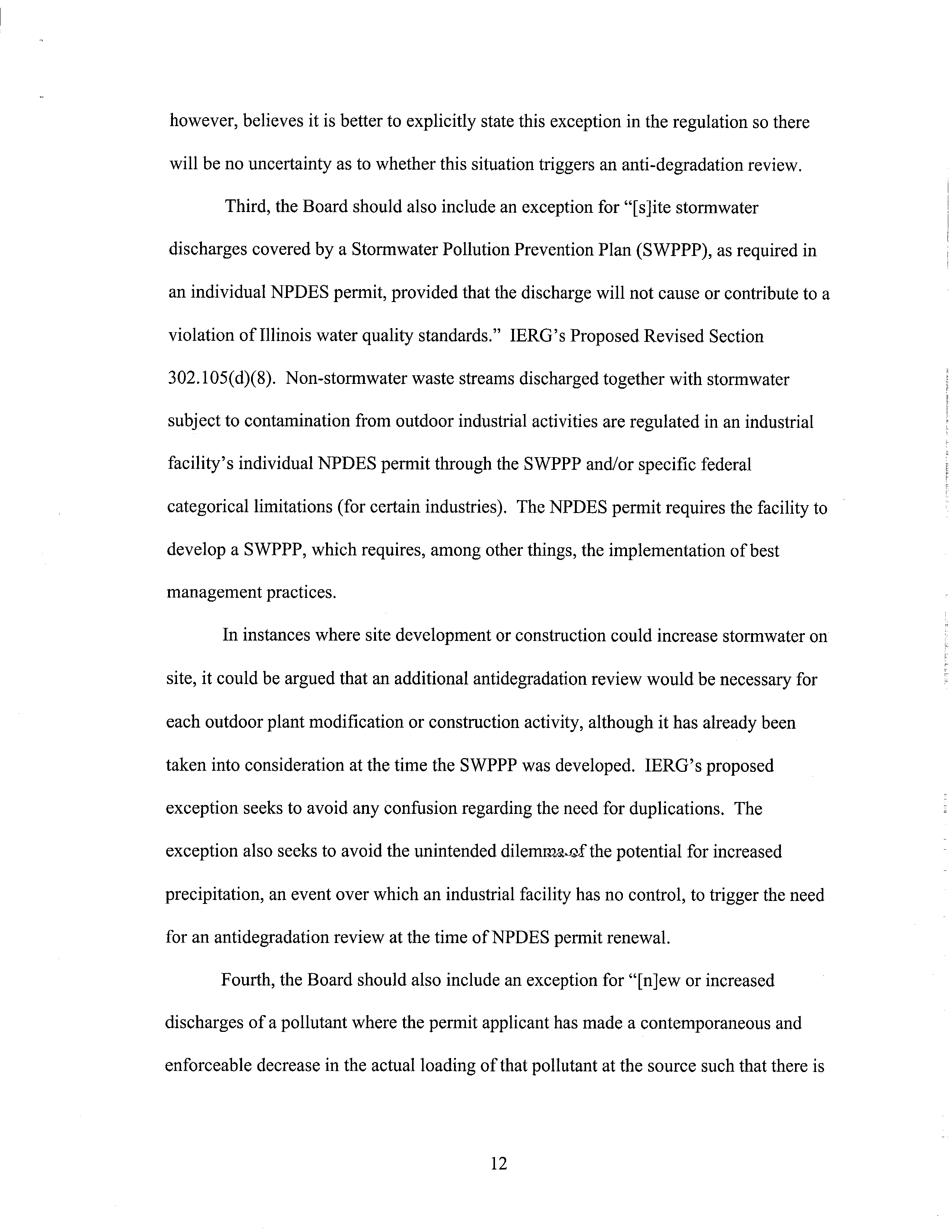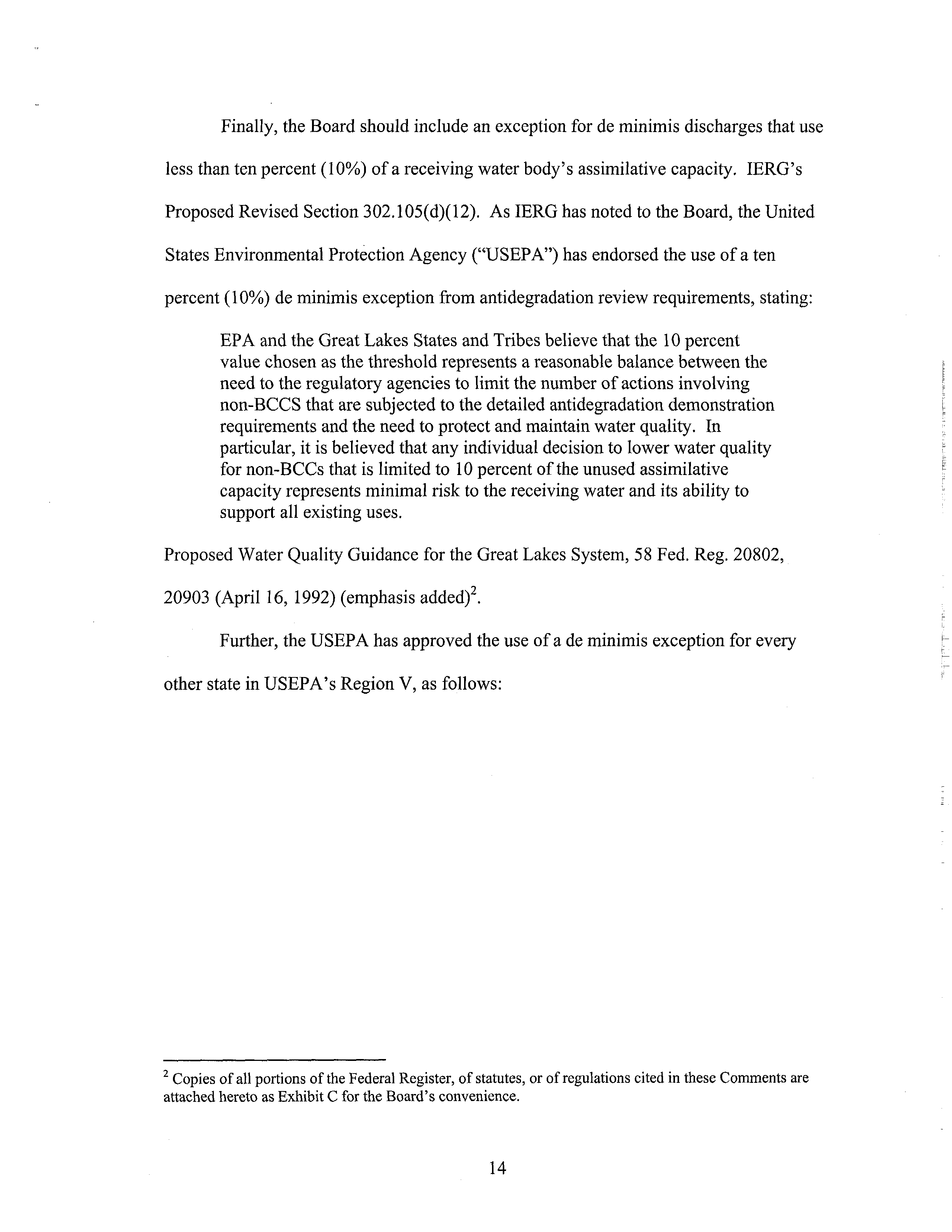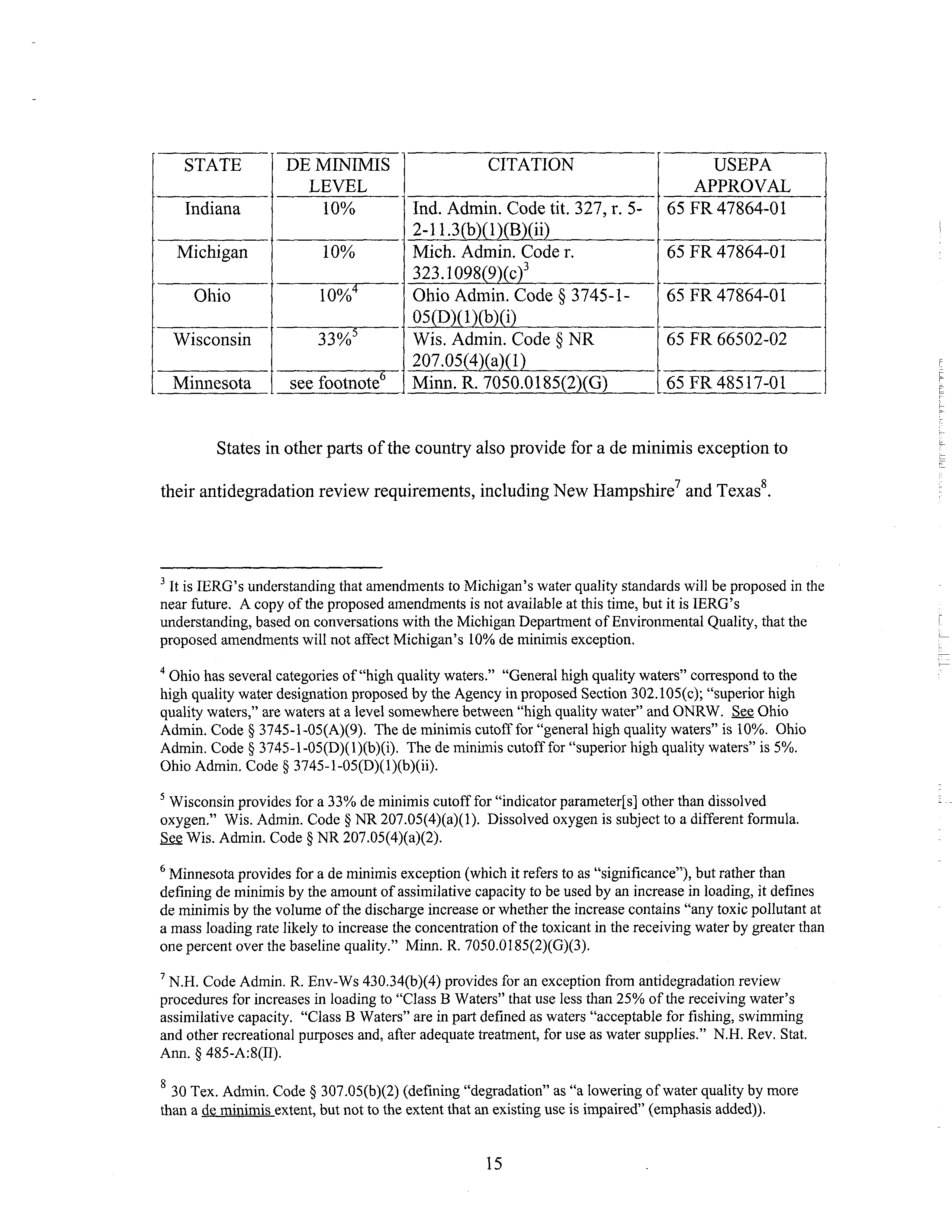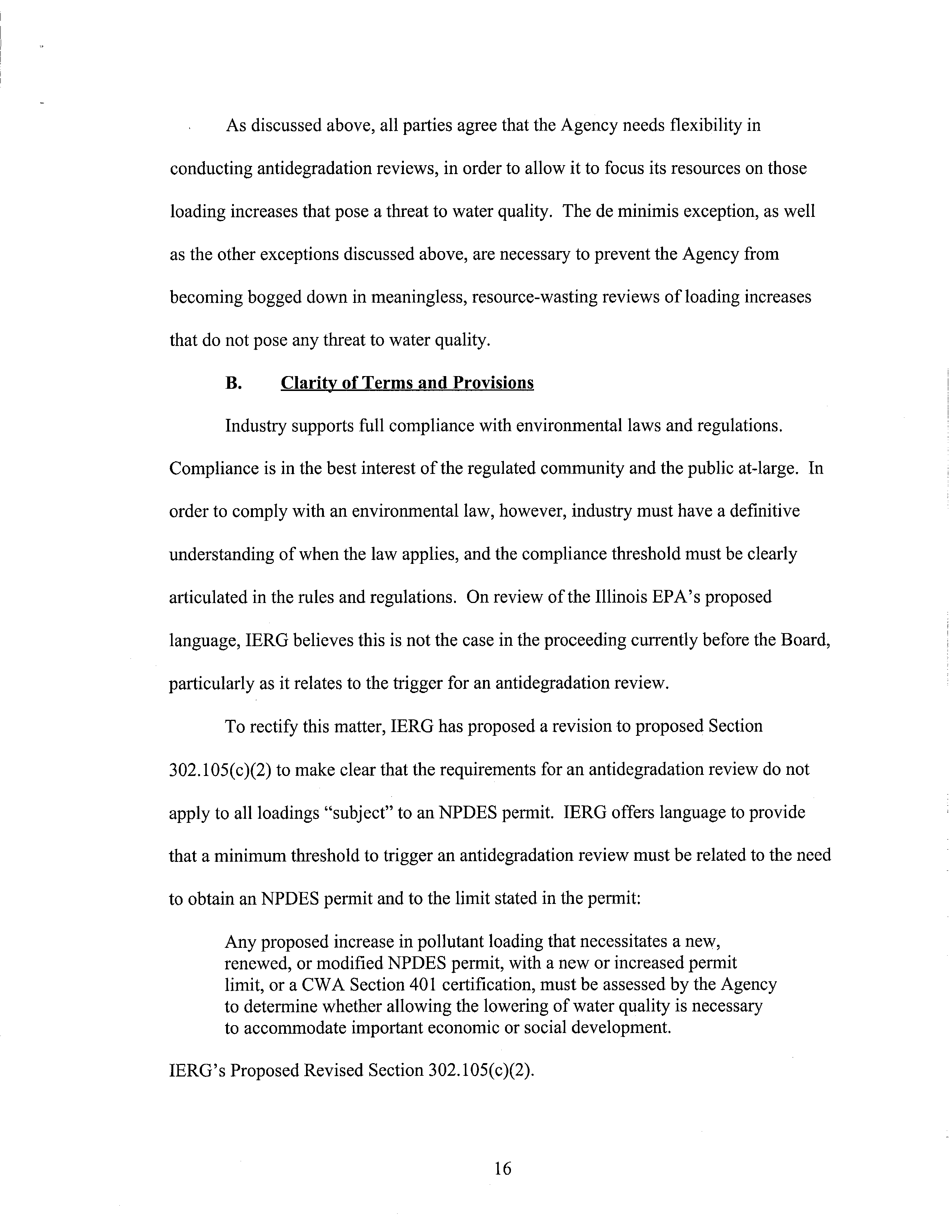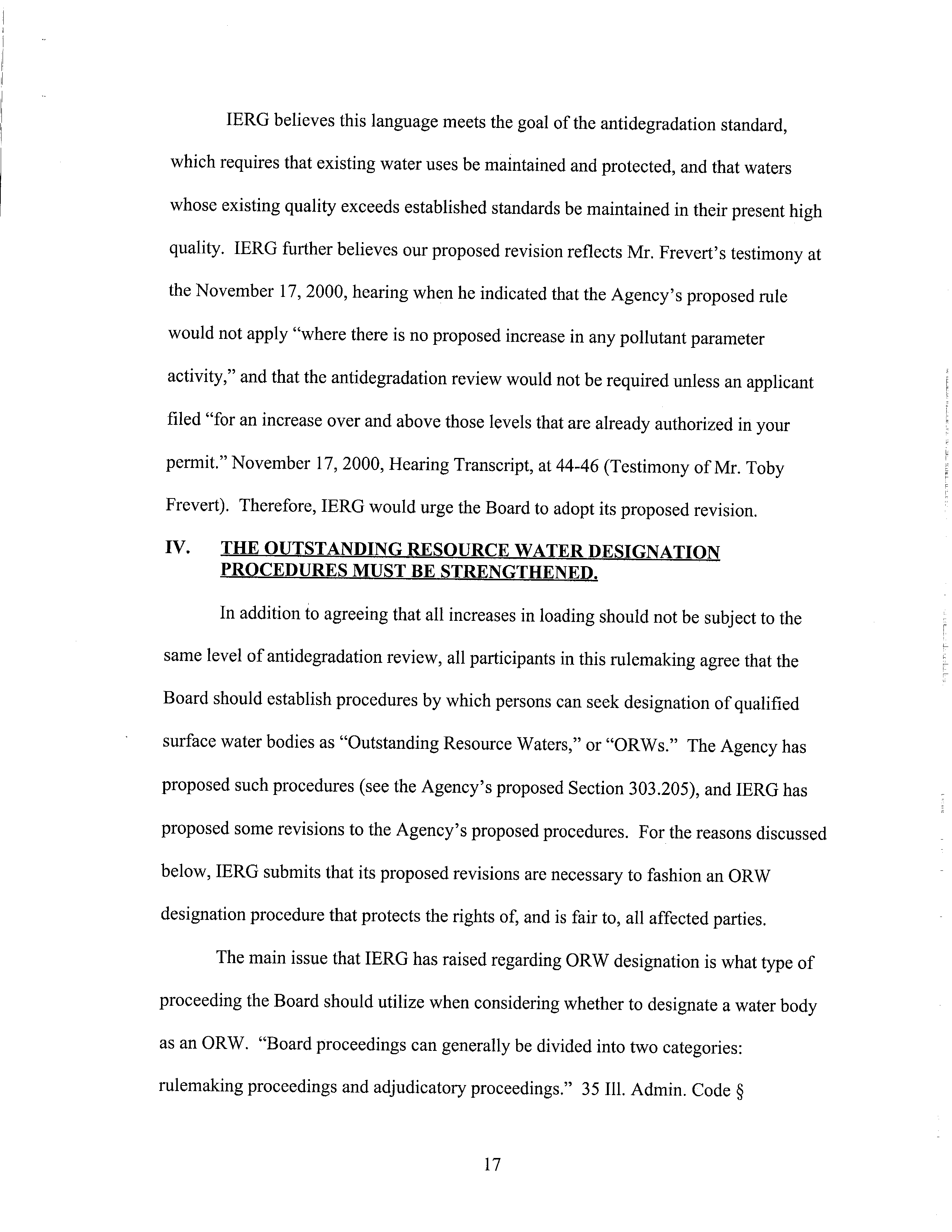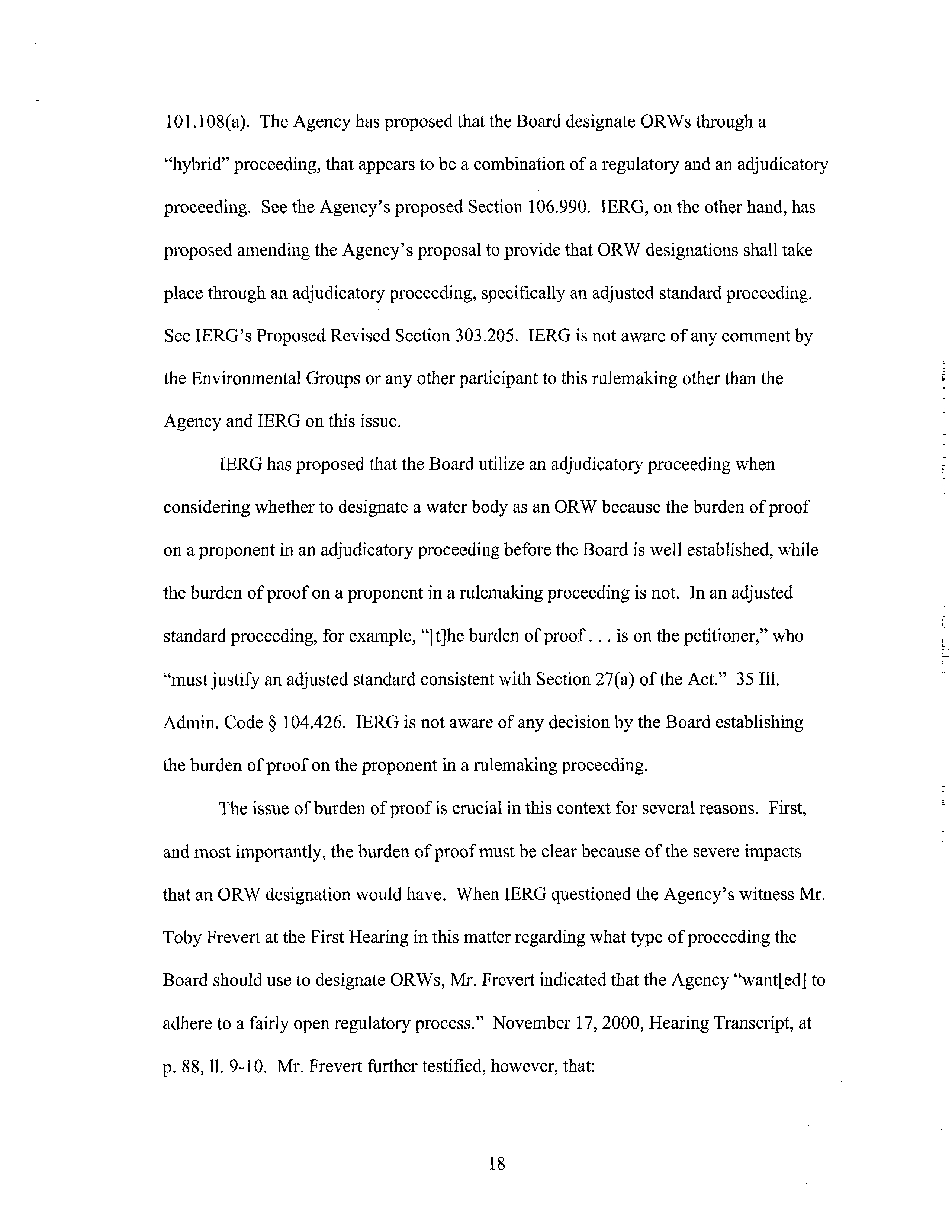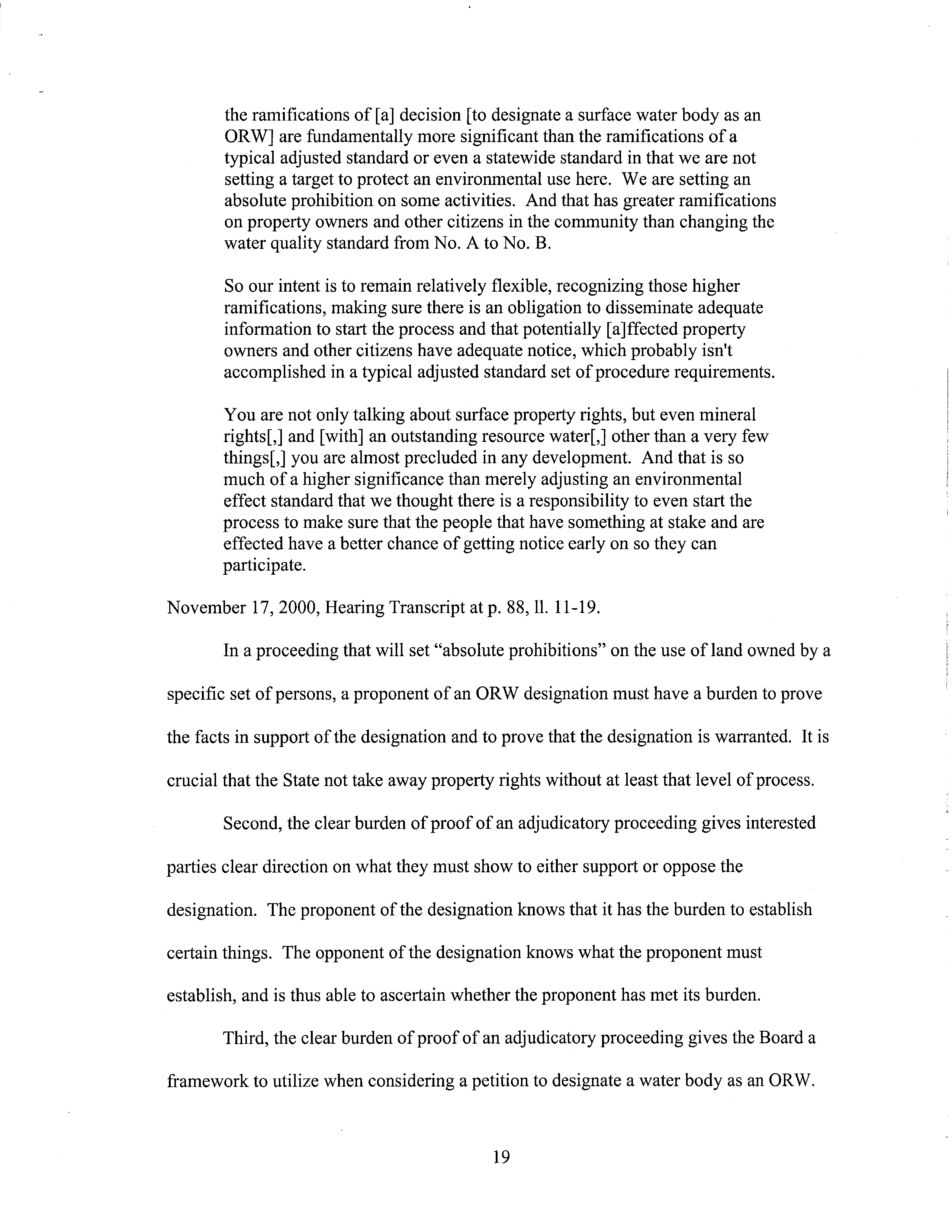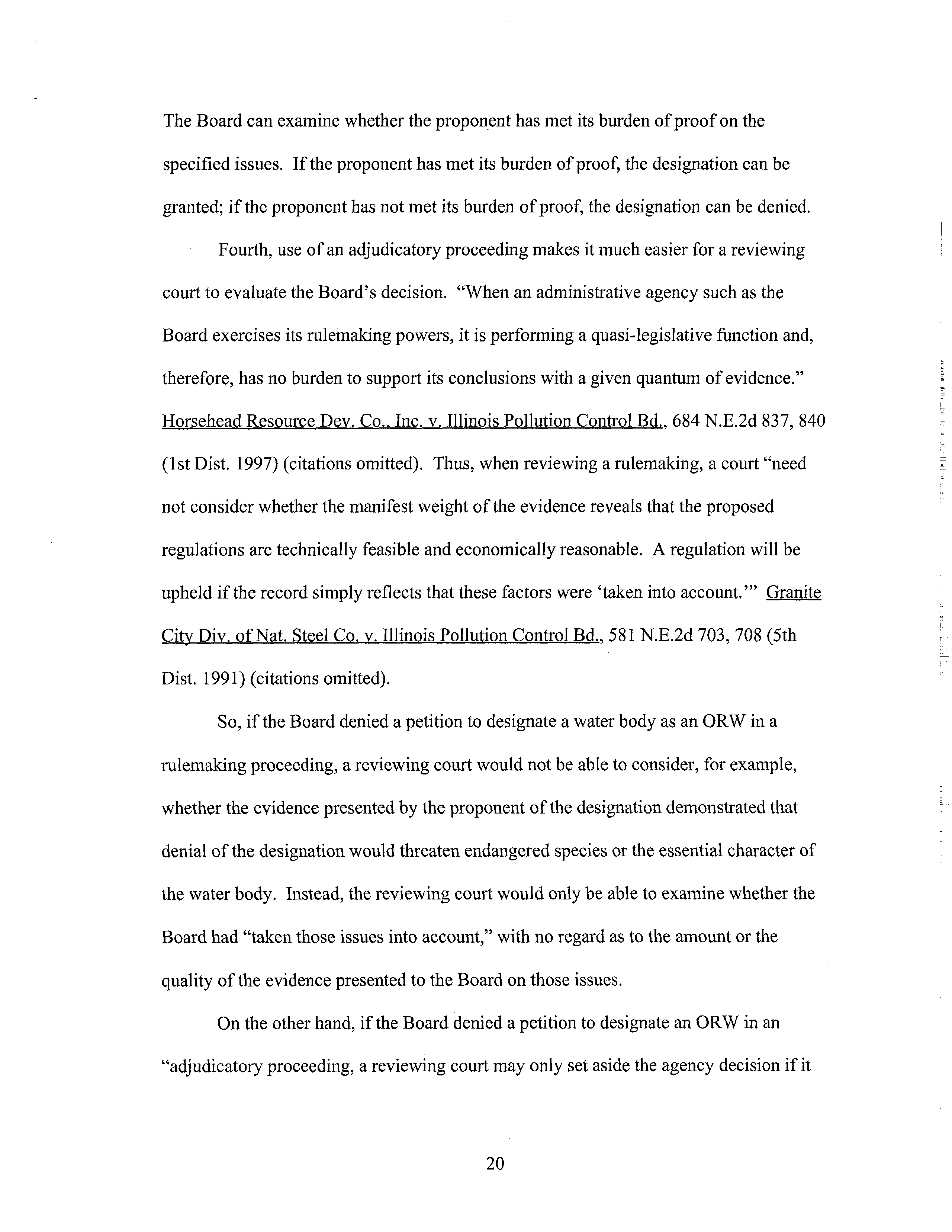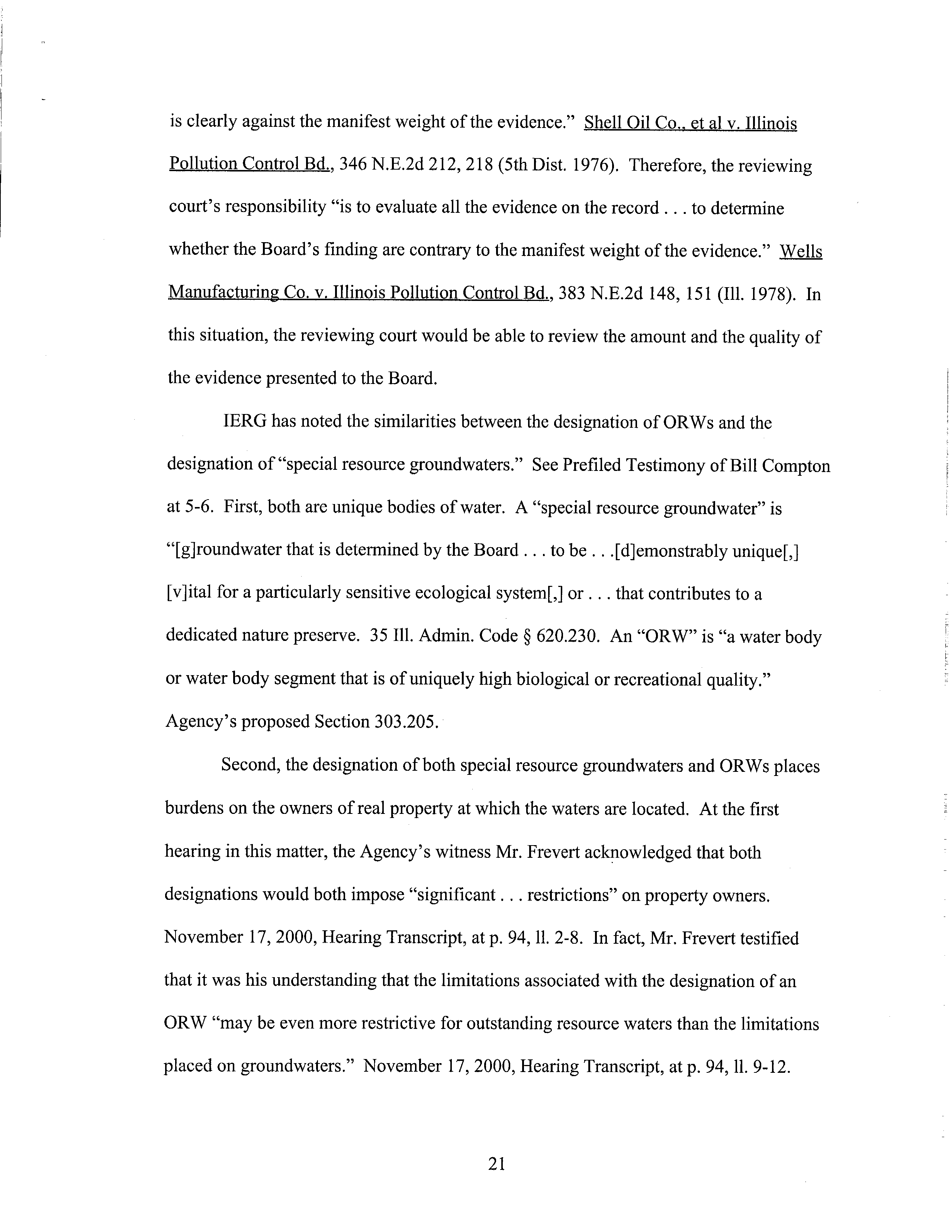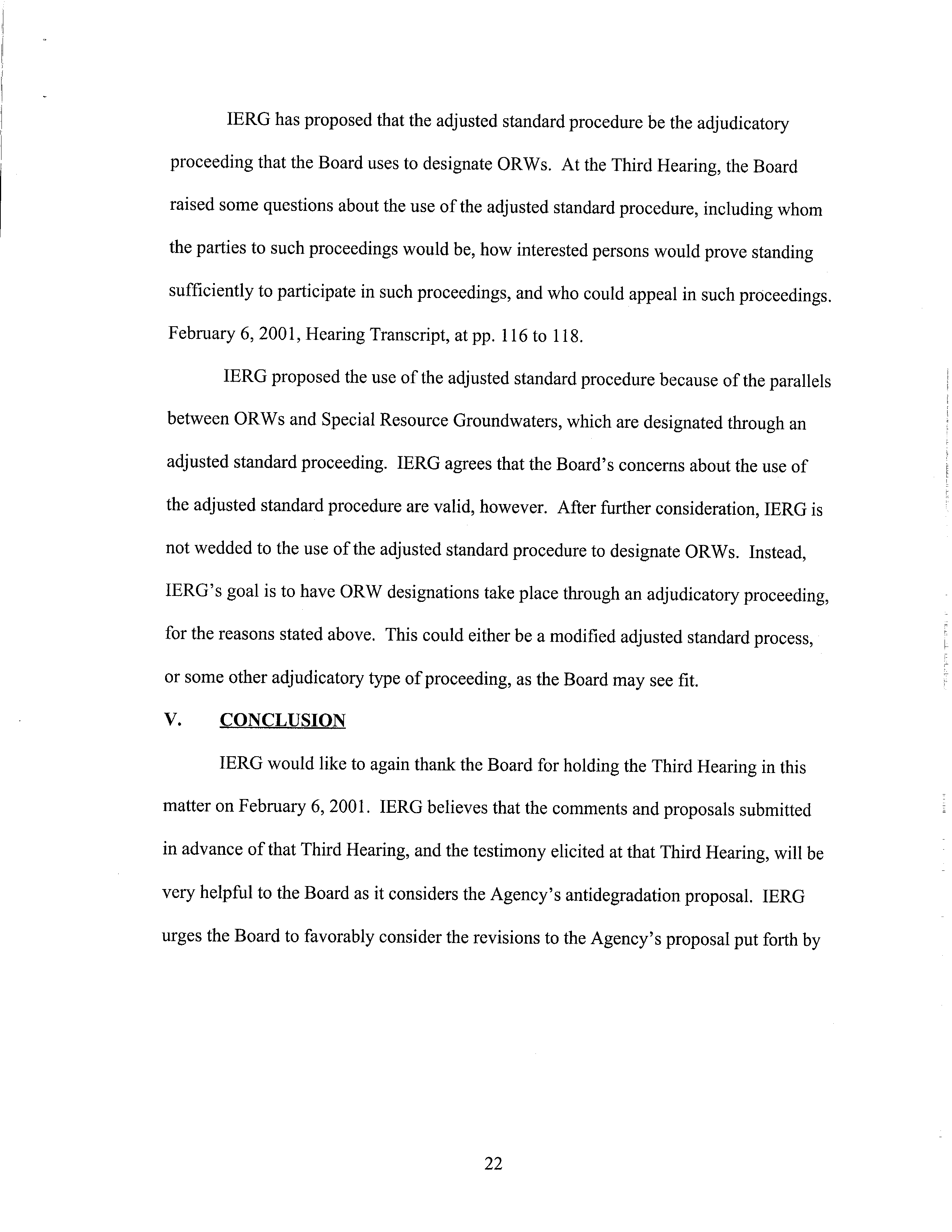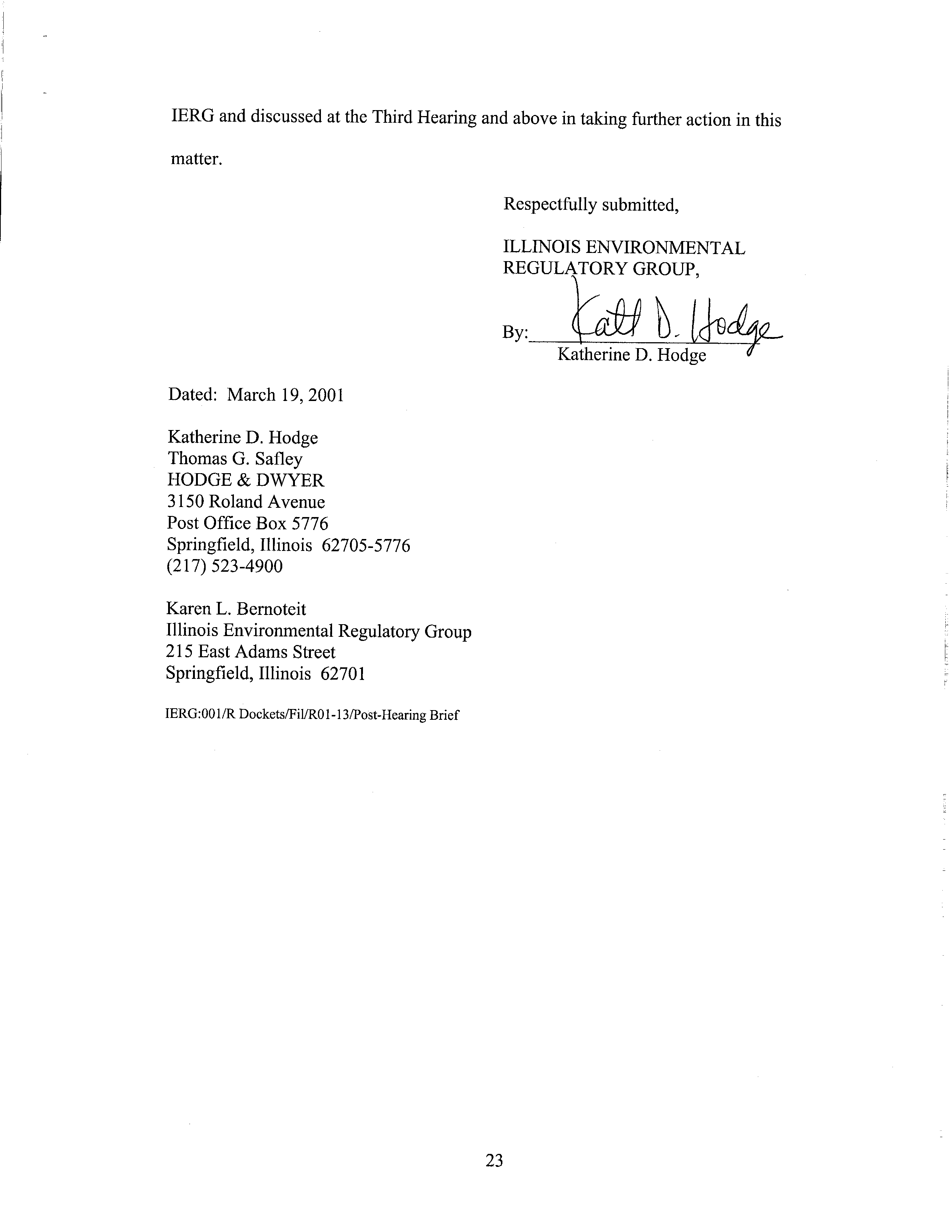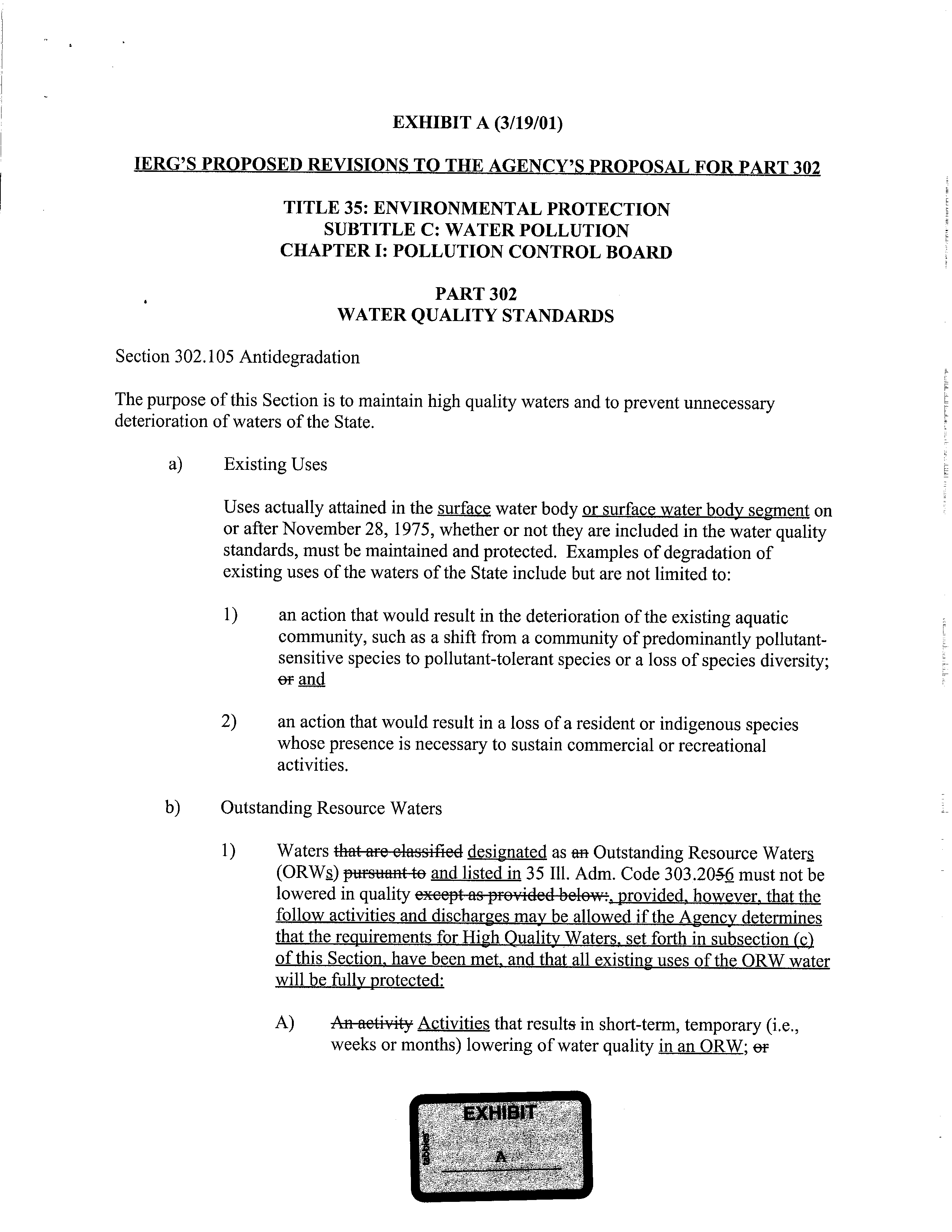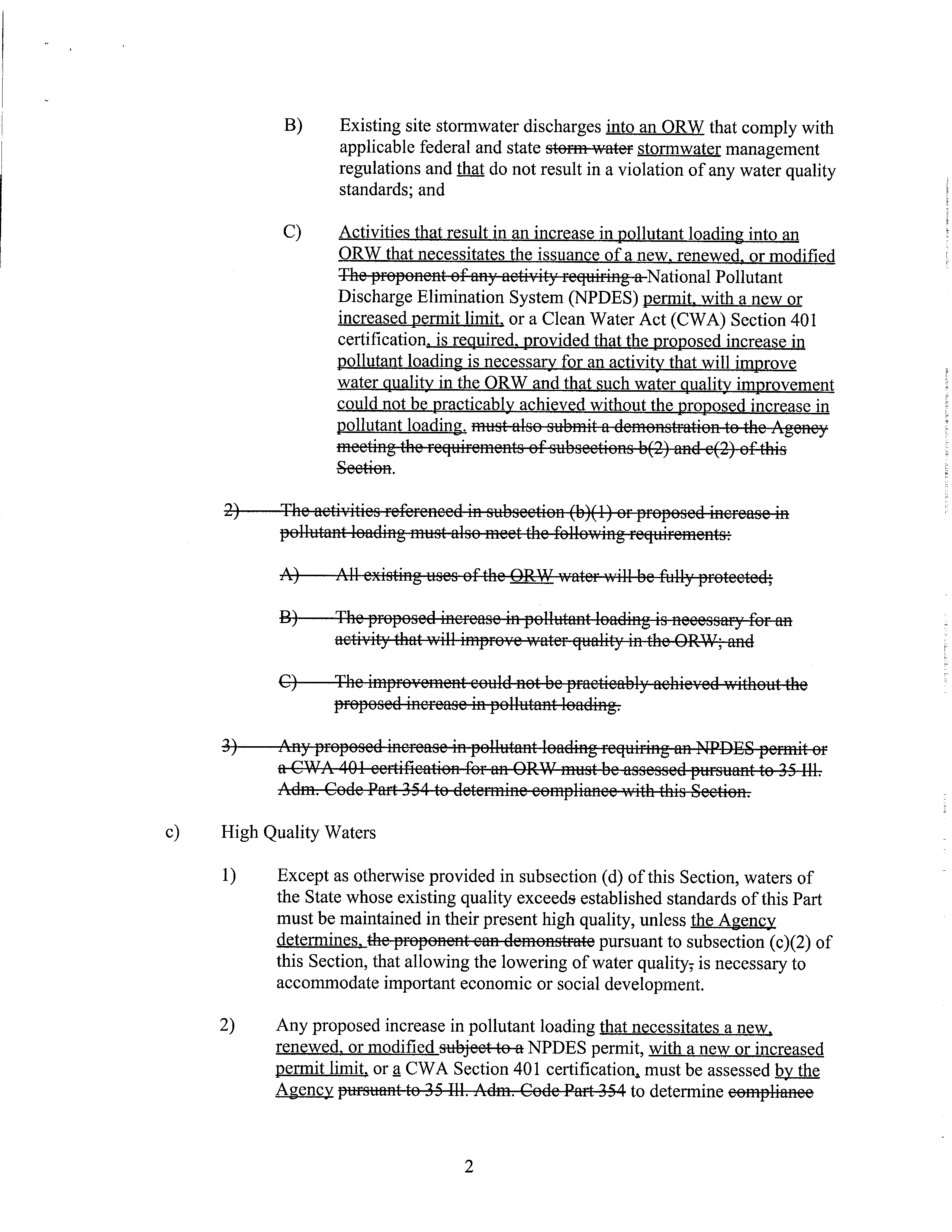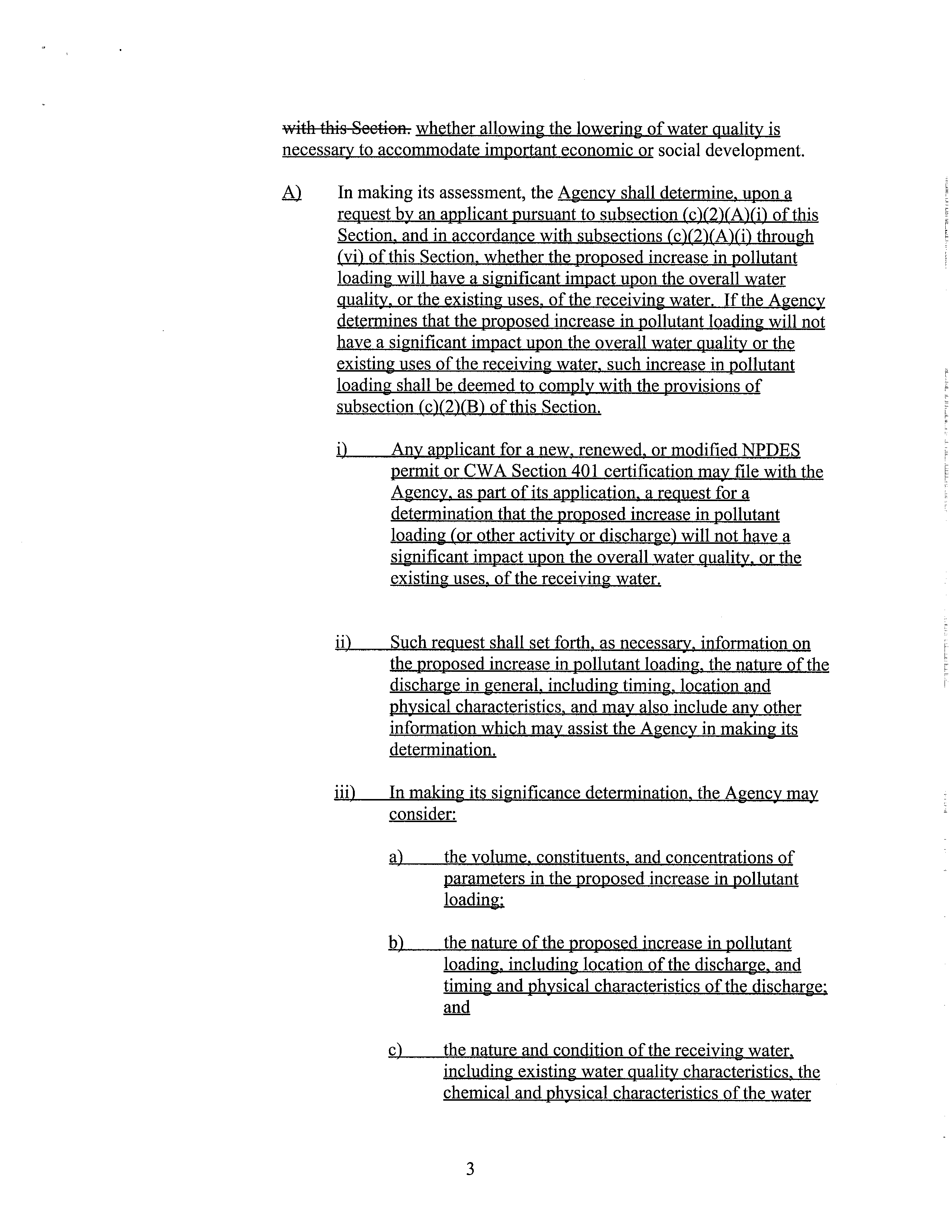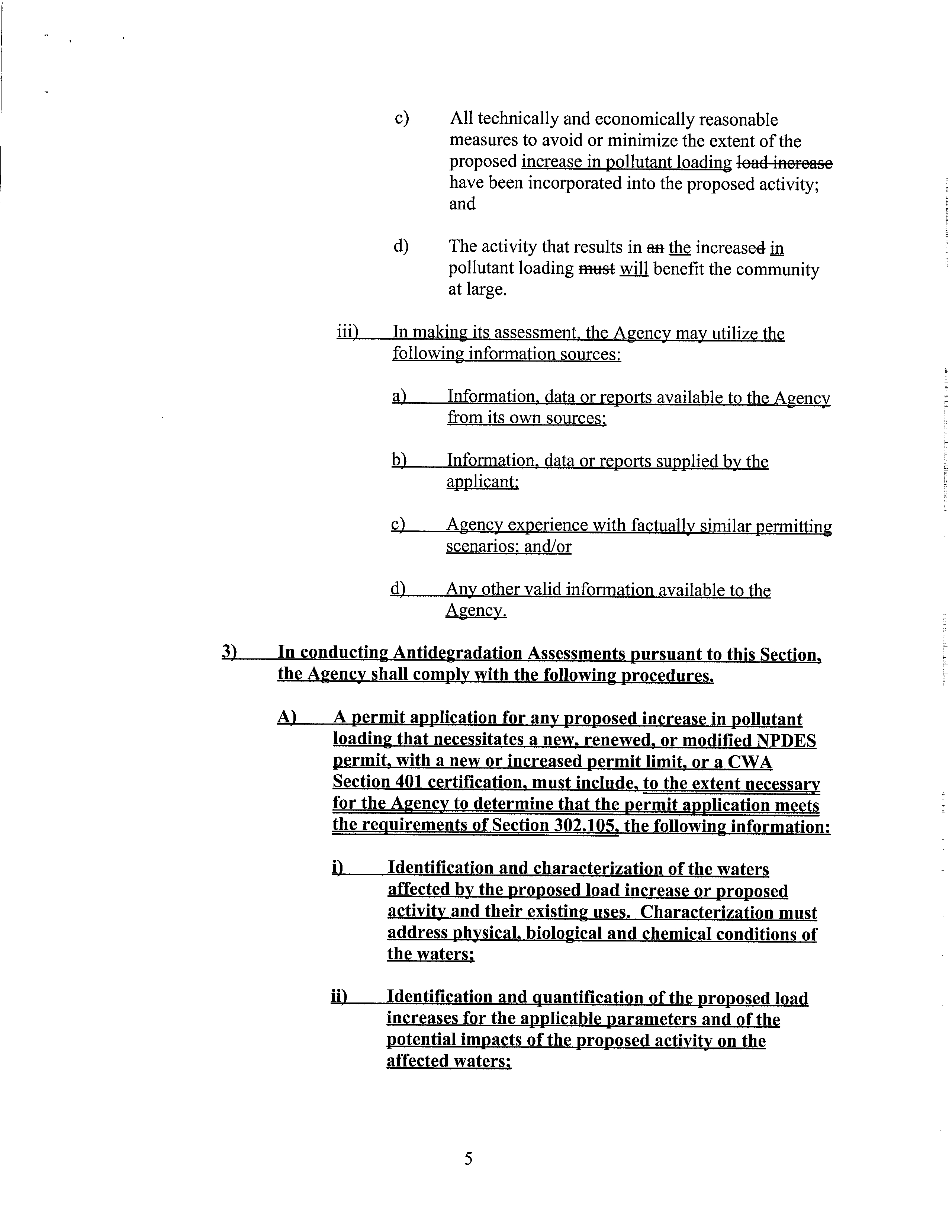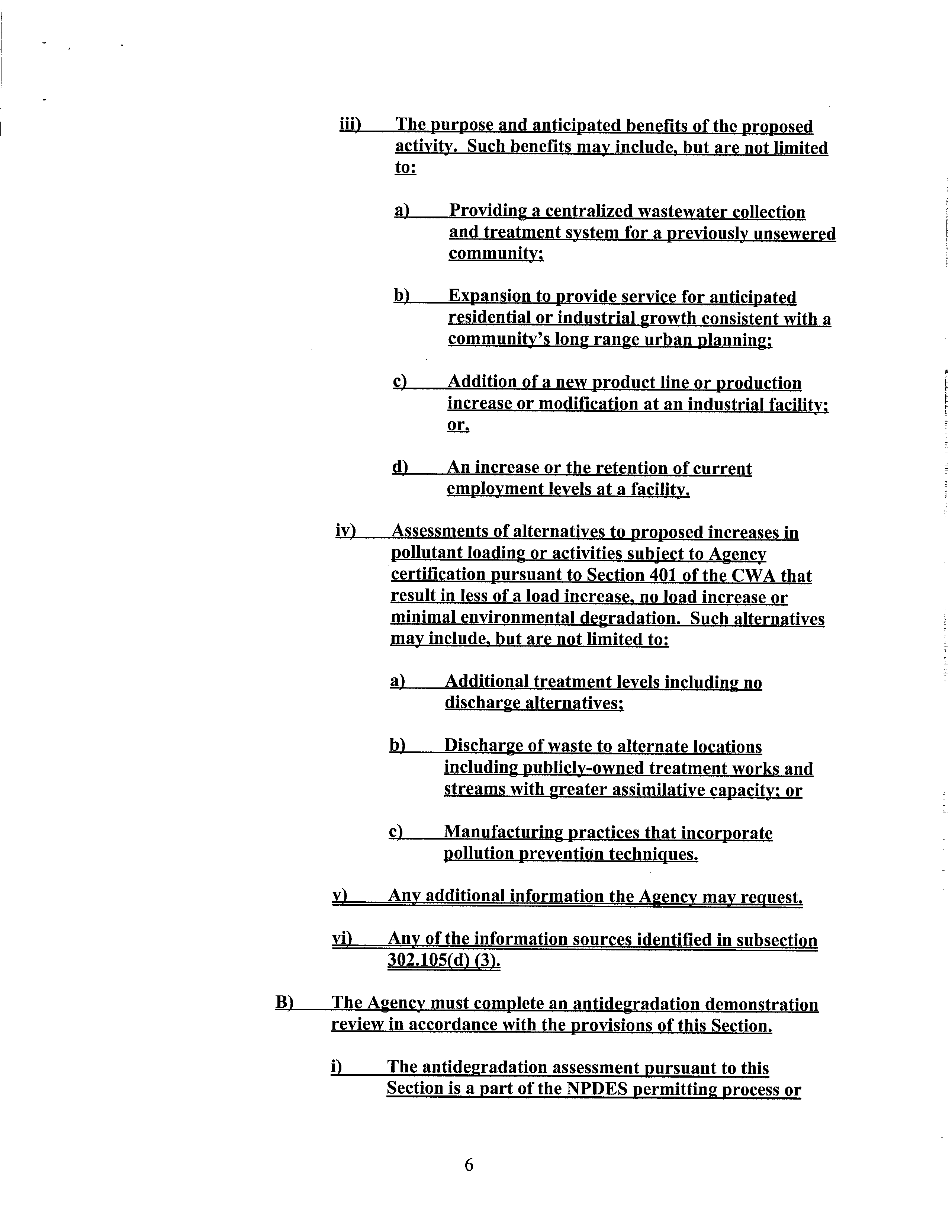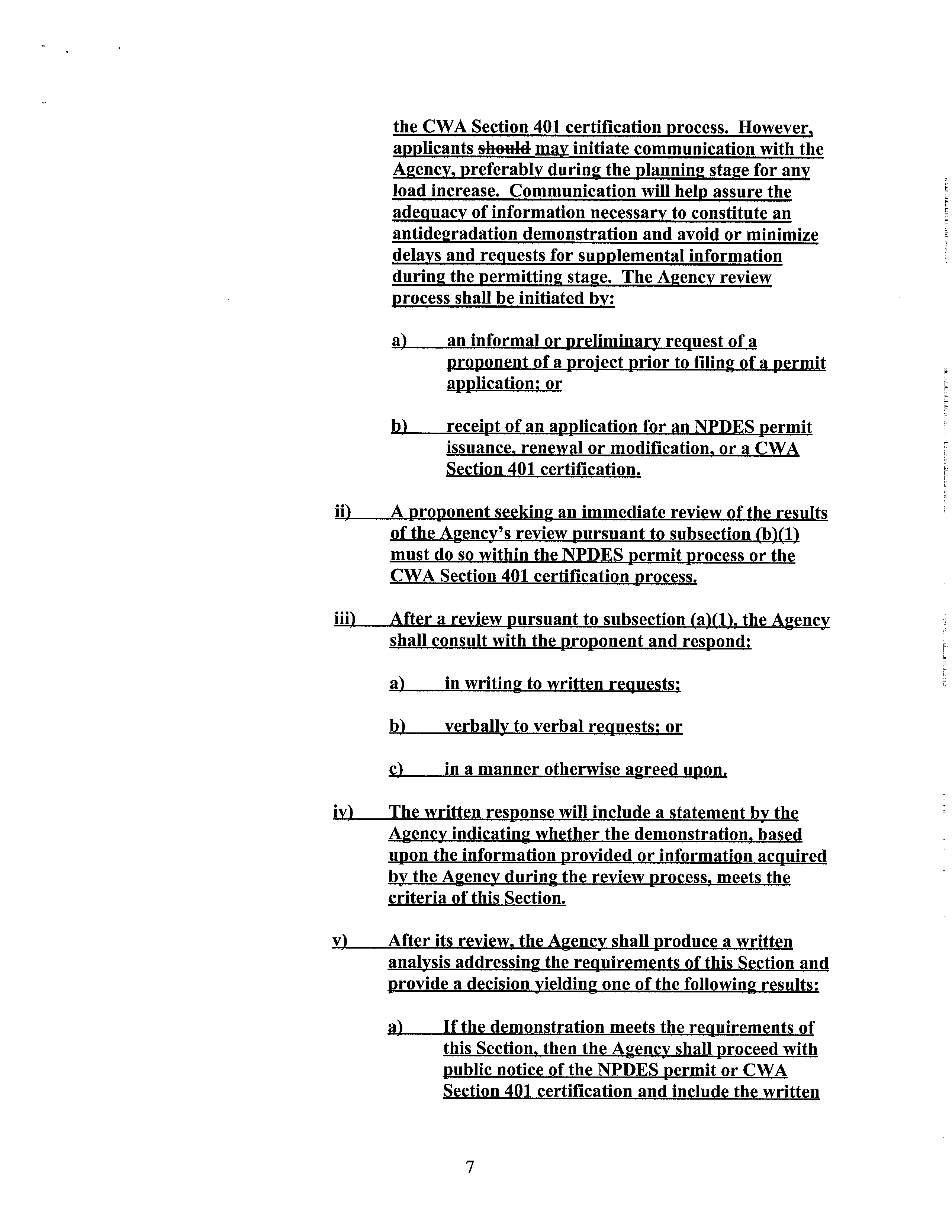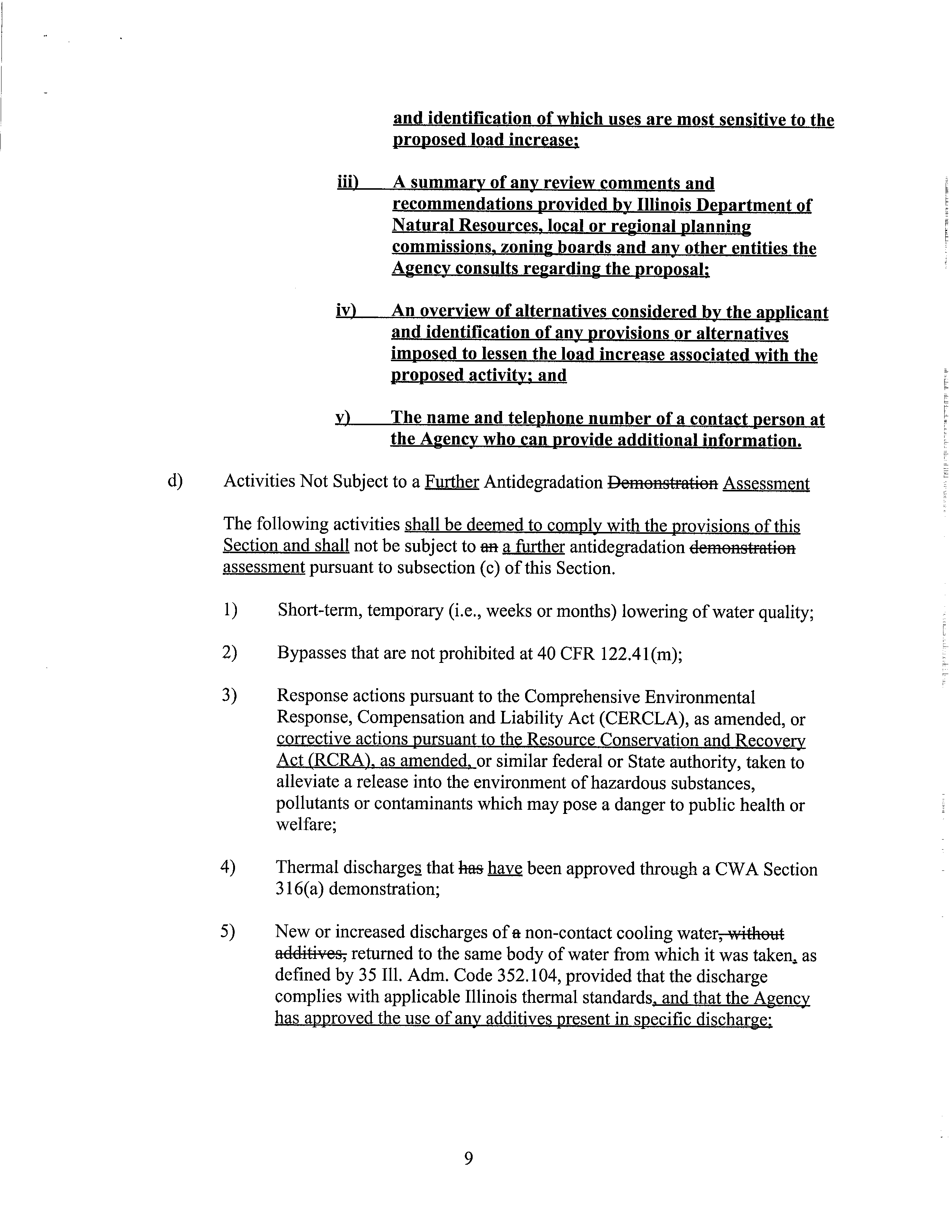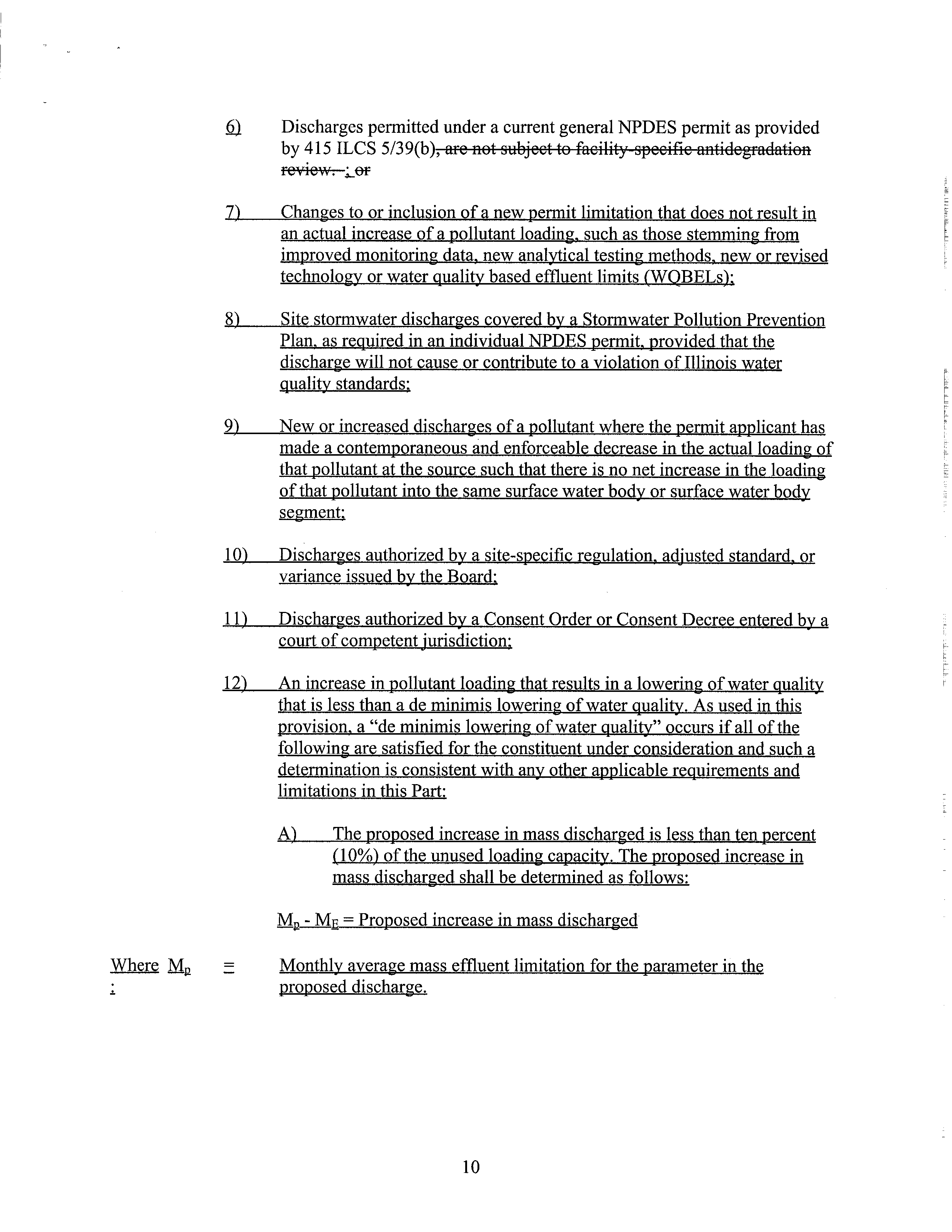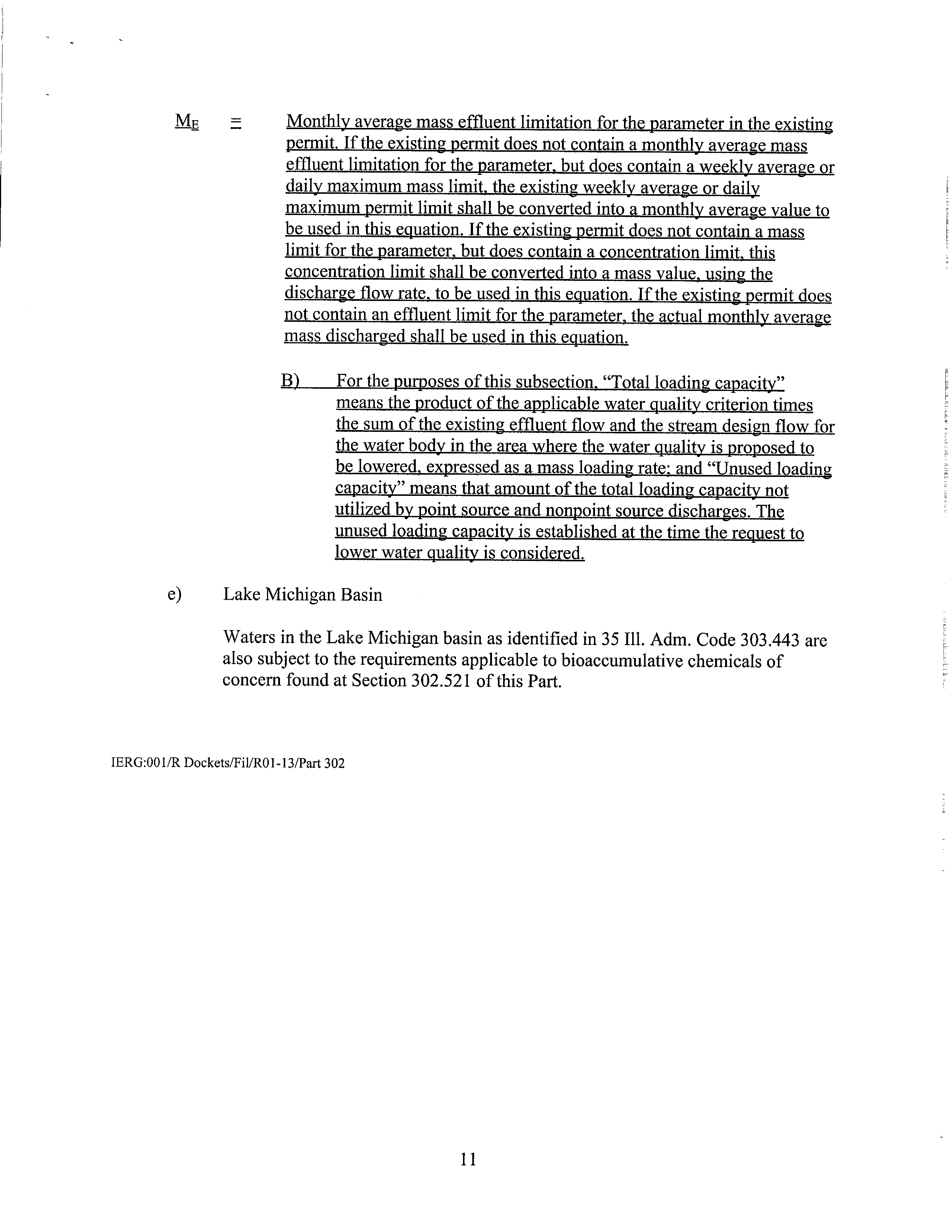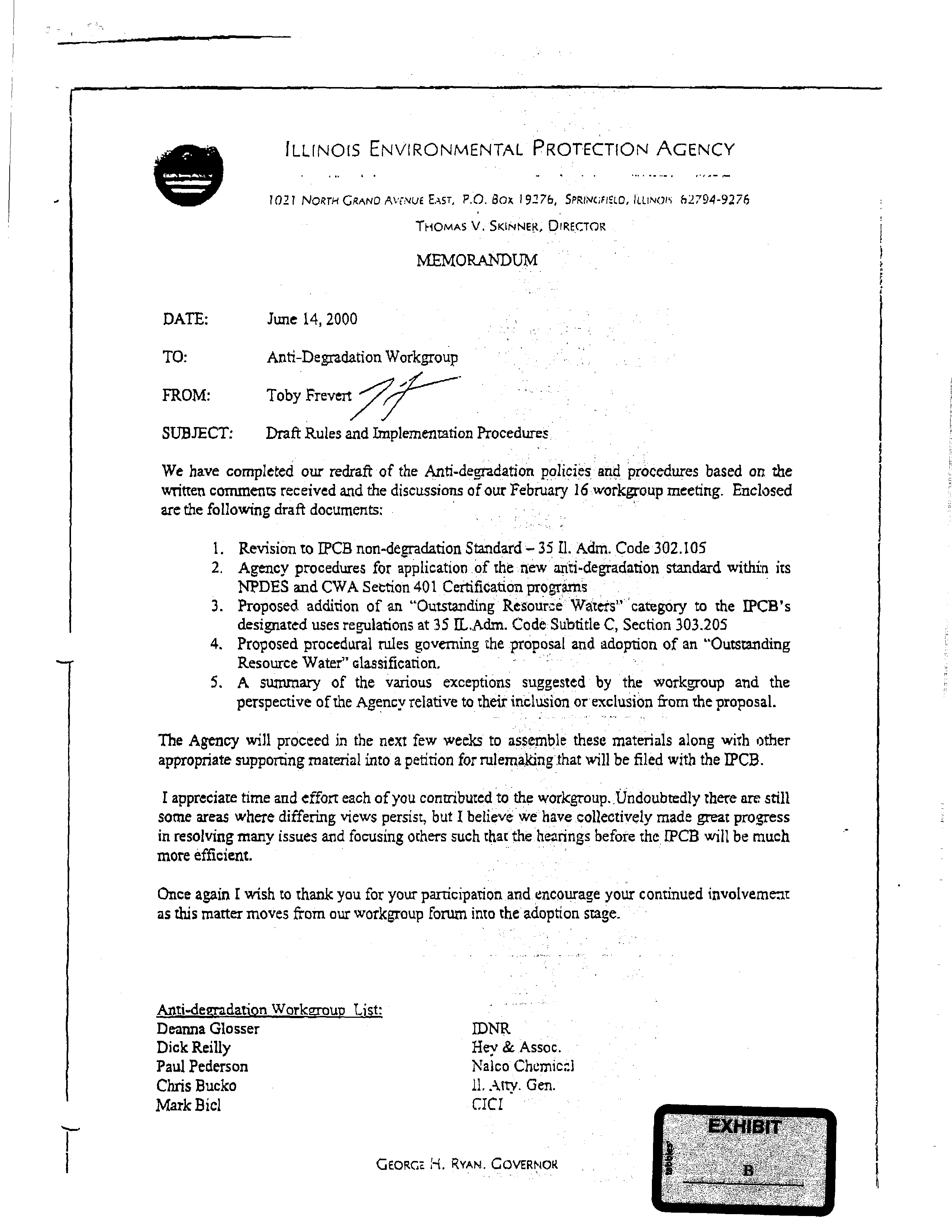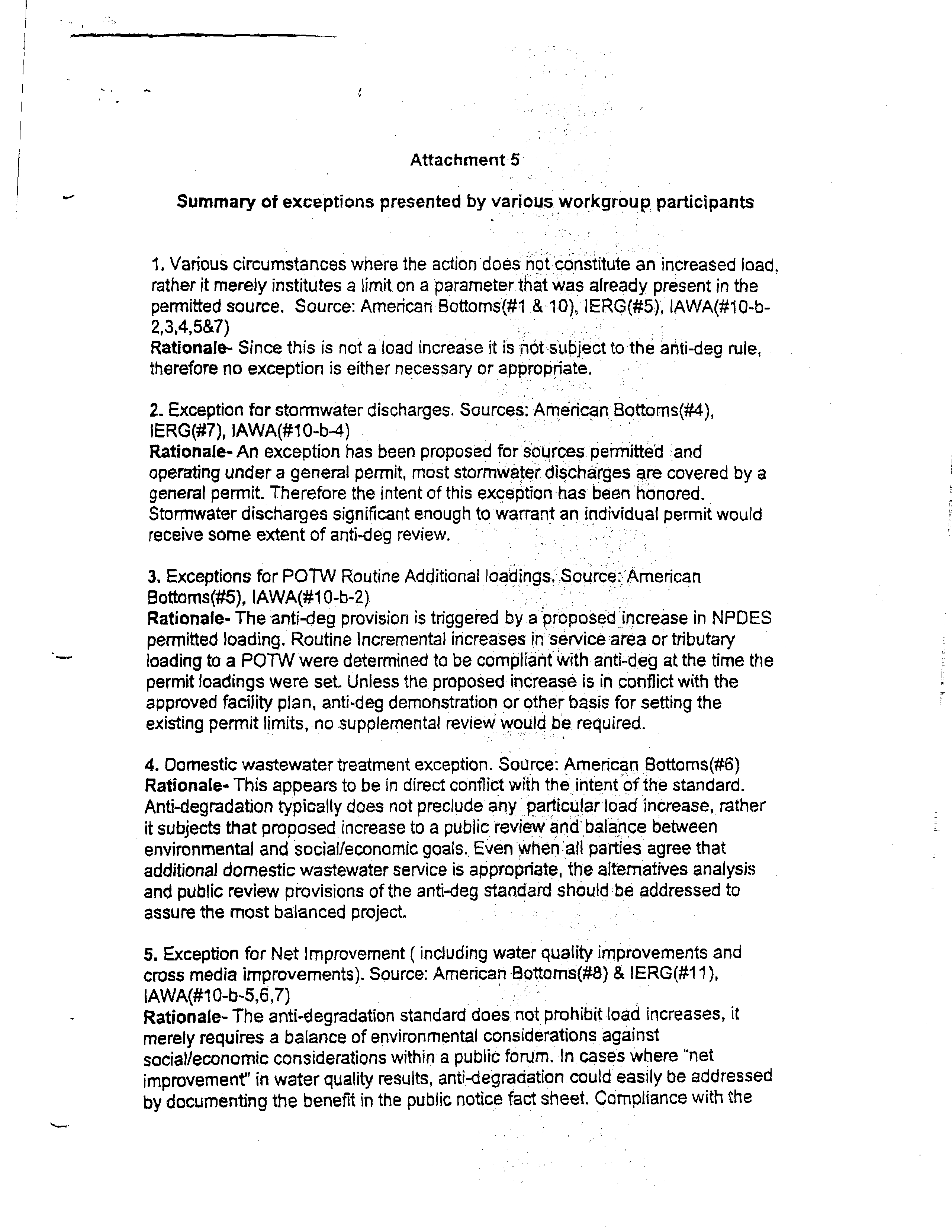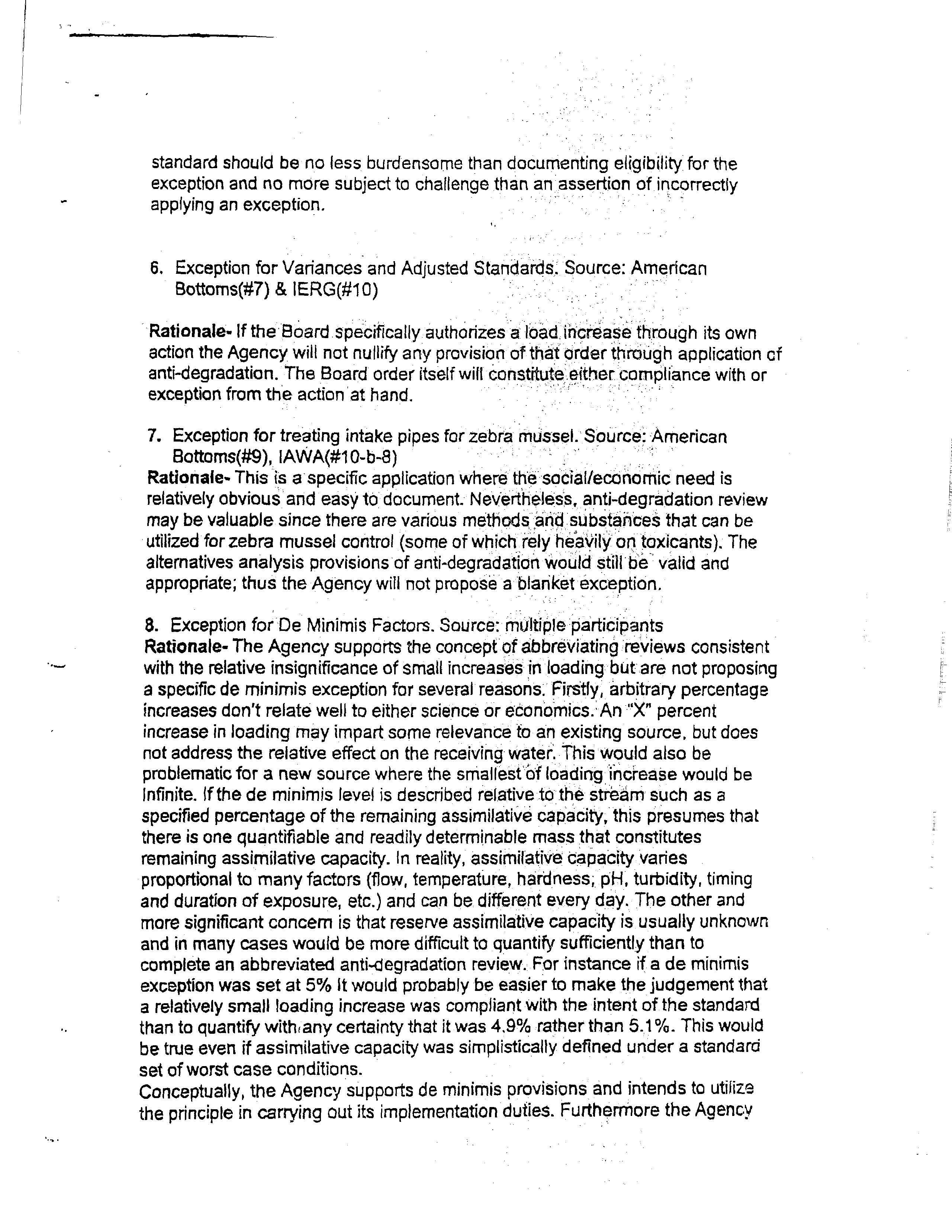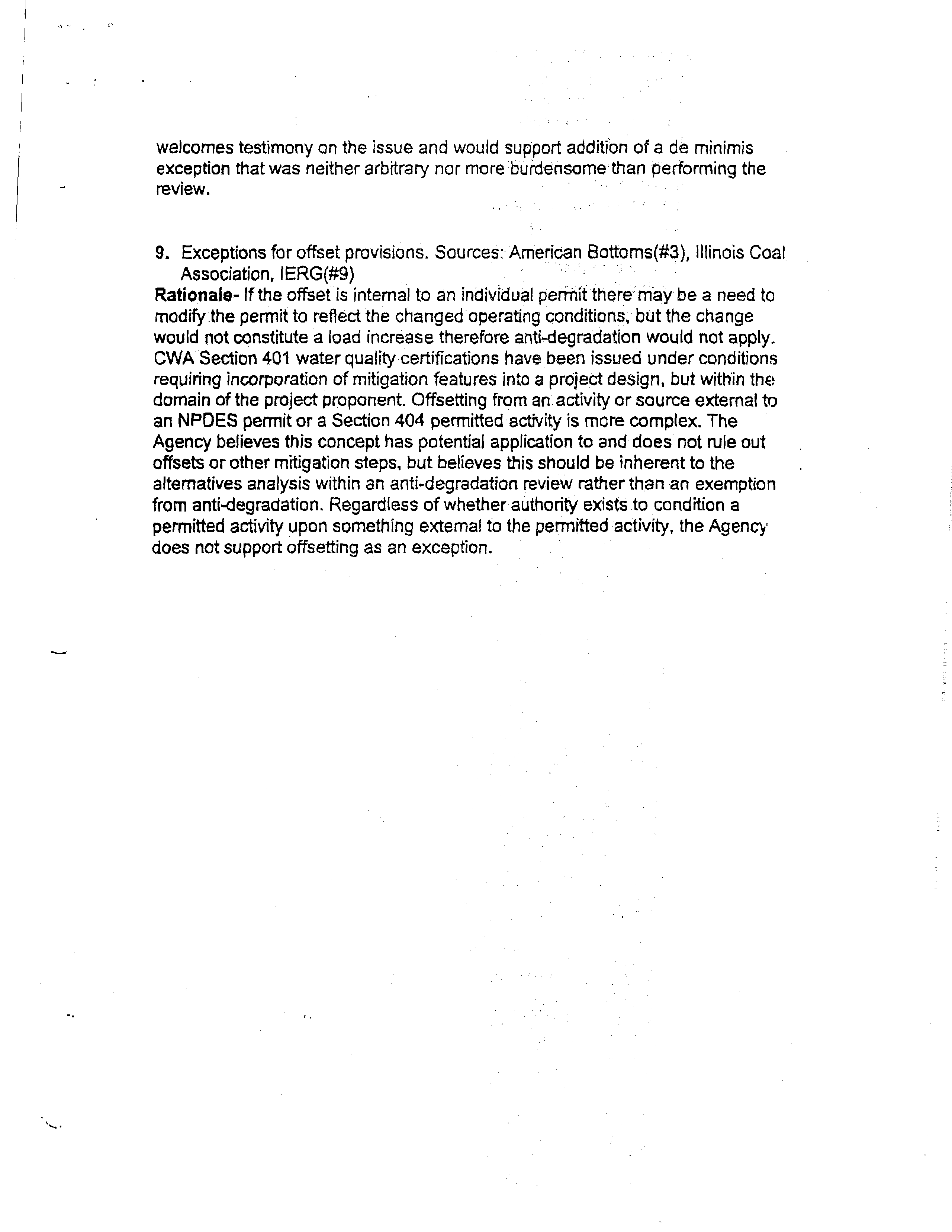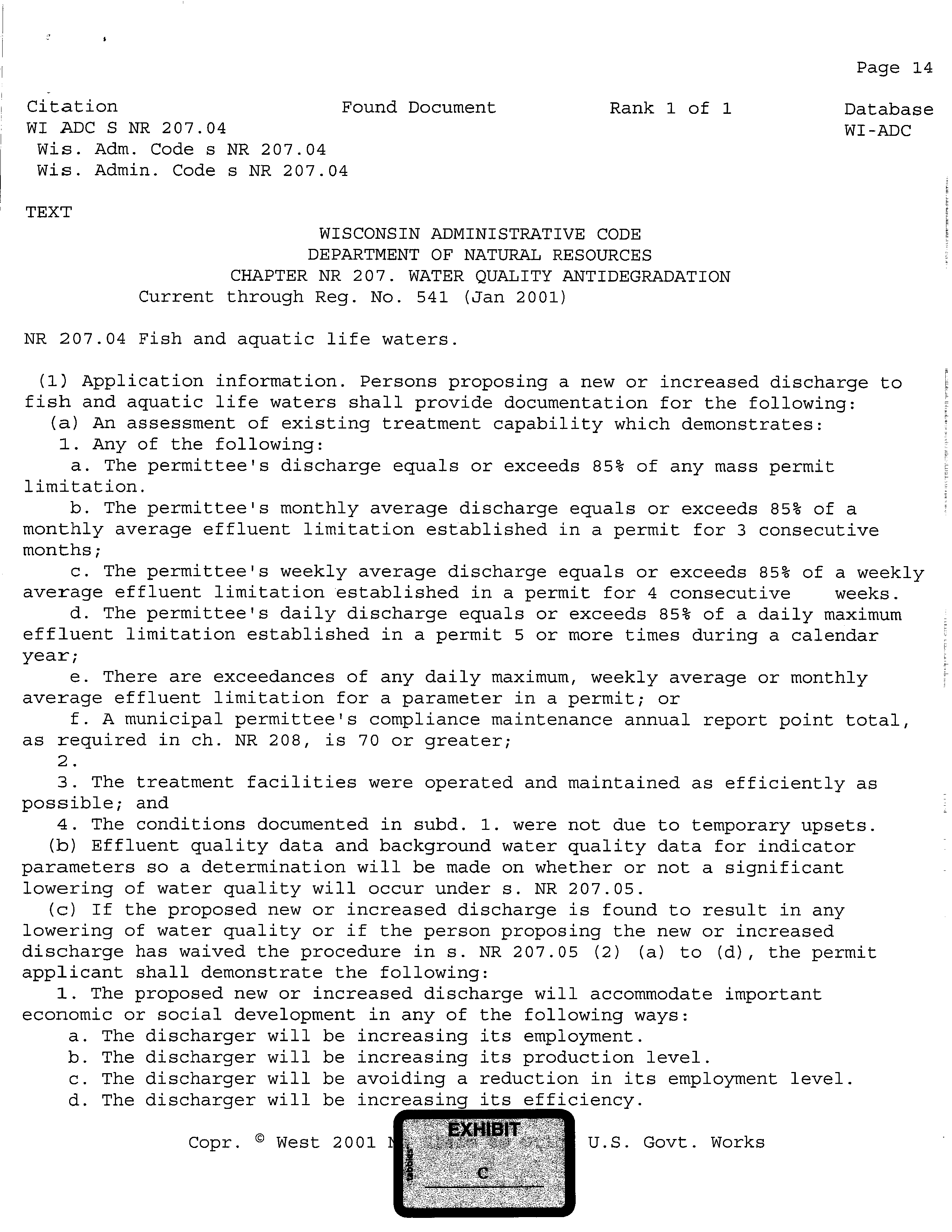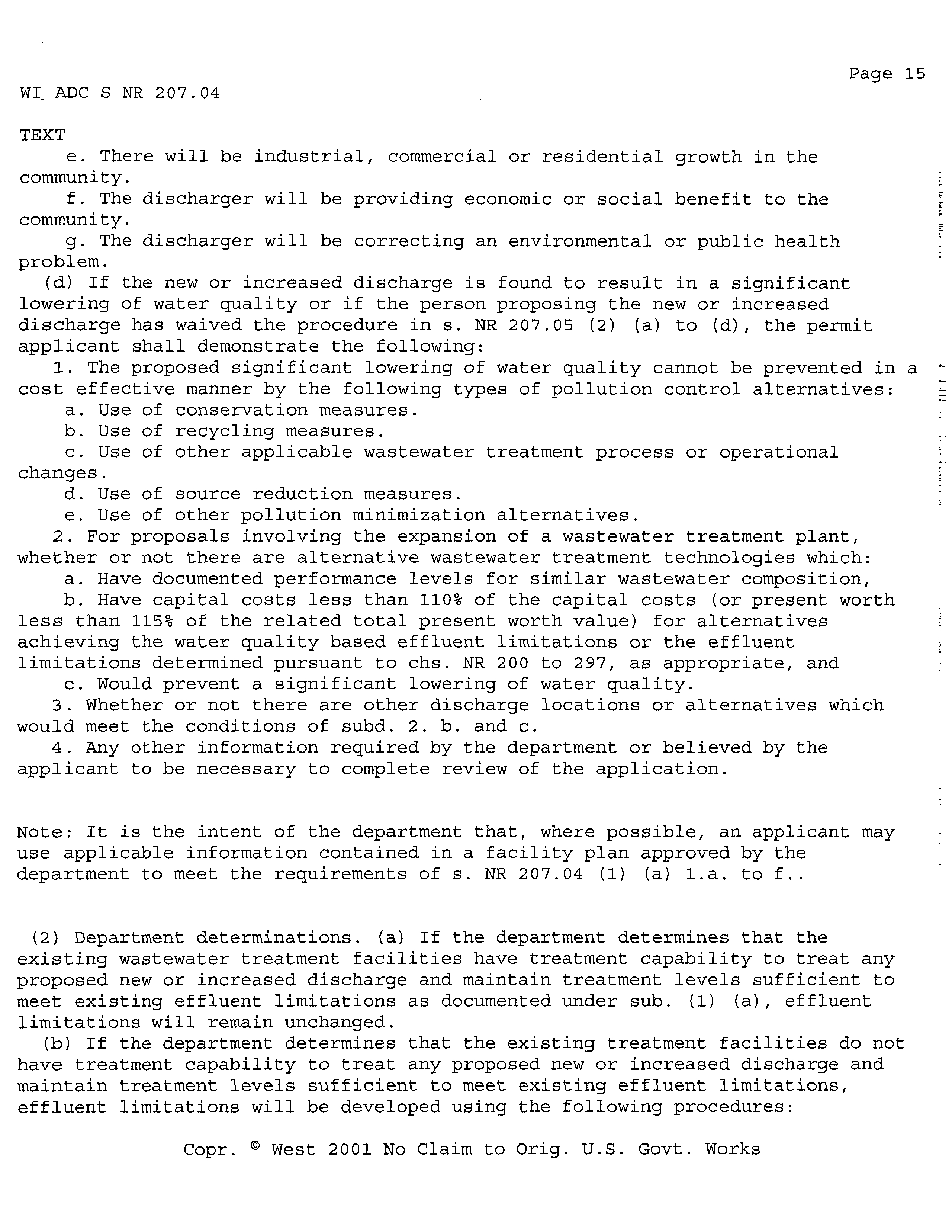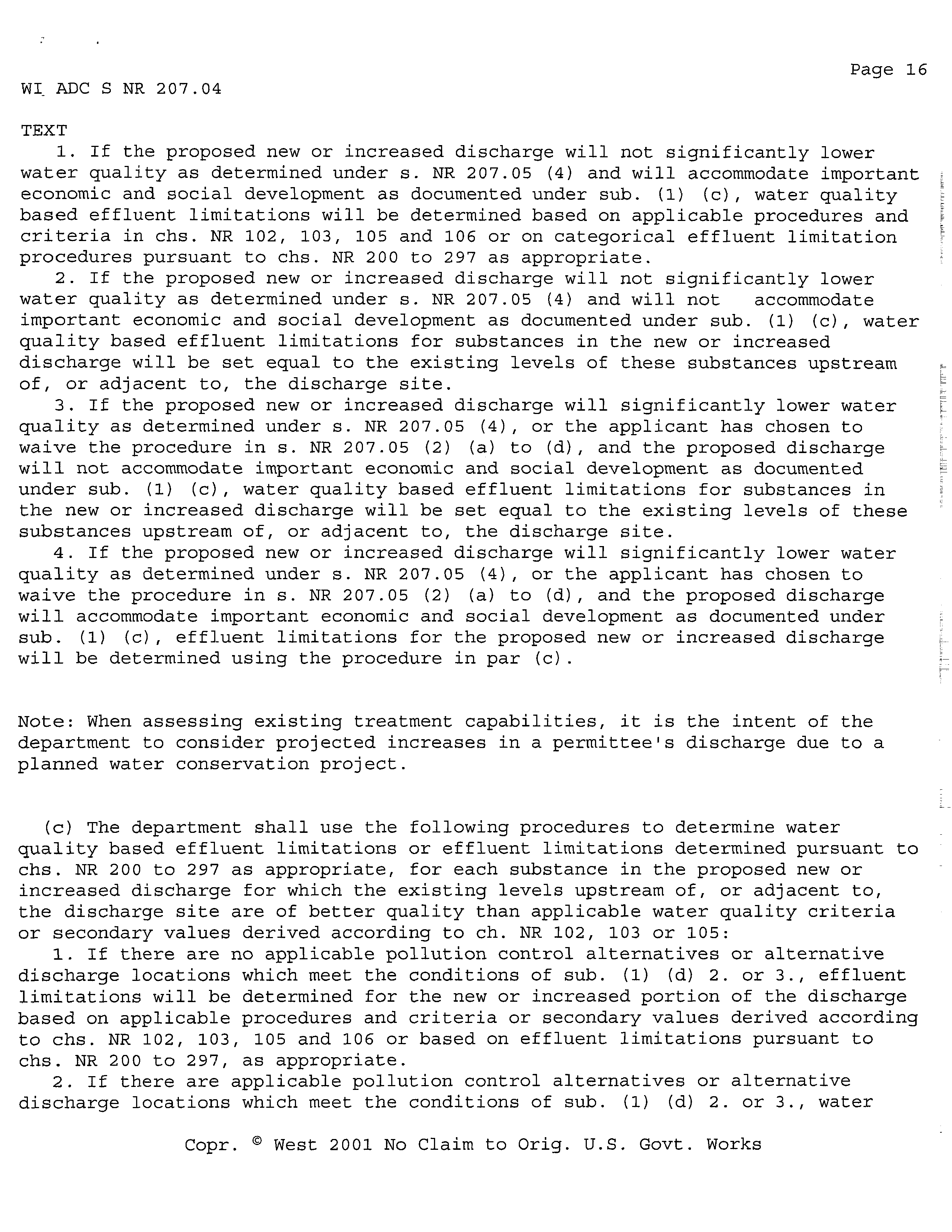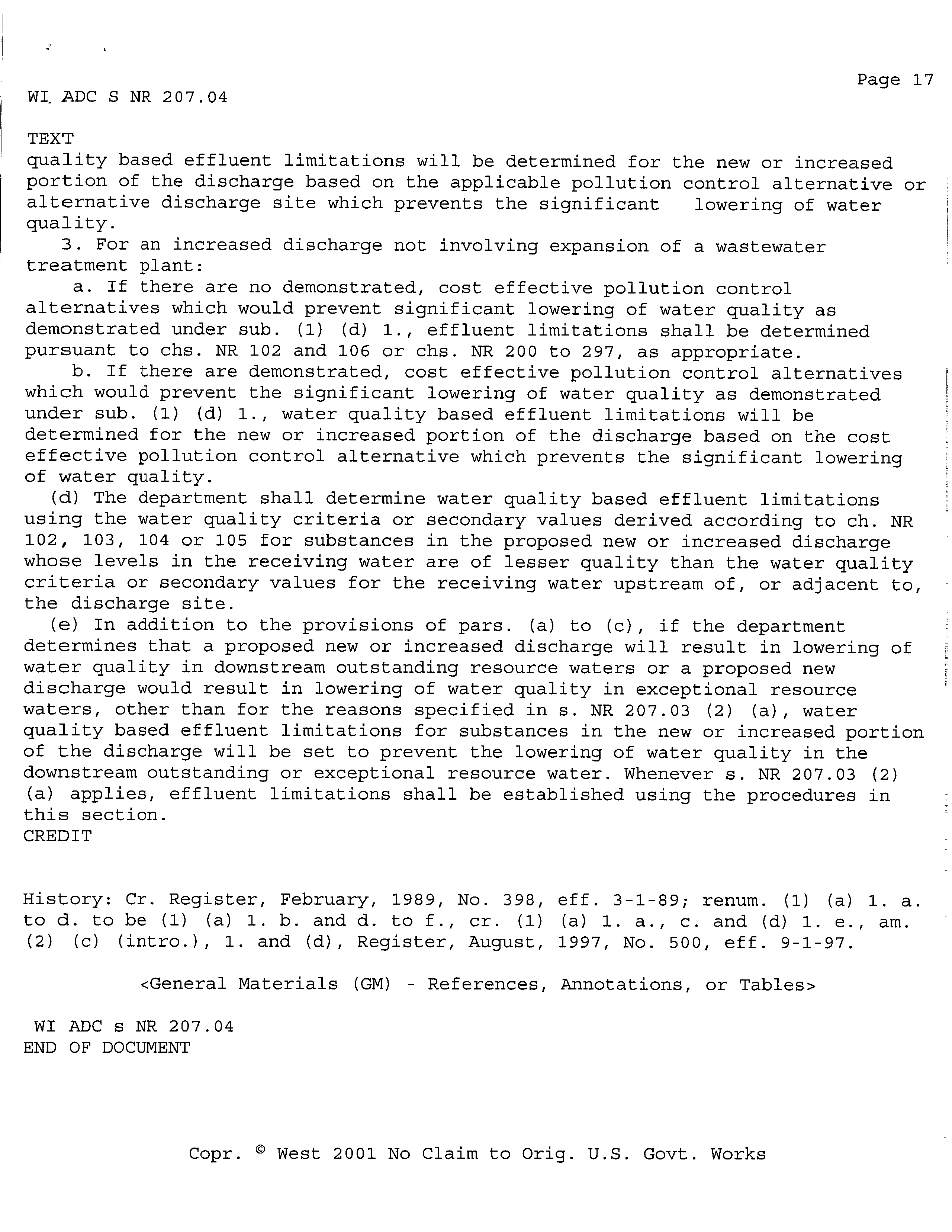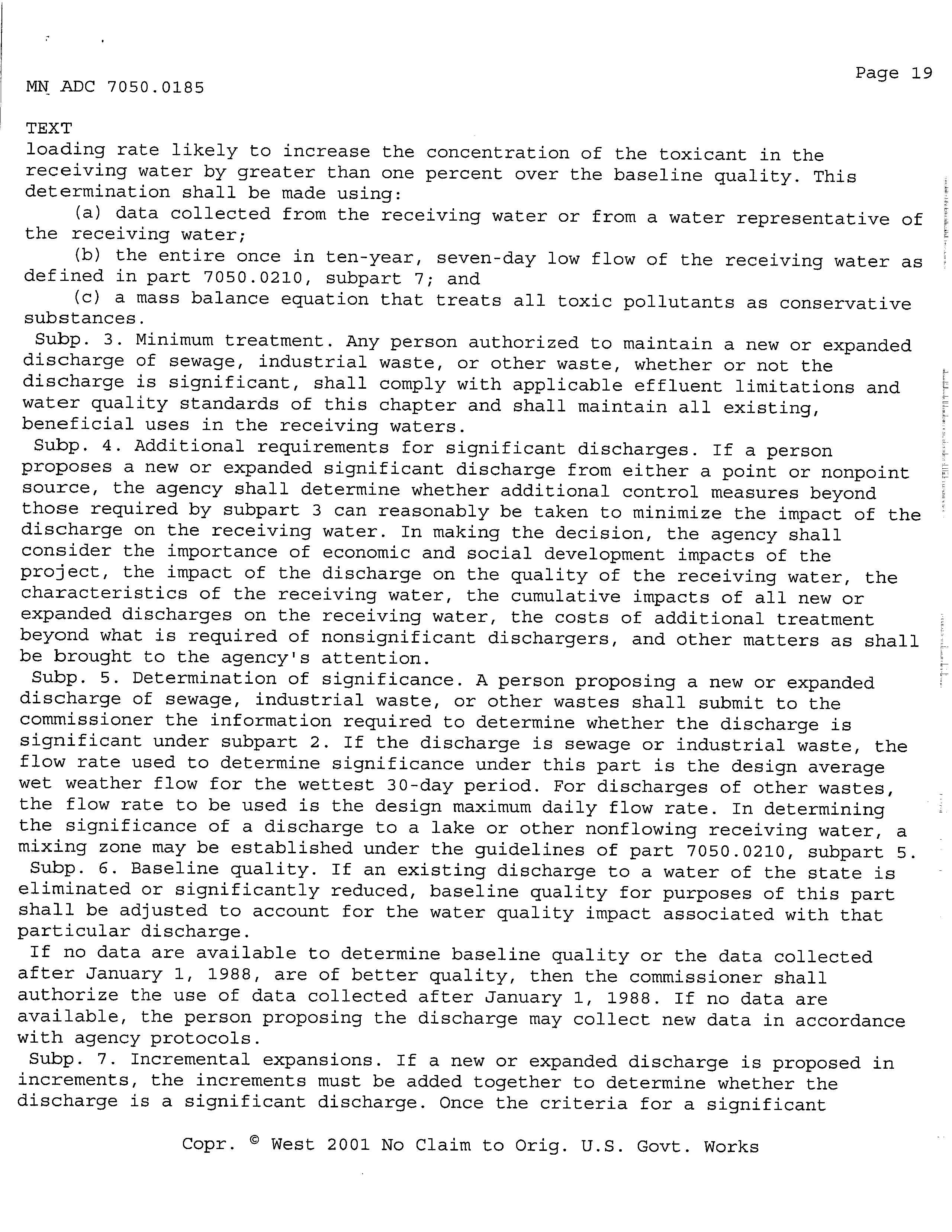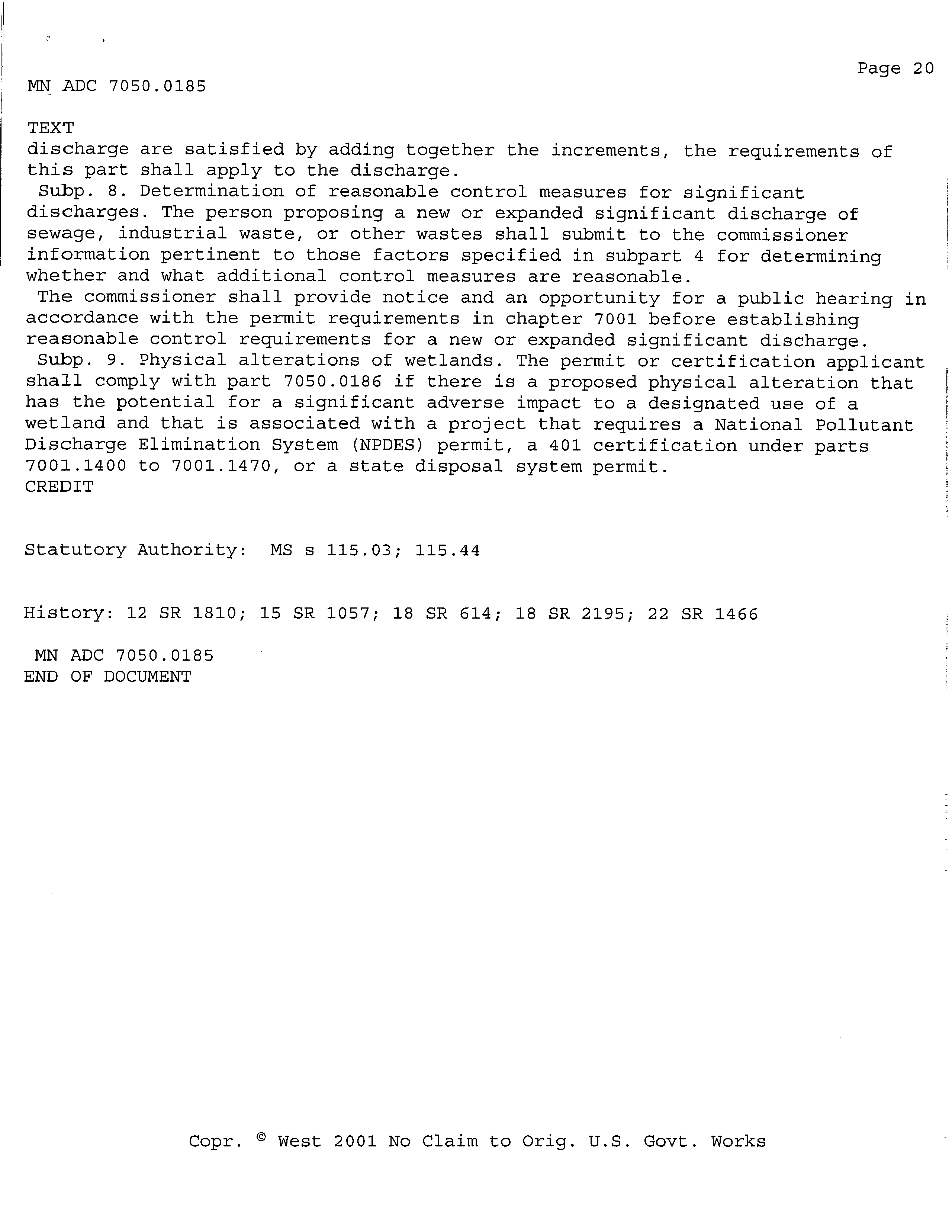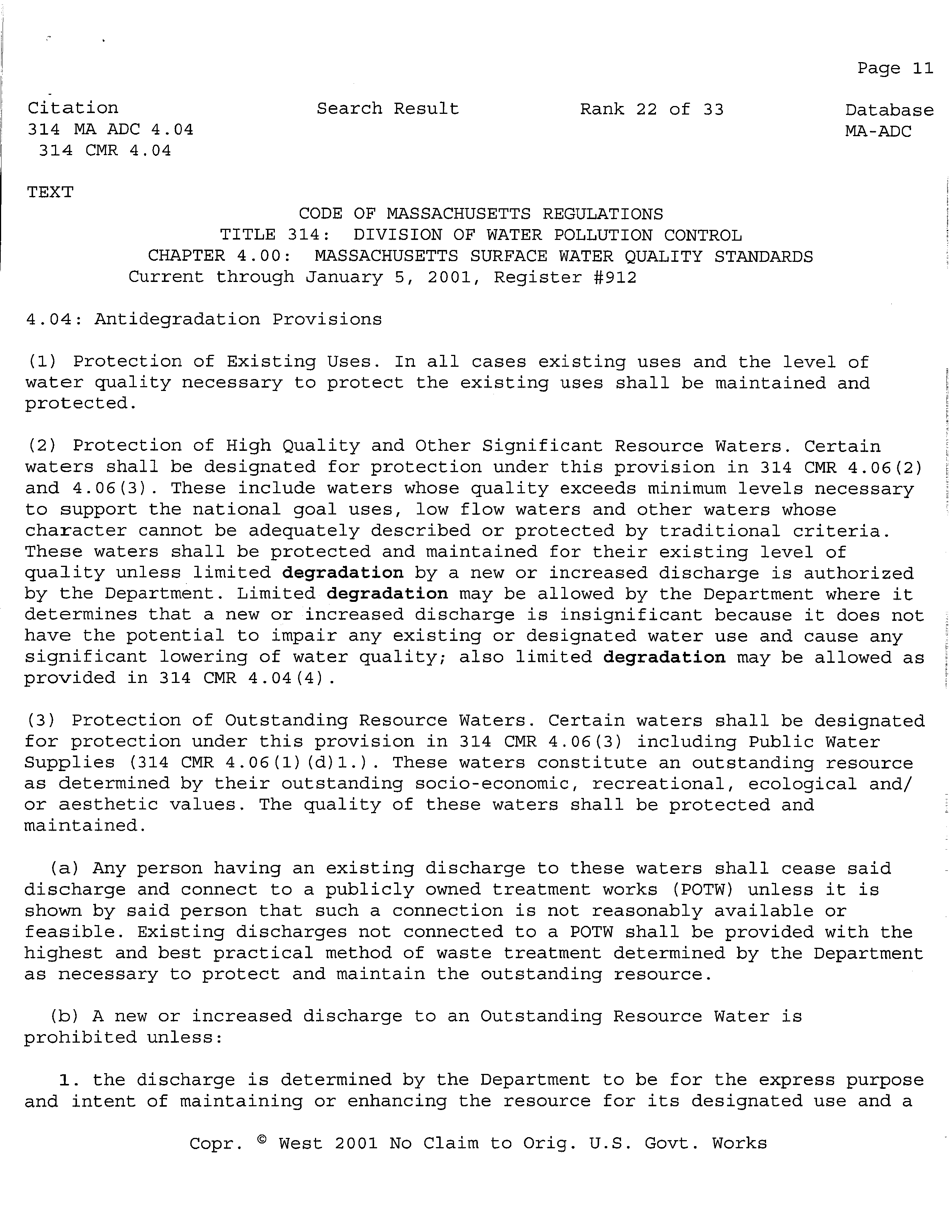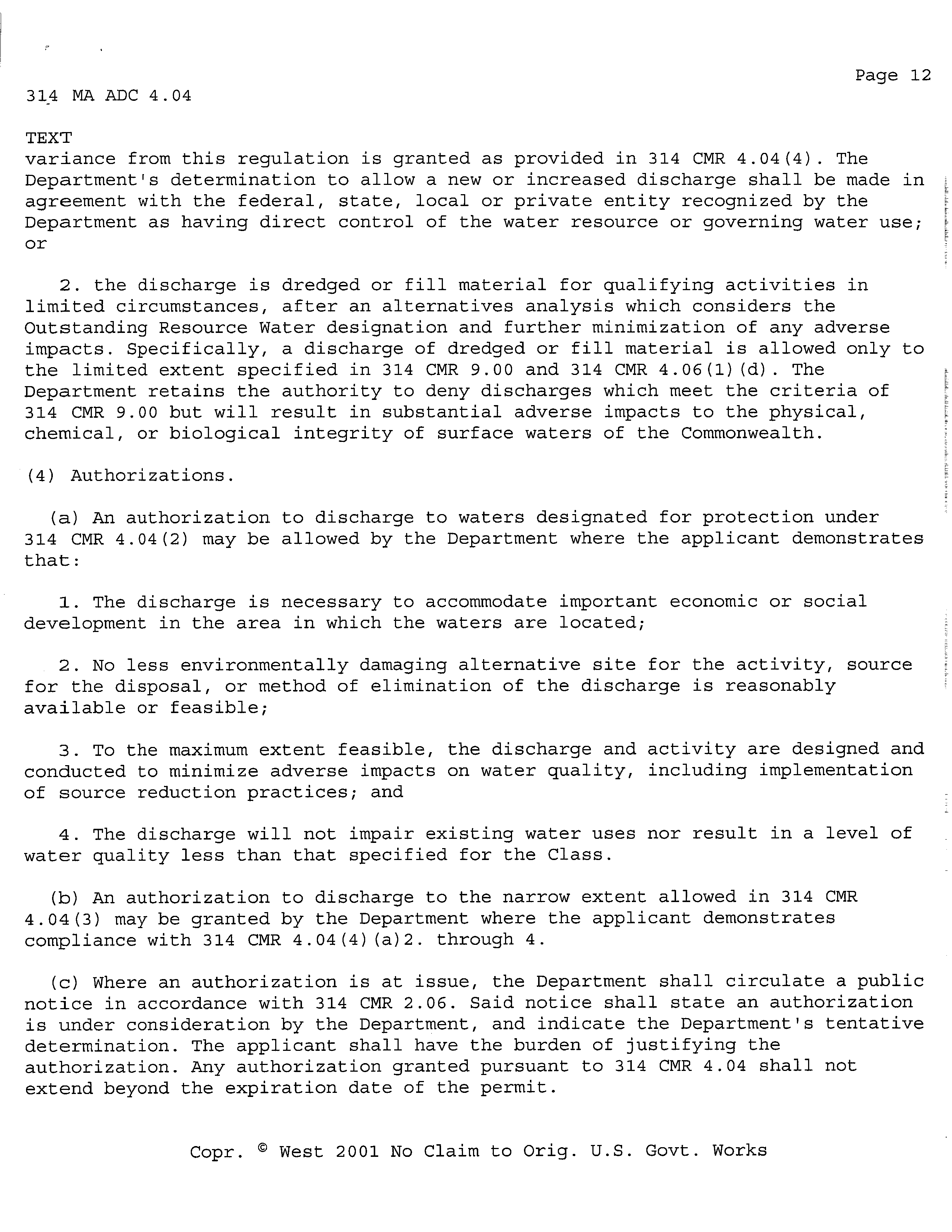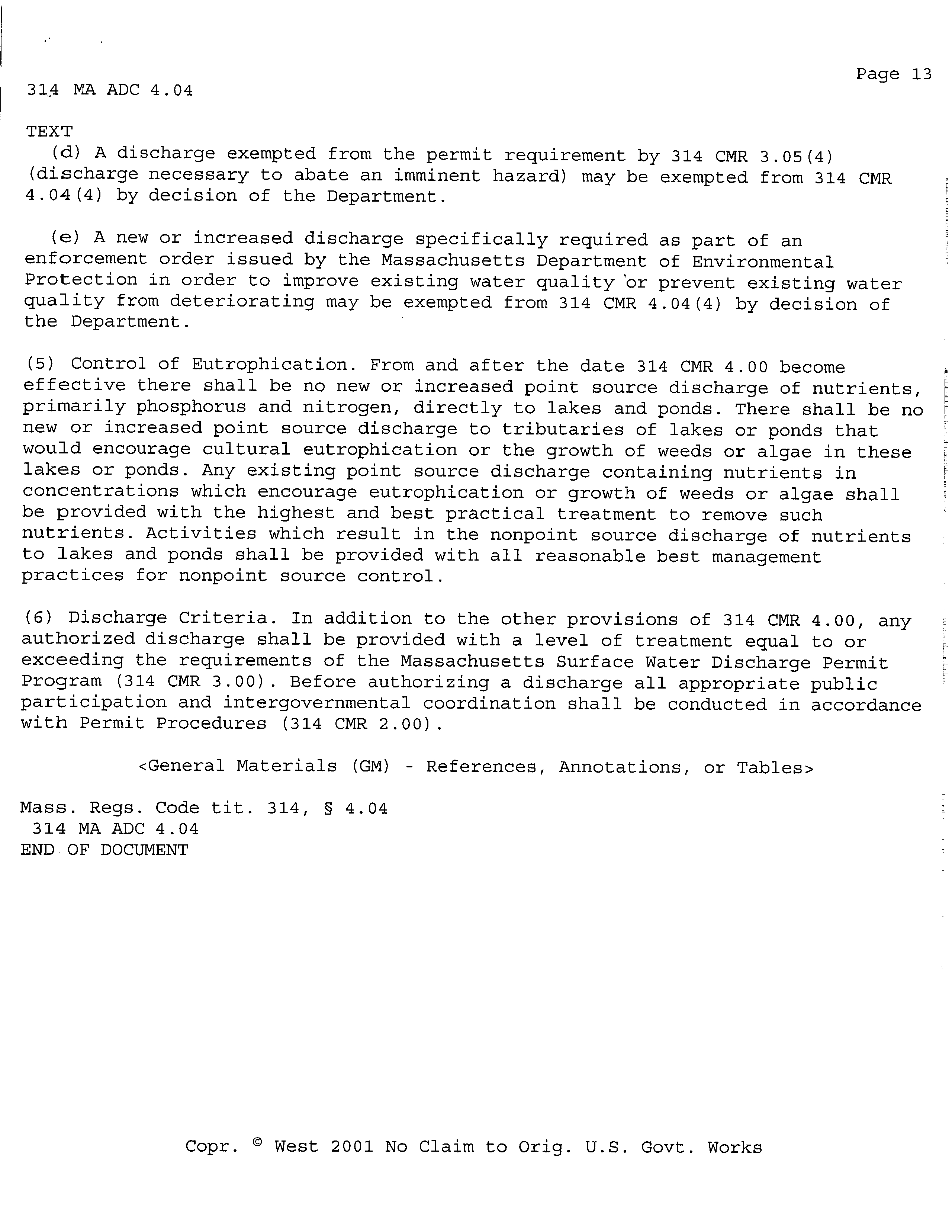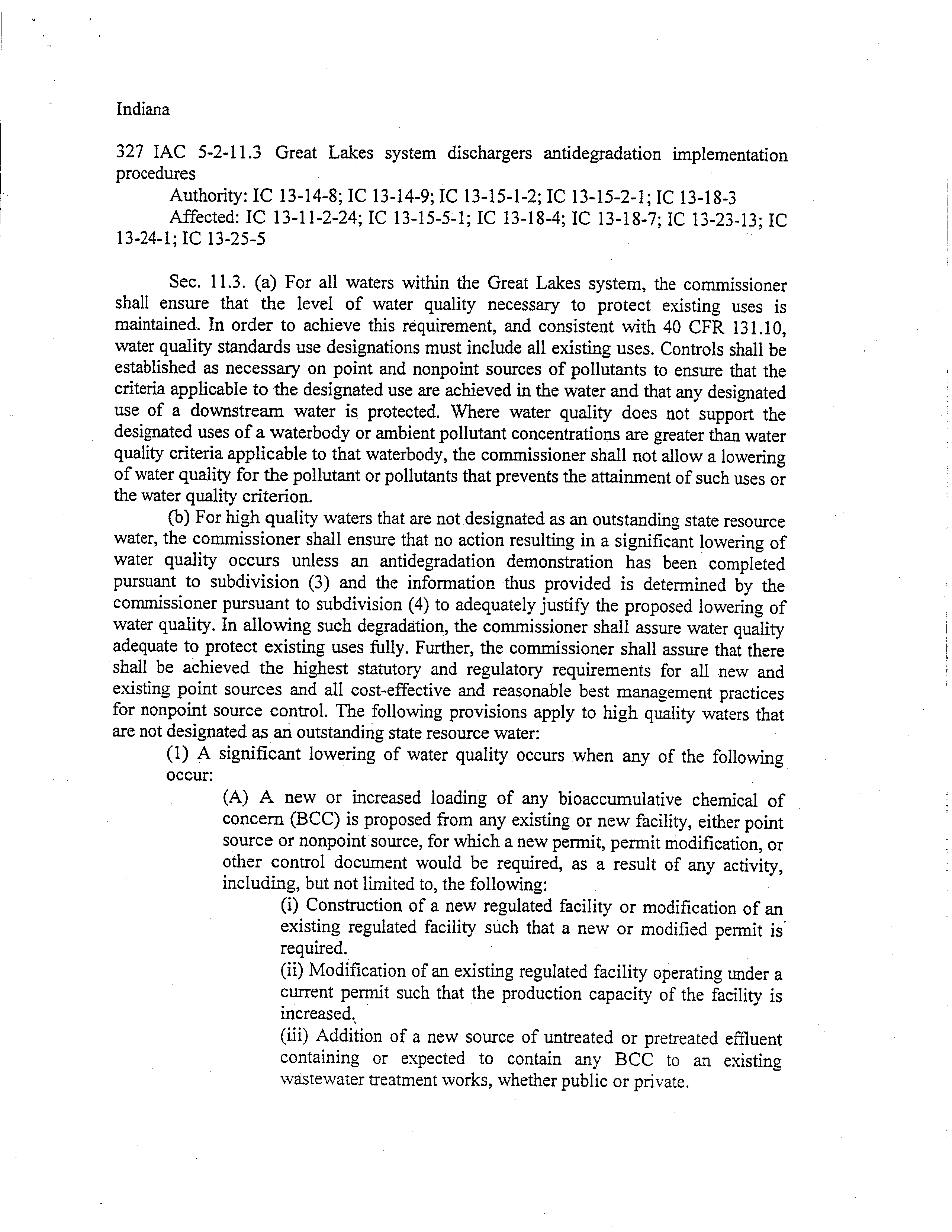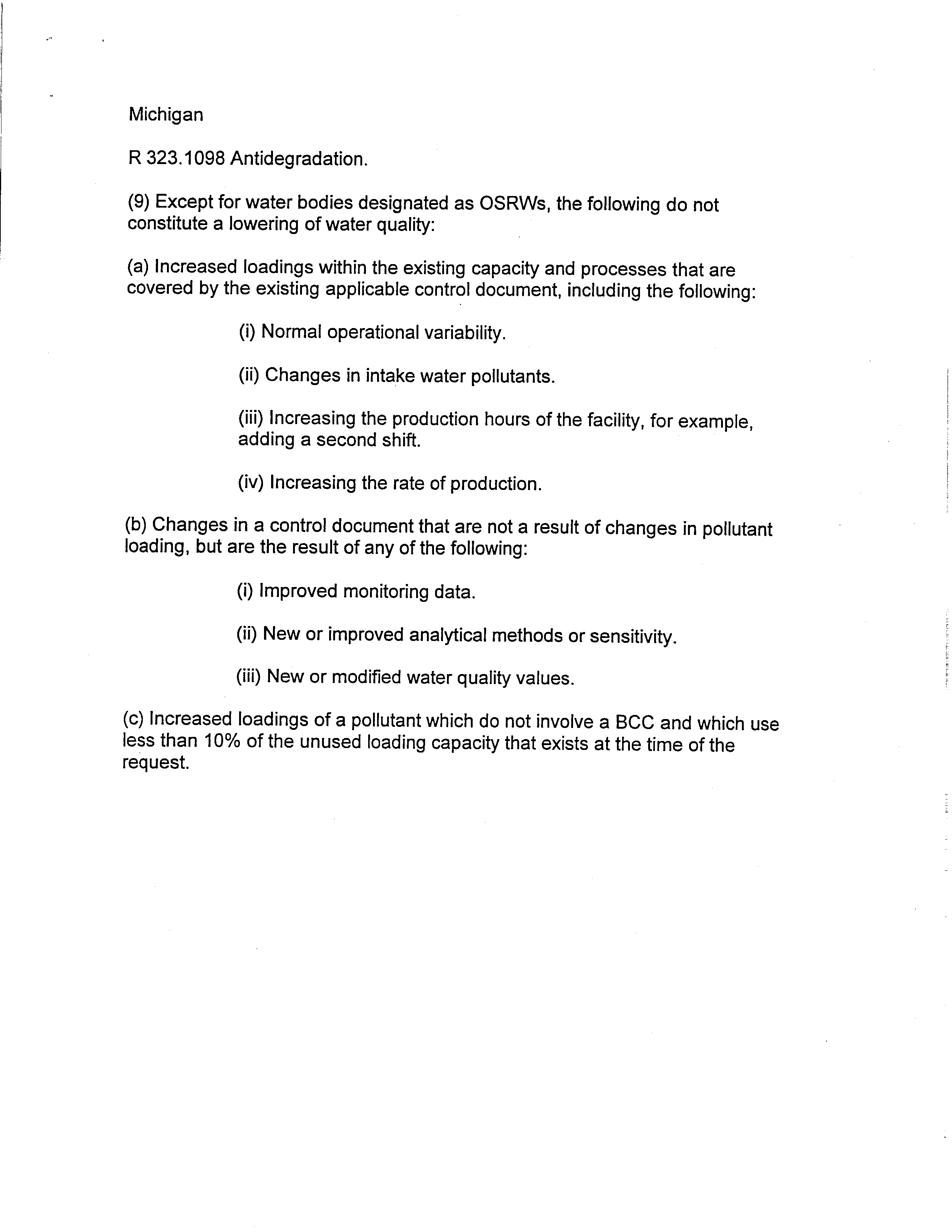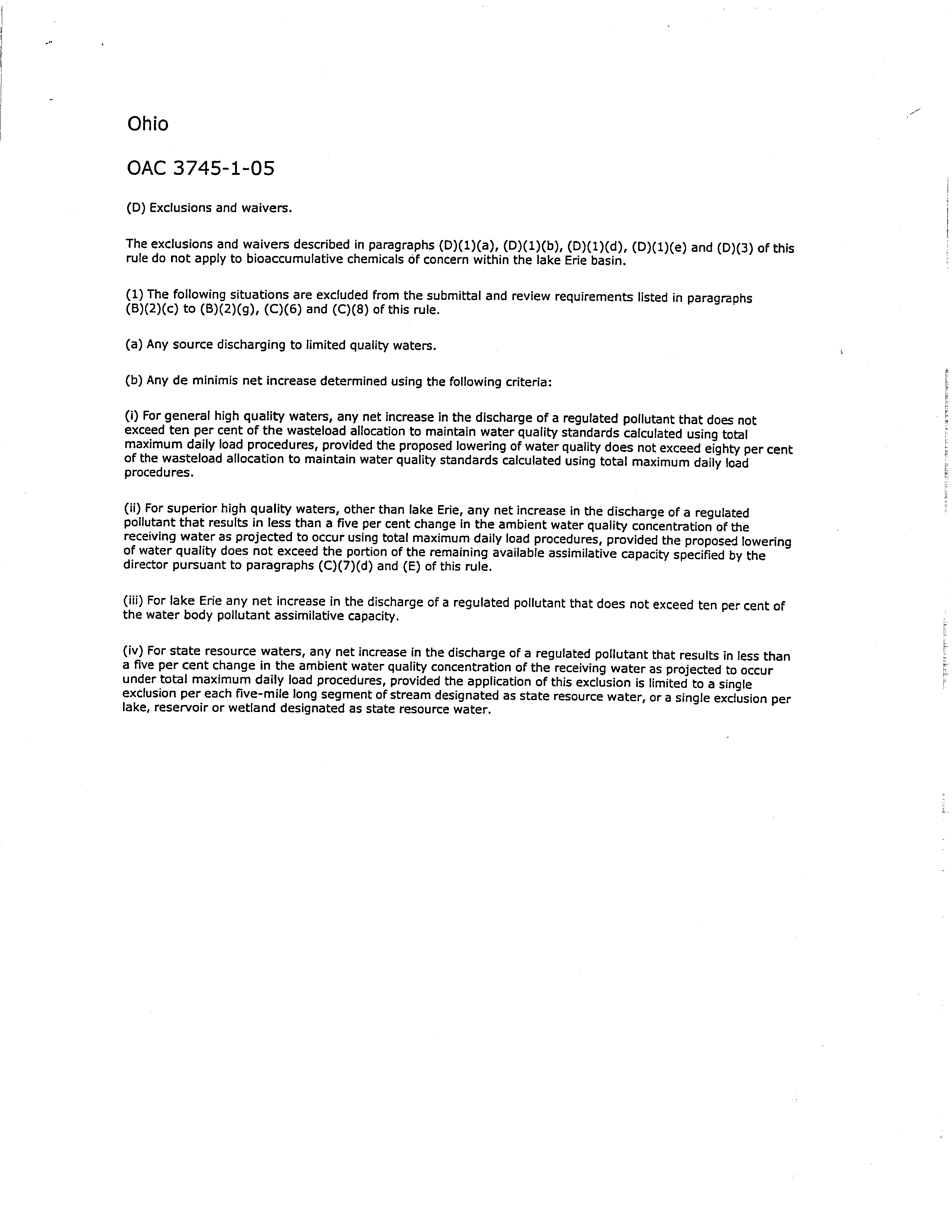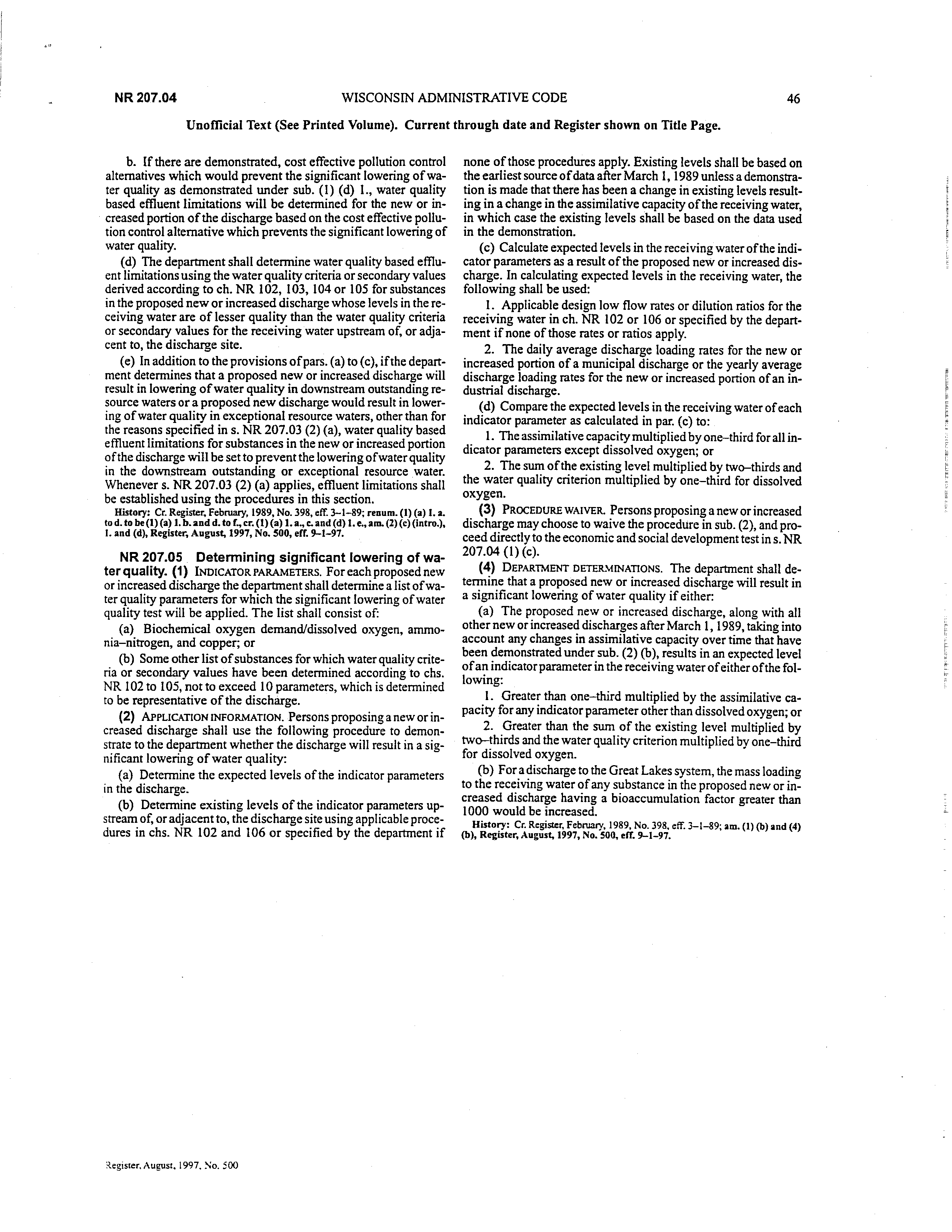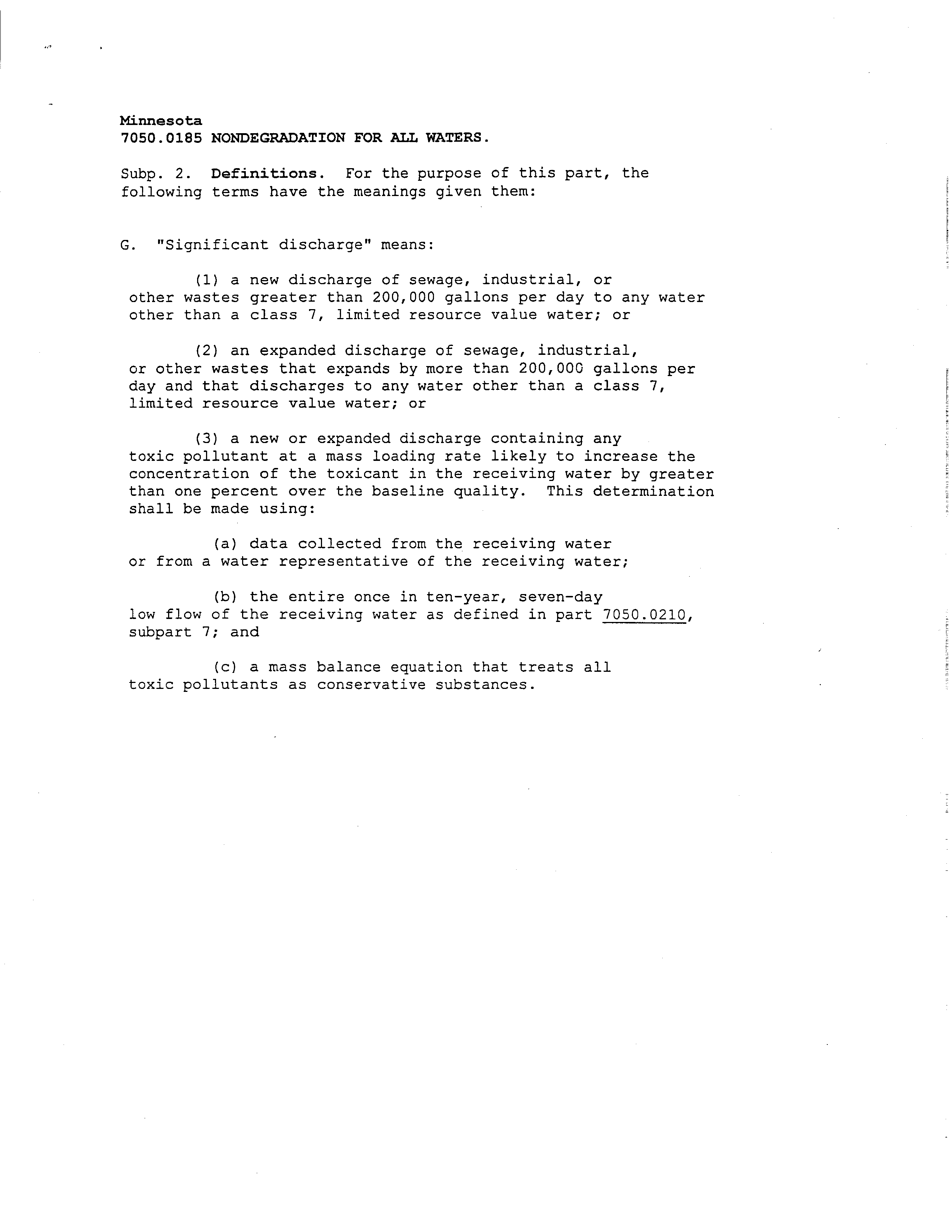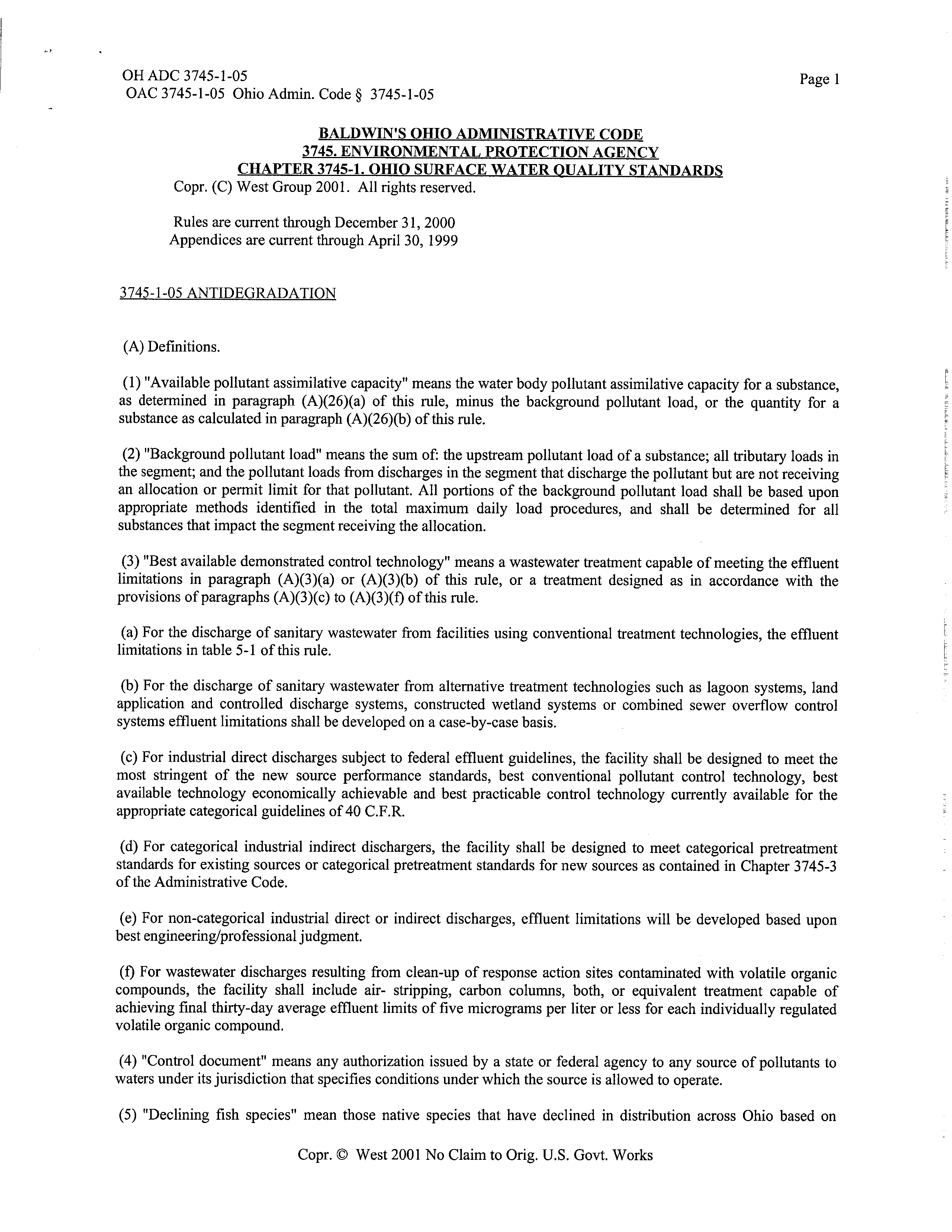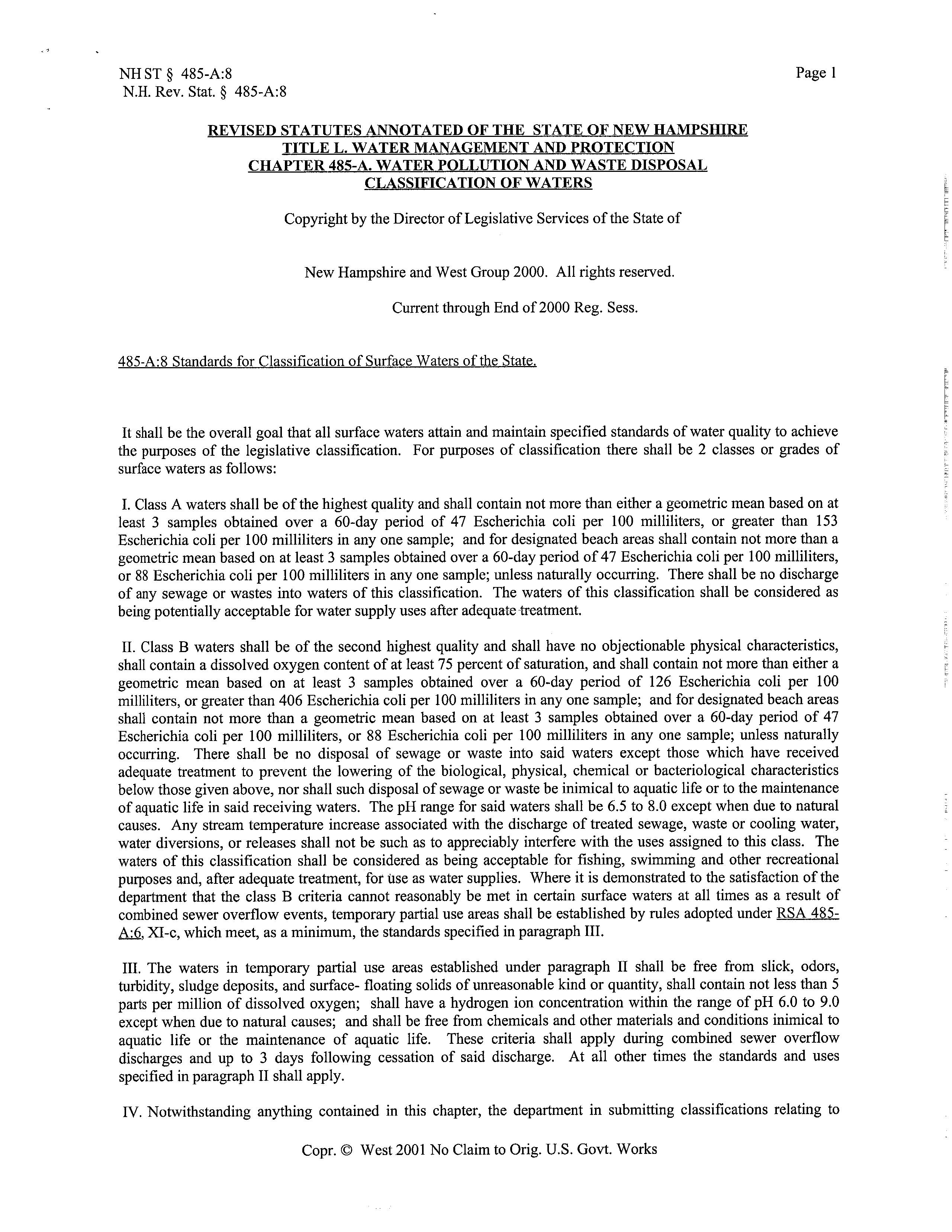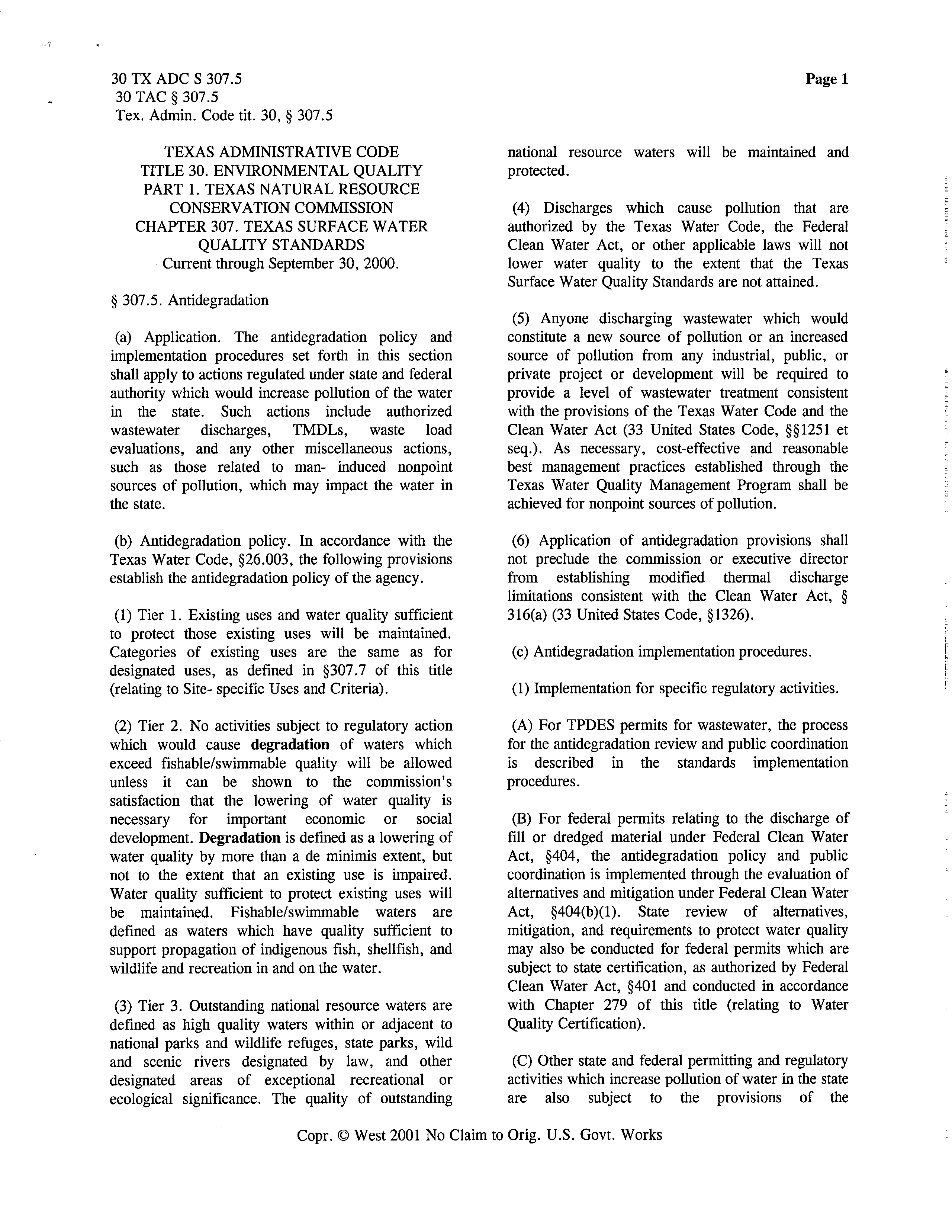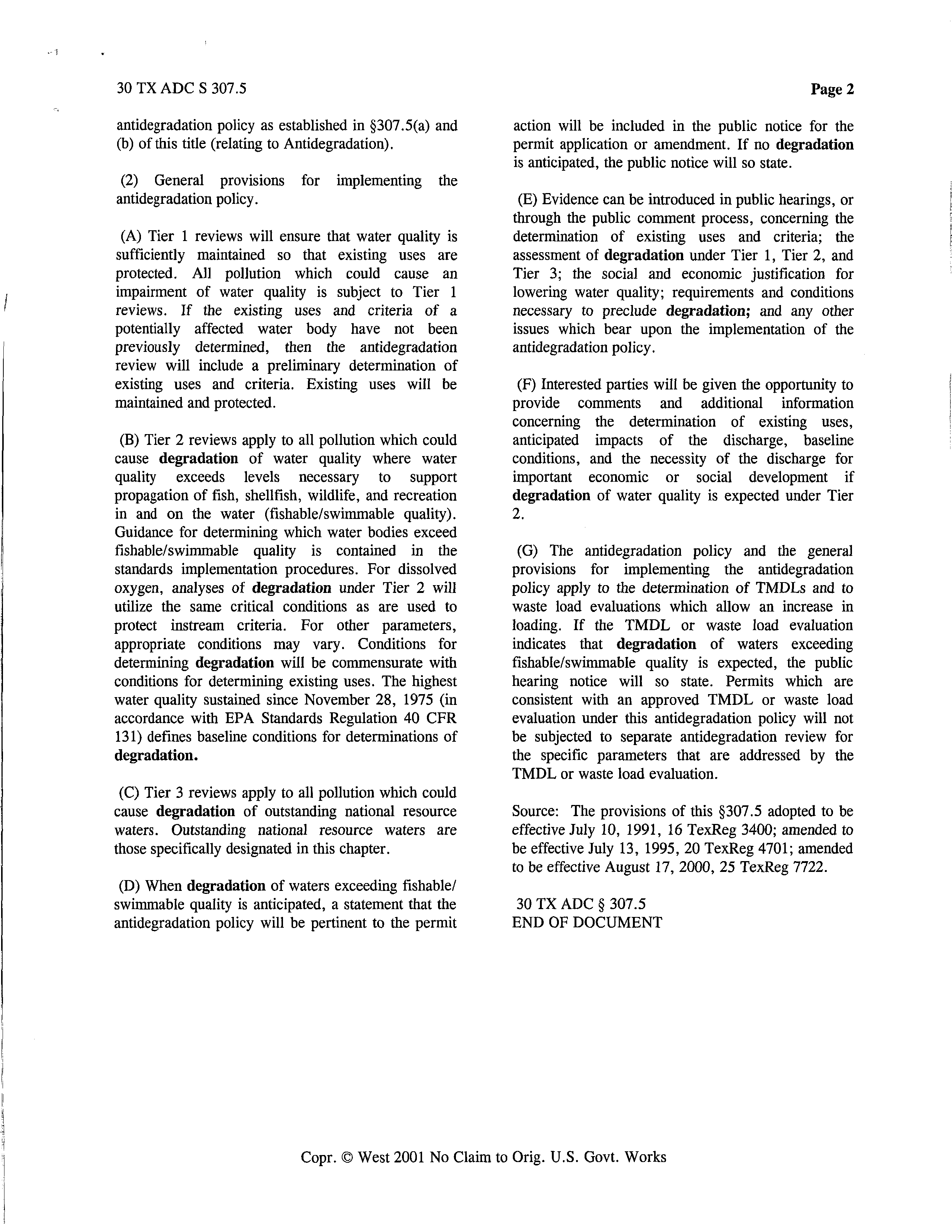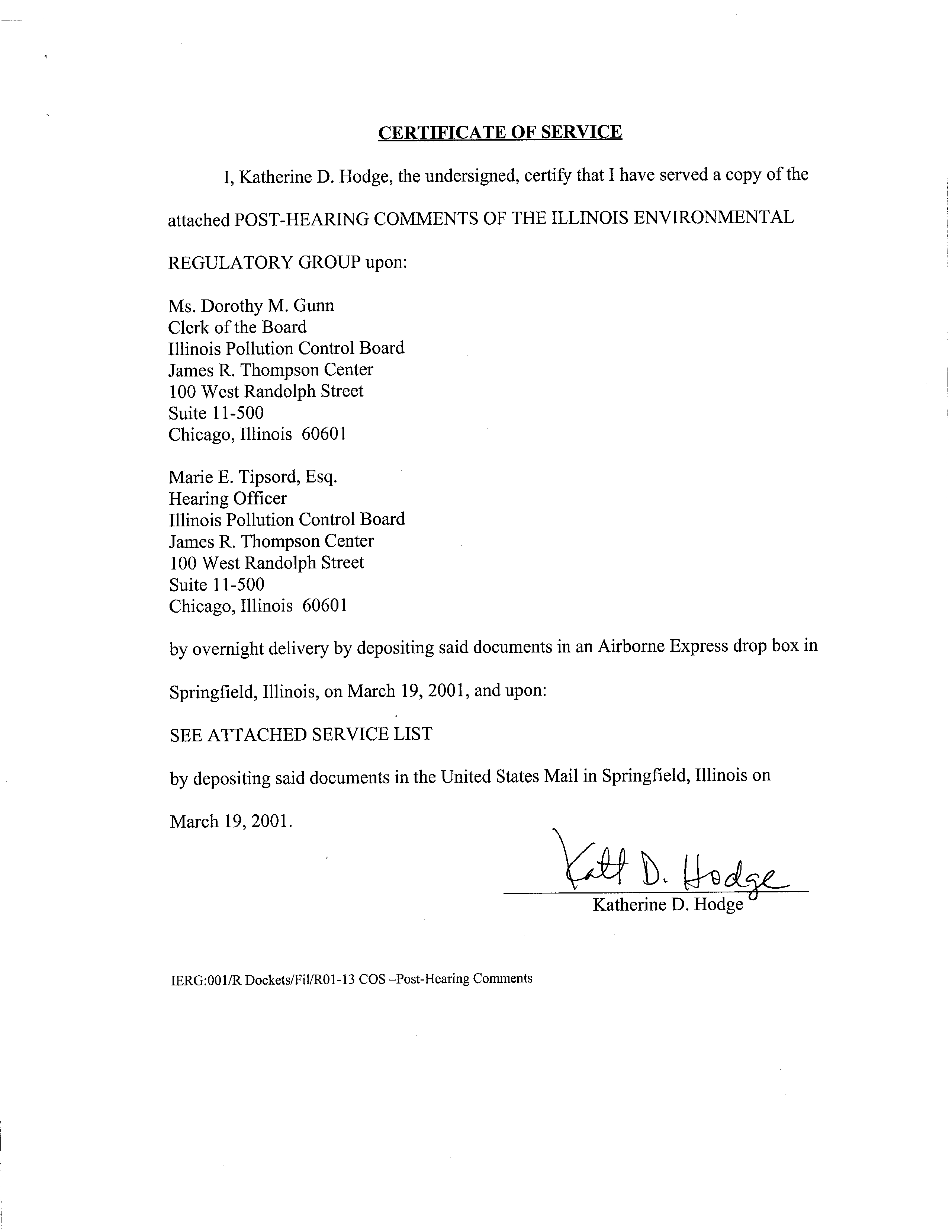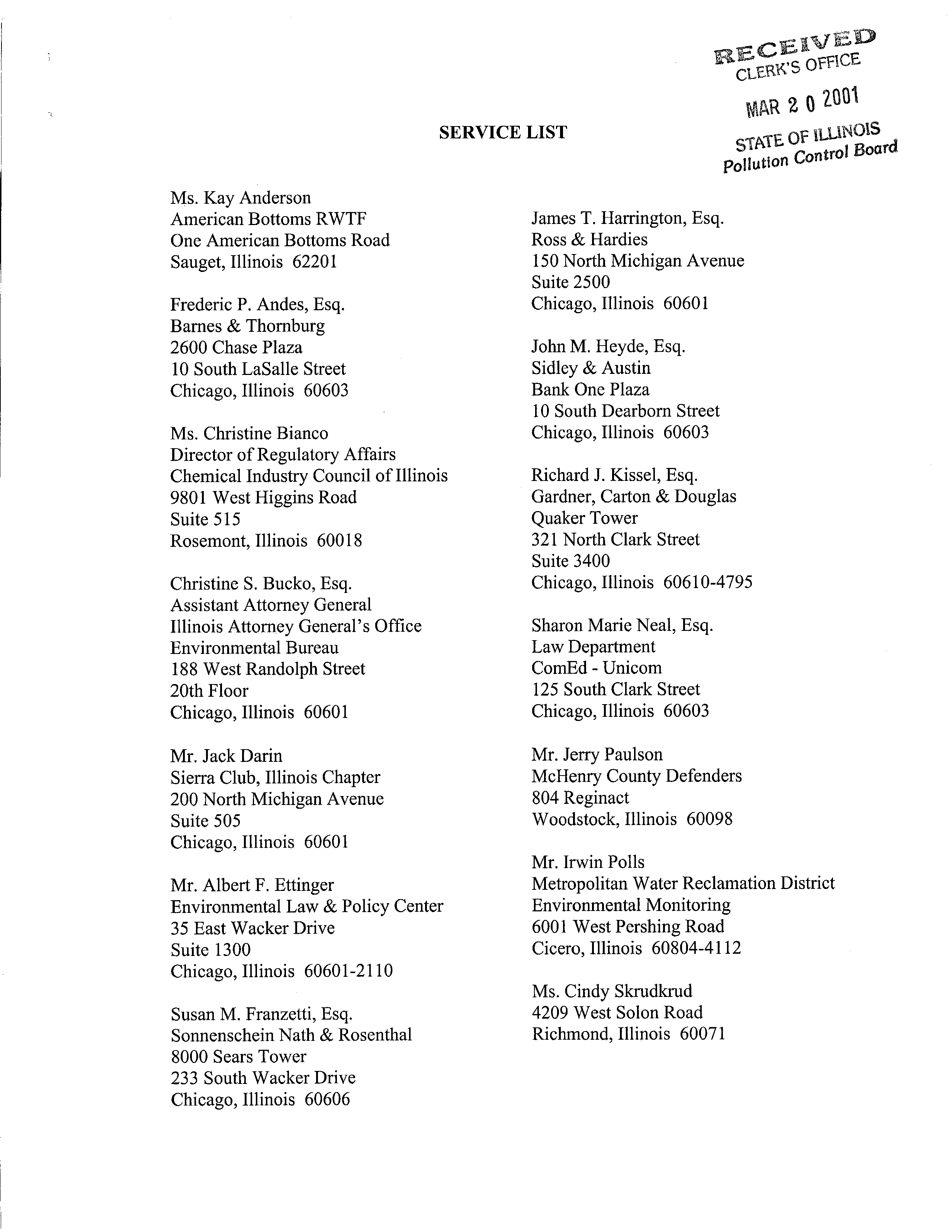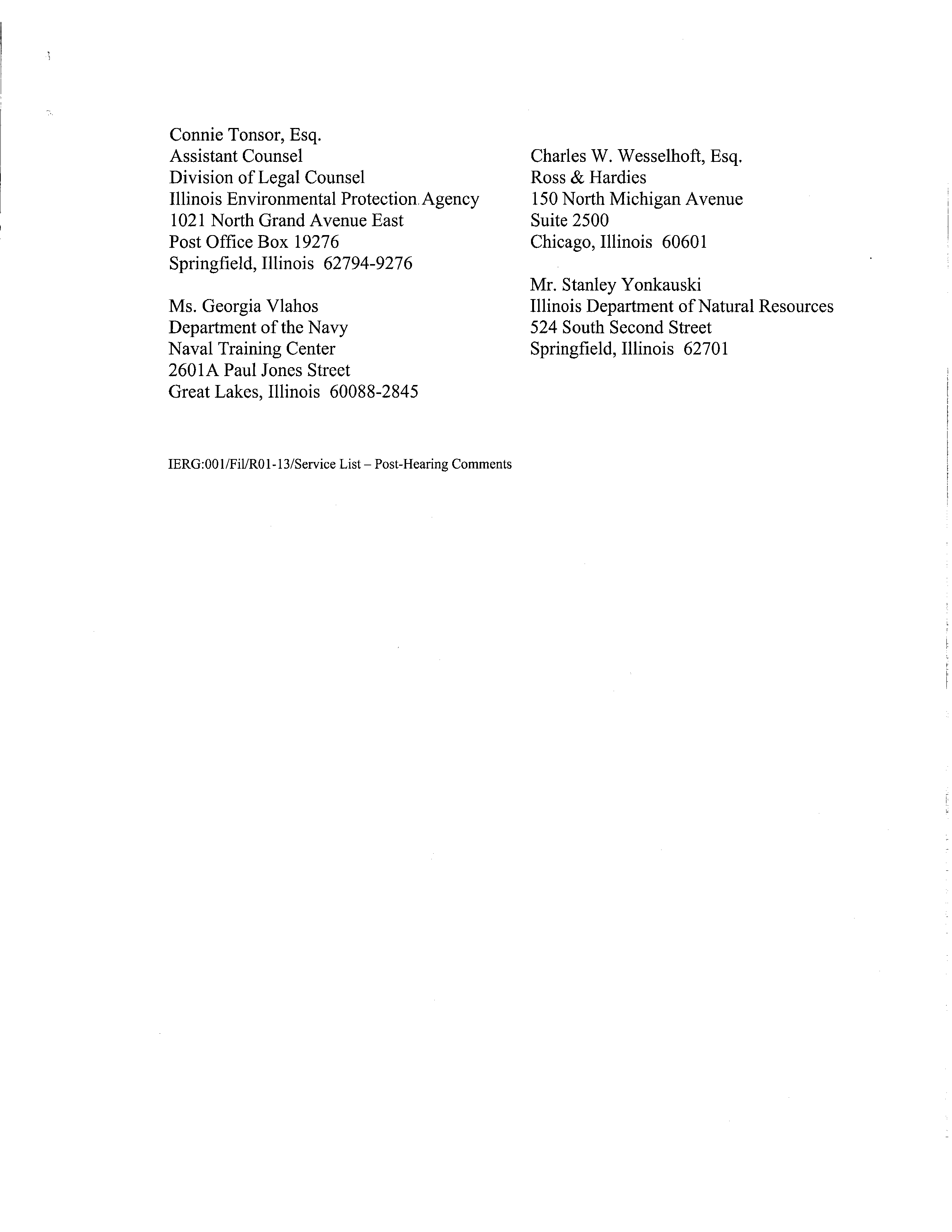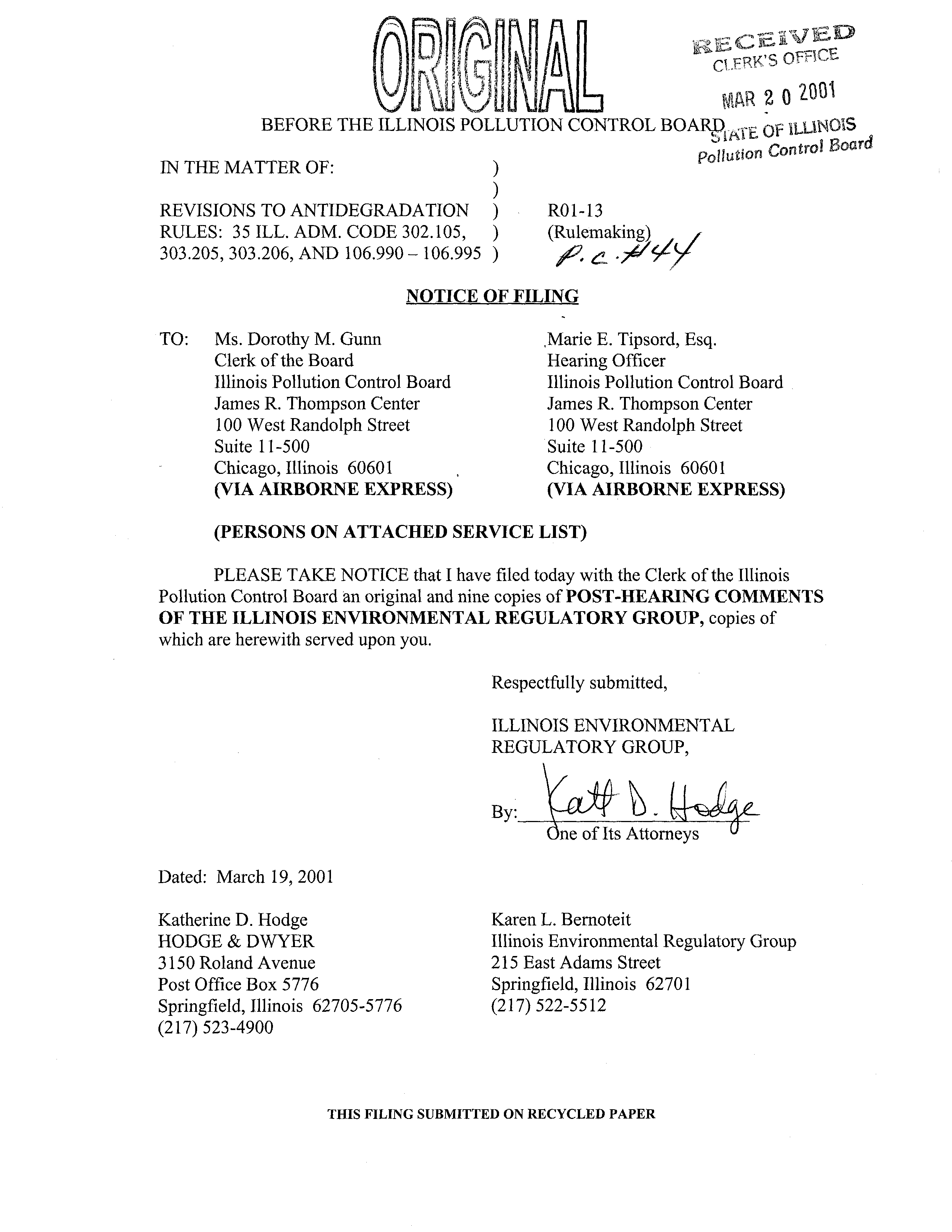
BEFORE THE ILLINOIS POLLUTION CONTROL BOAR~~E
C~FRK’S
~4IAR
OF
20
0E
ILLINOiS2001
~
Pal u
iofl
ContrOl BoOTd
IN THE MATTER OF:
REVISIONS TO ANTIDEGRADATION
RULES: 35 ILL. ADM. CODE 302.105,
303.205,
303.206, AND 106.990
—
106.995
)
)
RO1-13
)
(Rulemaking)
NOTICE OF FILING
TO:
Ms. Dorothy M. Gunn
Clerk of the Board
Illinois Pollution Control Board
James
R. Thompson Center
100 West Randolph Street
Suite
11-500
Chicago, Illinois 60601
(VIA AIRBORNE EXPRESS)
Marie B. Tipsord, Esq.
Hearing Officer
Illinois Pollution Control Board
James
R. Thompson Center
100 West Randolph Street
Suite
11-500
Chicago, Illinois 60601
(VIA AIRBORNE EXPRESS)
(PERSONS ON ATTACHED SERVICE LIST)
PLEASE TAKE NOTICE that I have filed today with the Clerk of the Illinois
Pollution Control Board an original and nine copies of
POST-HEARING COMMENTS
OF THE ILLINOIS ENVIRONMENTAL REGULATORY GROUP,
copies of
which are herewith served upon you.
Respectfully submitted,
ILLINOIS
ENVIRONMENTAL
REGULATORY GROUP,
By:_____________________
fIts Attorneys
Dated: March 19, 2001
Katherine D. Hodge
HODGE
& DWYER
3150 Roland Avenue
Post
Office Box
5776
Springfield,
Illinois 62705-5776
(217)
523-4900
Karen L. Bemoteit
Illinois Environmental Regulatory Group
215 East Adams Street
Springfield, Illinois 62701
(217) 522-5512
)
THIS FILING SUBMITTED ON RECYCLED PAPER
REC. VED
Cl
Frz’V’ f~r!CE
BEFORE THE ILLINOIS POLLUTION CONTROL BOARD MAR 20 2001
IN THE MATTER OF:
STATE OF ILLINOIS
Pollution Control Board
)
REVISIONS TO ANTIDEGRADATION
)
ROl-13
RULES: 35 ILL. ADM. CODE 302.105,
)
(Rulemaking)
303.205, 303.206,
AND 106.990
—
106.995
)
POST-HEARING COMMENTS OF
THE ILLINOIS ENVIRONMENTAL REGULATORY GROUP
NOW COMES the ILLINOIS ENVIRONMENTAL REGULATORY GROUP
(“IERG”), by one of its attorneys, Katherine D. Hodge of HODGE & DWYER, and
submits its Post-Hearing Comments in the above-captioned matter to the Illinois
Pollution Control Board (“Board”), stating as follows:
I.
INTRODUCTION
As the Board is aware, the regulations at issue in this rulemaking are the
culmination
of a two-year process ofconsideration by the Illinois Environmental
Protection Agency (“Agency” or “Illinois EPA”), the regulated community, the
“Environmental Groups,
‘‘1
and other interested participants, regarding how best to protect
the surface waters
ofIllinois from degradation. IERG appreciates the opportunity to
participate in this process, and appreciates the efforts that all parties to this rulemaking
have made.
Based on the testimony at hearing, and a review of the transcripts and written
testimony, it
is clear that all participants agree the Agency must have flexibility in
conducting antidegradation reviews. Not every proposed increase in loading should be
subjected to the same depth and degree ofantidegradation review. IERG strongly
The Environmental Law and Policy Center of the Midwest; Friends ofthe Fox River, Prairie Rivers
Network; and the Illinois Chapter of the Sierra Club, (hereinafter collectively “Environmental Groups.”)
supports Agency flexibility in the process, and believes that the revisions IERG has
proposed to the Agency’s proposed Section 302.105 achieve this goal in the clearest,
most workable manner.
IERG has consistently emphasized five specific areas of concern regarding the
Agency’s proposal during this proceeding. Two of these areas ofconcern specifically
address the need for flexibility during the course ofan antidegradation review:
1.
the Agency’s proposal does not contain a significance test to be used to
determine the need for a comprehensive antidegradation review; and
2.
the Agency’s proposal requires extensive up-front data submissions from
an applicant for a National Pollutant Discharge Elimination System
(“NPDES”) permit or Section 401 certification, which extensive
submissions may not be necessary.
Related to the Agency’s ability to be flexible in its antidegradation review
procedures is the need for the Agency to target its efforts and resources so as to review
those proposed loadings that have true potential to pose a threat to the quality ofwater in
Illinois. Two issues raised by IERG during the course of this proceeding speak to this
concern:
3.
the Agency’s proposal does not contain needed exceptions to the
individual demonstration required
by the proposed Board standard; and,
4.
the Agency’s proposal lacks clarity as it relates to definitions of some of
the provisions and terms proposed.
Finally, also at issue during this proceeding has been the process by which the
Board will
designate surface waterbodies as “outstanding surface waters,” or “ORWs.”
While all participants agree that waters that meet certain criteria should be granted ORW
status, IERG has been the primary participant in this rulemaking to recognize that
designating a water body as an ORW will have severe, far-reaching consequences. Early
2
in the Illinois EPA’s regulatory development process, IERG articulated its concerns
regarding ORW designation. The final issue raised by IERG in th6 context ofdeveloping
and implementing an antidegradation review process addresses this concern as follows:
5.
the Agency’s proposal does not contain sufficient requirements for ORW
designations.
As stated in its December 6, 2000, testimony, IERG is fully aware that the Clean
Water Act requires antidegradation reviews in certain cases. We do not seek to dispute
that principle, but to comment on the procedures with which both the Agency and the
regulated community must
comply if the goal of the antidegradation standard is to be
achieved. Therefore, IERG has proposed revisions to the Agency’s proposed Sections
302.105 and 303.205 to ensure that all affected parties will have fair, clear and workable
regulations to guide their efforts and actions. We respectfully ask the Board to favorably
consider our
recommendations.
II.
THE AGENCY MUST BE ABLE TO EXERCISE FLEXIBILITY IN THE
ANTIDEGRADATION REVIEW PROCESS BY INCORPORATING A
SIGNIFICANCE DETERMINATION INTO ITS PROCEDURES AND BY
ELIMINATING REQUIREMENTS FOR EXTENSIVE UP-FRONT DATA
SUBMISSIONS
A.
Significance Determination
As noted above, all participants to this rulemaking agree that all increases in
loading should not be subjected to the same depth and degree ofantidegradation review.
The Agency has indicated that it can be flexible in conducting antidegradation reviews by
choosing whether to enforce the antidegradation regulations on a “case by case” basis.
~,
~
November 17, 2001, Hearing Transcript, at 72. The Environmental Groups
have stated that they have “considerable misgivings” regarding this approach, but that
3
they are “willing to try [it] for now.” Environmental Groups’ Memorandum of Law, at
17.
As IERG has demonstrated to the Board previously in its filed testimony and
presentation before the Board, however, the language that the Agency has proposed
simply does not
allow the Agency to conduct anything other than a comprehensive
antidegradation review for every increase in loading.
~
~
December 6, 2000,
Hearing Transcript, at 90 (Testimony of Deirdre K. Hirner); January 18, 2001, Prefiled
Testimony of Frederic P. Andes, at 4. In order to address this problem, IERG has
proposed amending the Agency’s proposed Section 302.105 to provide for a significance
review option in antidegradation reviews. A siguificance review would not take place in
every case, but rather only when the permit applicant asked the Agency to conduct such a
review. As noted in IERG’s February 6, 2001, testimony, implementing the
antidegradation review process in this tiered fashion would first allow a determination of
whether a proposed action is of such significance that all five components ofthe full
antidegradation review proposed by the Agency would need to be addressed. Ifnot, the
finding of insignificance would, in and of itself, constitute an appropriate antidegradation
review.
Under the Agency’s proposal, it would be required to assess every proposed
increase in loading relative to the following issues:
1.
“the fate and effect of any parameters proposed for an increased
pollutant loading”;
2.
whether “[t]he applicable numeric or narrative water quality
standard [will] be exceeded as a result
ofthe proposed activity”;
3.
whether “[aill existing uses [will] be fully protected”;
4
4.
whether “all technically and economically reasonable measures to
avoid or minimize the extent ofthe proposed load increase have
been
incorporated into the proposed activity”; and,
5.
whether “the activity that results in an increased pollutant loading
[will] benefit the community at large.”
Agency’s proposed Section 302.1 05(c)(2).
IERG’s proposed significance review would, alternatively, provide that the
Agency would first assure that all existing uses would be fully protected and that water
quality
standards would not be exceeded. Under IERG’s proposal, if necessary to
complete a viable assessment, the Agency would be authorized, at its discretion, to
consider the following factors as well:
a)
the volume, constituents, and concentrations ofparameters in the
proposed increase in pollutant loading;
b)
the nature ofthe proposed increase in pollutant loading, including
location ofthe discharge, and timing and physical characteristics of
the discharge; and
c)
the nature and condition ofthe receiving water, including existing
water quality characteristics, the chemical and physical
characteristics ofthe water and ofthe water body, and any relevant
biological, chemical, or physical characteristics ofthe water which
will
affect the impact ofthe proposed increase in pollutant loading
upon the waterway.
IERG’s Proposed Amended Section 302.
105(c)(2)(A)(iii).
The Agency has noted that it does not wish to engage in a significance review
process that is more burdensome than the antidegradation review that it has proposed in
this proceeding. See November 17, 2000, Hearing Transcript, at 82 (Testimony ofMr.
Toby Frevert). IERG does not believe that its proposed significance determination would
impose any additional burden on the Agency. Rather, in making a significance
determination, the Agency would simply be performing part of the analysis that it would
S
have to perform when conducting a full antidegradation review, as the above-mentioned
factors are among those reviewed when considering “the fate and effect ofany
parameters proposed for
an increased pollutant loading.” Further, permit applicants
would be required to submit similar information under the Agency’s draft Sections
354.103(a) and (b).
Ifthe Agency determined that the proposed increase in loading was not
significant, the Agency would not conduct a further review ofthe proposed increase. If
the Agency determined that the proposed increase was significant, the Agency would
proceed to examine alternatives to the proposed increase, and the anticipated benefits of
the increase that would accrue to the community at-large. It is the analyses ofthese two
components of the antidegradation review process that the regulated community believes
have the greatest potential to adversely impact the timing relative to issuing an NPDES
permit.
As we stated during the February 6, 2001, hearing, many of our industrial
members experience a two to three-year lag time in the Agency’s ability to take action on
NPDES renewal permit applications. February 6, 2001, Hearing Transcript, at 11-12
(Testimony ofDeirdre K. Hirner). The Agency’s inability to process current permit
applications
due to a lack of sufficient staff resources can only worsen with the increased
requirement ofcomprehensive antidegradation reviews. IERG strongly believes that the
inclusion ofa significance determination in the proposed rule will allow the proponents
of proposed discharges and the Agency to protect water quality by focusing their time
and resources on those increased loadings that truly are “significant.”
In the process ofdeveloping its significance determination proposal, IERG
closely studied the
“Antidegradation Implementation” practices suggested by USEPA’s
6
Region VIII 1993 Guidance Document, a copy of which has been provided previously to
the Board. IERG also was able to determine that the states ofWisconsin (Wis. Admin.
Code
§
NR 207.04) and Minnesota (Minn. R. 7050.0 185) provide for a significance
determination. Further, the state of Massachusetts has a significance review option
similar to the one IERG has proposed. In Massachusetts, “[l]imited degradation may be
allowed by the Department where it determines that a new or increased discharge is
insignificant because it does not have the potential to impair any existing or designated
water use and cause any significant lowering of water quality.” Mass. Regs. Code tit.
314,
§
4.04(2) (emphasis added). IERG believes these examples provide solid evidence
that a significance determination is not only a workable review option, but is an option
that has been approved by USEPA.
The Agency has expressed that its intent is not to do what proposed Section
302.105(c) says it must do, that is, conduct a full antidegradation review in every case.
Accordingly, proposed Section 302.105(c) (and draft Part 354) should be revised to
express the Agency’s true intent
—
flexibility
—
through a significance determination
option.
B.
Up-Front Data Submissions
As proposed by the Agency, an applicant for an NPDES permit or 401
certification seeking an increase in loading would be required to submit all data stipulated
in the rule to demonstrate the consequences ofa proposed loading. It is the Agency, and
not the applicant, however, that is charged with determining whether degradation will
occur and, if so, whether it may be warranted to accommodate economic or social
development. Throughout this process, IERG has continually maintained that the
7
Agency, indeed, must have the information it needs to thoroughly make its
antidegradation determination. However, the regulated community is aware that much of
the required information is currently in the possession of the Illinois EPA. Therefore,
throughout the antidegradation regulatory development process, JERG has emphasized
the
necessity ofproviding flexibility in the regulation so as to allow the Illinois EPA to
utilize data in its possession, or to which it has ready access, to conduct an
antidegradation assessment rather than requiring extensive up-front submissions ofdata
from a permit applicant. This, we believe, will avoid wasteful efforts that place an undue
burden on an applicant to acquire and provide what could constitute voluminous
information to the Illinois EPA that, in many instances, duplicates information in the
possession of,
or readily available, to the Agency.
It is generally acknowledged that the Illinois EPA has extensive data for potential
receiving waters that have been the subject of numerous studies, and forthe larger
waterways. IERO
believes that the proposed regulation should specifically stipulate that
the Agency may rely on such data and need not require an applicant to replicate existing
information. Similarly, JERG believes that the Agency should be allowed to rely on the
collective knowledge
and expertise ofits staff when making its determinations.
IERG has continually emphasized the Illinois EPA’s proposal does not provide
for this
flexibility. Therefore, IERG’s proposal adds the following language that would
delineate the information sources the Illinois EPA can utilize in making an
antidegradation assessment:
iii)
In making its assessment, the Agency may utilize the following
information
sources:
8
a)
Information, data or reports available to the Agency from
its own sources;
b)
Information, data or reports supplied by the applicant;
c)
Agency experience with factually similar permitting
scenarios; and/or
d)
Any other valid information available to the Agency.
JERG’s proposed Amended Section 302.105 (c)(2)(b)(iii).
Again,
it is IERG’s belief that inclusion ofthis language will allow the Illinois
EPA to achieve its expressed intent when conducting antidegradation reviews
—
that is, to
look at proposed increased loadings on a case-by-case basis, requiring the submittal of
only that information necessary to conduct a thorough review. As stated in the
February 6, 2001, testimony by Mr. JeffSmith, on behalfof IERG, requiring a permittee
to provide information without consideration ofwhether the Agency already possess it
will, at minimum, delay the
application process. At worst, the expense ofcollecting
unneeded data and associated delays could undermine a project’s viability.
Further in this regard, and as noted by Deirdre K. Hirner during her testimony at
the February
6, 2001, public hearing, IERG believes that revisions to the Agency’s
proposed Part
354
are necessary. IERG understands that proposed Part
354
was not
intended to be part of this proceeding. However, after further consideration, and for the
reasons stated below, IERG believes it is necessary to incorporate the procedures in
proposed Part 354 into the proposed Section 302.105. Accordingly, we have amended
our proposed revision to the Agency’s proposed Section 302.105 to incorporate these
procedures, and have attached our amended proposed revision hereto as Exhibit A.
Please note that IERG has, for the most part, merely inserted the Agency’s proposed
9
language as a “placeholder” into a new subsection 302. 105(c)(3); further revisions may
well be necessary to fully incorporate these procedures into a Board rule.
We believe that the manner in which the Agency requests information from an
applicant, reviews that information, and makes the results ofits assessment known to the
public
is inextricably linked to achieving the antidegradation standard. IERG’s most
significant revision to these procedures, as proposed by the Agency, would be to the
“Required
Information for Antidegradation Review,” which again we believe would
require every proponent of an increase in loading to submittal ofall the data listed
therein. Under LERG’s proposal, the information to be provided by a permit applicant
“for any proposed increase in pollutant loading that necessitates a new, renewed, or
modified NPDES permit, with a new or increased permit limit, or a CWA Section 401
certification,” is on that information that is necessary forthe Illinois EPA to determine
whether any increase in pollutant loading or proposed activity would result in degradation
ofthe receiving water. IERG supports providing the Agency the information it needs to
do its job, and assuring that the public has access to the results of an antidegradation
assessment in which it can have full confidence, and believes that this provision
accomplishes that goal.
III.
THE AGENCY MUST BE ABLE TO TARGET LIMITED RESOURCES
BY RELYING ON FURTHER EXCEPTIONS TO THE
ANTIDEGRADATION REVIEW REQUIREMENT AND ENSURING
THAT THE TERMS OF THE REGULATION ARE CLEARLY DEFINED
A.
Further Exceptions Needed
By including six exceptions to the antidegradation review requirements in its
proposal, the Agency has recognized that activities that are in compliance with other
applicable laws or which improve water quality need not be subject to an antidegradation
10
review. IERG believes additional exceptions warrant inclusion in the proposal. As stated
in our previous testimony, IERG firmly believes that the inclusion of such exceptions
allows the Agency to avoid the review ofpermits that have virtually no environmental
impact and, thus, to expend its resources where truly needed.
First, the Board should revise the Agency’s exception for non-contact cooling
water discharges so that it applies to non-contact cooling water with additives where “the
Agency has approved the use
of any additives present in [the] specific discharge.”
IERG’s Proposed Revised Section 302.
105(d)(5).
At the time the Agency approved the
use
of additives for such discharges, itwould have made the assessment that the additive
had no potential to adversely impact water quality. In essence, the antidegradation
determination has been completed, and additional review under the provisions of Section
302.105 would be duplicative.
Second, the Board should include an exception for “[c]hanges to or inclusion ofa
new permit limitation that does not result in an actual increase ofa pollutant loading.”
IERG’s Proposed Revised Section 302.
105(d)(7).
Such a circumstance could arise due to
the availability ofimproved monitoring data, new analytical testing methods, or the
imposition ofnew or revised technology or water quality-based effluent limitations. In
such a
circumstance, however, there would be no physical change in the receiving water.
The Agency did not include the exception in its proposal based on the rationale that it is
not necessary, stating: “since the Agency believes there is not load increase, the matter is
not subject to the anti-deg rule.” See Agency Memorandum dated June 14, 2000,
Attachment
5,
paragraph 1 (a copy ofwhich is attached hereto as Exhibit B). IERG,
11
however, believes it is better to explicitly state this exception in the regulation so there
will
be no uncertainty as to whether this situation triggers an anti-degradation review.
Third, the Board should also include an exception for “[s]ite stormwater
discharges covered by
a Stormwater Pollution Prevention Plan (SWPPP), as required in
an individual NPDES permit, provided that the discharge will not cause or contribute to a
violation
ofIllinois water quality standards.” IERG’s Proposed Revised Section
302.1
05(d)(8).
Non-stormwater waste streams discharged together with stormwater
subject to contamination from outdoor industrial activities are regulated in an industrial
facility’s individual NPDES permit through the SWPPP and/or specific federal
categorical limitations (for certain industries). The NPDES permit requires the facility to
develop a SWPPP, which requires, among other things, the implementation of best
management practices.
In instances where site development or construction could increase stormwater on
site, it could be argued that an additional antidegradation review would be necessary for
each outdoor plant modification or construction activity, although it has already been
taken into consideration at the time the SWPPP was developed. JERG’s proposed
exception seeks
to avoid any confusion regarding the need for duplications. The
exception also seeks to avoid the unintended dilemm~f the potential for increased
precipitation, an event over which an industrial facility has no control, to trigger the need
for an
antidegradation review at the time ofNPDES permit renewal.
Fourth, the Board should also include an exception for “[niew or increased
discharges ofa pollutant where the permit applicant has made a contemporaneous and
enforceable decrease in the actual loading ofthat pollutant at the source such that there is
12
no net increase in the loading of that pollutant into the same surface water body or
surface
water body segment.” IERG’s Proposed Revised Section 302.105(d)(9). As
discussed at the Third Hearing, such discharges do not increase the quantity ofa pollutant
discharged into a water body, so they pose no additional threat to water quality. In
choosing to exclude this exception from its proposal, the Agency’s rationale
acknowledged that offsets, internal to an individual permittee, may require a permit
modification to reflect the changed
operating conditions, but stated that if the change
would not constitute a load increase, antidegradation would not apply. See Agency
Memorandum dated June 14, 2000, Attachment
5,
paragraph 9. Again, IERG believes it
is better to explicitly state the exception in the regulation so there will be no uncertainty
as to whether this situation triggers an antidegradation review.
Fifth, the Board should also include exceptions for discharges “authorized by a
site-specific
regulation, adjusted standard, or variance issued by the Board,” or “by a
Consent Order or
Consent Decree entered by a court of competentjurisdiction.” IERG’s
Proposed Revised Sections 302. 105(d)(10), (11). The Agency has indicated that “[i]f the
Board
specifically authorizes a load increase through its own action[,] the Agency will
not nullify
any provision of that order through application ofanti-degradation. The
Board order itself will constitute either compliance with or exception from the action at
hand.” Agency Memorandum dated June 14, 2000, Attachment
5,
paragraph 6. Again,
IERG recommends explicitly stating the exception to avoid unnecessary uncertainty.
Further, we believe it is important to note, the Agency has no authority to review a Court
Order authorizing a discharge.
13
Finally, the Board should include an exception for de minimis discharges that use
less than ten percent (10%) of a receiving water body’s assimilative capacity. IERG’s
Proposed Revised Section 302.105(d)(12). As IERG has noted to the Board, the United
States Environmental Protection Agency (“USEPA”) has endorsed the use of a ten
percent (10%) de minimis exception from antidegradation review requirements, stating:
EPA and the Great Lakes States and Tribes believe that the 10 percent
value chosen as the threshold represents a
reasonable balance between the
need
to the regulatory agencies to limit the number of actions involving
non-BCCS that are subjected to the detailed antidegradation demonstration
requirements and the need to protect and
maintain water quality. In
particular, it is believed that any individual decision to lower water quality
for non-BCCs
that is limited to 10 percent ofthe unused assimilative
capacity represents minimal risk to the receiving water and its ability to
support all existing uses.
Proposed Water Quality Guidance for the Great Lakes System,
58
Fed. Reg. 20802,
20903 (April 16, 1992) (emphasis added)2.
Further, the USEPA has approved the use ofa de minimis exception for every
other state in USEPA’s Region V, as follows:
2
Copies of all portions of the Federal Register, of statutes, or of regulations cited in these Comments
are
attached hereto as Exhibit C for the Board’s convenience.
14
STATE
DE MINIMIS
LEVEL
CITATION
USEPA
APPROVAL
Indiana
10%
Ind. Admin. Code tit. 327, r. 5-
2-li .3(b)(1)(B)(ii)
65 FR 47864-01
Michigan
10%
Mich. Admin. Code r.
323. 1098(9)(c)3
65 FR 47864-01
Ohio
10%~
Ohio Admin. Code § 3745-1-
05 (D)( 1 )(b)(i)
65 FR 47864-01
Wisconsin
33%5
Wis. Admin. Code § NR
207.05(4)(a)(l)
65 FR 66502-02
Minnesota
see footnote6
Minn. R. 7050.0 185(2)(G)
65 FR 48517-01
States in other parts of the country also provide for a de minimis exception to
5
their antidegradation review requirements, including New Hampshire7 and Texas
It is IERG’s understanding that amendments to Michigan’s water quality standards will be proposed in the
near future. A copy ofthe proposed amendments is not available at this time, but it is IERG’s
understanding, based on conversations with the Michigan Department of Environmental Quality, that the
proposed amendments will not affect Michigan’s 10% de minimis exception.
‘~
Ohio has several categories of “high quality waters.” “General high quality waters” correspond to the
high quality water designation proposed by the Agency in proposed Section 302.105(c); “superior high
quality waters,” are waters at a level somewhere between “high quality water” and ONRW. See Ohio
Admin. Code § 3745-1-05(A)(9). The de minimis cutoff for “general highquality waters” is 10%. Ohio
Admin. Code § 3745-1-05(D)(1)(b)(i). The de minimis cutoff for “superior high quality waters” is 5%.
Ohio Admin. Code § 3745-1-05(D)(1)(b)(ii).
~Wisconsin provides for a 33% de minimis cutoff for “indicator parameter[s] other than dissolved
oxygen.” Wis. Admin. Code § NR207.05(4)(a)(1). Dissolved oxygen is subject to a different fonnula.
See Wis. Admin. Code § NR 207.05(4)(a)(2).
6
Minnesota provides for a de minimis exception (which it refers to as “significance”), but rather than
defining de minimis by the amount ofassimilative capacity to be used by an increase in loading, it defines
de minimis by the volume of the discharge increase or whether the increase contains “any toxic pollutant at
a mass loading rate likely to increase the concentration of the toxicant in the receiving water by greater than
one percent over the baseline quality.” Minn. R.
7050.0 185(2)(G)(3).
~N.H. Code Admin. R. Env-Ws 430.34(b)(4) provides for an exception from antidegradation review
procedures for increases in loading to “Class B Waters” that use less than
25%
of the receiving water’s
assimilative capacity. “Class B Waters” are in part defined as waters “acceptable for fishing, swimming
and other recreational purposes and, after adequate treatment, for use as water supplies.” N.H. Rev. Stat.
Ann. § 485-A:8(JI).
30 Tex. Admin. Code § 307.05(b)(2) (defining “degradation” as “a lowering of water quality by more
than a de minimis extent, but not to the extent that an existing usc is impaired” (emphasis added)).
15
As discussed above, all parties agree that the Agency needs flexibility in
conducting antidegradation reviews, in order to allow it to focus its resources on those
loading increases that pose a threat to water quality. The de minimis exception, as well
as the other
exceptions discussed above, are necessary to preventthe Agency from
becoming bogged down in meaningless, resource-wasting reviews ofloading increases
that do not pose any threat to water quality.
B.
Clarity ofTerms and Provisions
Industry supports full compliance with environmental laws and regulations.
Compliance is in the best interest ofthe regulated community and the public at-large. In
order to comply with an environmental law, however, industry must have a definitive
understanding of when the law applies, and the compliance threshold must be clearly
articulated in the rules and regulations. On review ofthe Illinois EPA’s proposed
language, IERG believes this is not the case in the proceeding currently before the Board,
particularly as it relates to the trigger for an antidegradation review.
To rectify this matter, IERG has proposed a revision to proposed Section
302. 105(c)(2) to make clear that the requirements for an antidegradation review do not
apply
to all loadings “subject” to an NPDES permit. IERG offers language to provide
that a minimum threshold to trigger an antidegradation review must be related to the need
to obtain an NPDES permit and to the limit stated in the permit:
Any proposed increase in pollutant loading that necessitates a new,
renewed, or modified NPDES permit, with a new or increased permit
limit, or a CWA Section 401 certification, must be assessed by the Agency
to determine whether allowing the lowering ofwater quality is necessary
to accommodate important economic or social development.
IERG’s Proposed Revised Section 302.105(c)(2).
16
IERG believes this language meets the goal of the antidegradation standard,
which requires that existing water uses be maintained and protected, and that waters
whose existing quality exceeds established standards be maintained in theirpresent high
quality. IERG further believes ourproposed revision reflects Mr. Frevert’s testimony at
the November 17, 2000, hearing when he indicated that the Agency’s proposed rule
would not apply “where there is no proposed increase in any pollutant parameter
activity,” and that the antidegradation review would not be required unless an applicant
filed “for an increase over and above those levels that are already authorized in your
permit.” November 17, 2000, Hearing Transcript, at 44-46 (Testimony of Mr. Toby
Frevert). Therefore, IERG would urge the Board to adopt its proposed revision.
IV.
THE OUTSTANDING RESOURCE WATER DESIGNATION
PROCEDURES MUST BE STRENGTHENED
In addition to agreeing that all increases in loading should not be subject to the
same
level ofantidegradation review, all participants in this rulemaking agree that the
Board should establish procedures by which persons can seek designation of qualified
surface water bodies as “Outstanding Resource Waters,” or “ORWs.” The Agency has
proposed such procedures (see the Agency’s proposed Section 303
.205),
and IERG has
proposed some revisions to the Agency’s proposed procedures. For the reasons discussed
below, IERG
submits that its proposed revisions are necessary to fashion an ORW
designation procedure that protects the rights of, and is fair to, all affected parties.
The main issue that IERG has raised regarding ORW designation is what type of
proceeding the Board should utilize when considering whether to designate a water body
as an ORW. “Board proceedings can generally be divided into two categories:
rulemaking proceedings and adjudicatory proceedings.” 35 Ill. Admin. Code
§
17
101.108(a). The Agency has proposed that the Board designate ORWs through a
“hybrid” proceeding, that appears to be a combination ofa regulatory and an adjudicatory
proceeding. See the Agency’s proposed Section 106.990. IERG, on the other hand, has
proposed amending the Agency’s proposal to provide that ORW designations shall take
place through an adjudicatory proceeding, specifically an adjusted standard proceeding.
See IERG’s Proposed Revised Section 303.205. LERG is not aware ofany comment by
the Environmental Groups or any other participant to this rulemaking other than the
Agency and IERG on this issue.
IERG has proposed that the Board utilize an adjudicatory proceeding when
considering whether
to designate a water body as an ORW because the burden ofproof
on a proponent in an adjudicatory proceeding before the Board is well established, while
the burden ofproofon a proponent in a rulemaking proceeding is not. In an adjusted
standard
proceeding, for example, “[t]he burden ofproof.
..
is on the petitioner,” who
“must justify an adjusted standard consistent with Section 27(a) ofthe Act.” 35 Ill.
Admin. Code
§
104.426. IERG is not aware ofany decision by the Board establishing
the burden of proofon the proponent in a rulemaking proceeding.
The issue of burden of proofis crucial in this context for several reasons. First,
and most importantly, the burden ofproofmust be clear because ofthe severe impacts
that an ORW designation would have. When IERG questioned the Agency’s witness Mr.
Toby Frevert at the First Hearing in this matter regarding what type ofproceeding the
Board should use to designate ORWs, Mr. Frevert indicated that the Agency “want[ed] to
adhere to a fairly open regulatory process.” November 17, 2000, Hearing Transcript, at
p. 88, 11. 9-10. Mr. Frevert further testified, however, that:
18
the ramifications of[a] decision [to designate a surface water body as an
ORW] are fundamentally more significant than the ramifications of a
typical adjusted standard or even a
statewide standard in that we are not
setting a target to protect an environmental use here. We are setting an
absolute prohibition on some activities. And that has greater ramifications
on property owners and other citizens in the community than changing the
water quality standard from No. A to No. B.
So our intent is to remain relatively flexible, recognizing those higher
ramifications, making sure there is an obligation to disseminate adequate
information to start the process and that potentially [a]ffected property
owners and other citizens have adequate notice, whieh probably isn’t
accomplished in a typical adjusted standard set ofprocedure requirements.
You are not only talking about surface property rights, but even mineral
rights[,] and [with] an outstanding resource water[,] other than a very few
things[,] you are almost precluded in any development. And that is so
much ofa higher significance than merely adjusting an environmental
effect standard that we thought there is a responsibility to even start the
process to make sure that the people that have something at stake and are
effected have a better chance of getting notice early on so they can
participate.
November 17, 2000, Hearing Transcript at p. 88, 11. 11-19.
In a proceeding that will set “absolute prohibitions” on the use of land owned by a
specific set of persons, a proponent ofan ORW designation must have a burden to prove
the facts in support of the designation and to prove that the designation is warranted. It is
crucial that the State not take away property rights without at least that level of process.
Second,
the clear burden of proofofan adjudicatory proceeding gives interested
parties clear direction on what they must show to either support or oppose the
designation. The proponent ofthe designation knows that it has the burden to establish
certain things. The opponent of the designation knows what the proponent must
establish, and is thus able to ascertain whether the proponent has met its burden.
Third, the clear burden ofproof ofan adjudicatory proceeding gives the Board a
framework to utilize when considering a petition to designate a water body as an ORW.
19
The Board can examine whether the proponent has met its burden ofproof on the
specified issues. Ifthe proponent has met its burden of proof, the designation can be
granted; if the proponent has not met its burden ofproof, the designation can be denied.
Fourth, use ofan adjudicatory proceeding makes it much easier for a reviewing
court
to evaluate the Board’s decision. “When an administrative agency such as the
Board exercises
its rulemaking powers, it is performing a quasi-legislative function and,
therefore, has no burden to support its conclusions with a given quantum of evidence.”
Horsehead Resource Dev. Co.. Inc. v. Illinois Pollution Control Bd., 684 N.E.2d 837, 840
(1st Dist. 1997) (citations omitted). Thus, when reviewing a rulemaking, a court “need
not consider whether the manifest weight ofthe evidence reveals that the proposed
regulations are technically
feasible and economically reasonable. A regulation will be
upheld
ifthe record simply reflects that these factors were ‘taken into account.”’ Granite
City Div. ofNat. Steel Co. v. Illinois Pollution Control Bd., 581 N.E.2d 703, 708 (5th
Dist. 1991) (citations omitted).
So, if the Board denied a petition to designate a water body as an ORW in a
rulemaking proceeding, a reviewing court would not be able to consider, for example,
whether the evidence presented by the proponent ofthe designation demonstrated that
denial
ofthe designation would threaten endangered species or the essential character of
the waterbody. Instead, the reviewing court would only be able to examine whether the
Board had “taken those
issues into account,” with no regard as to the amount or the
quality of the evidence presented to the Board on those issues.
On the other hand, if the Board denied a petition to designate an ORW in an
“adjudicatory proceeding, a reviewing court may only set aside the agency decision ifit
20
is clearly against the manifest weight ofthe evidence.” Shell Oil Co.. et al v. Illinois
Pollution Control Bd., 346 N.E.2d 212, 218 (5th Dist. 1976). Therefore, the reviewing
court’s responsibility “is to evaluate all the evidence on the record.
..
to determine
whether the Board’s finding
arc contrary to the manifest weight of the evidence.” Wells
Manufacturing Co. v. Illinois Pollution Control Bd., 383 N.E.2d 148, 151 (Ill. 1978). In
this situation, the reviewing court would be able to review the amount and the quality of
the evidence presented to the Board.
IERG has noted the similarities between the designation of ORWs and the
designation
of“special resource groundwaters.” See Prefiled Testimony of Bill Compton
at
5-6.
First, both arc unique bodies ofwater. A “special resource groundwater” is
“[gjroundwater that is determined by the Board.., to be.
..
[diemonstrably unique[,]
[v]ital for a particularly sensitive ecological systemE,] or... that contributes to a
dedicated nature
preserve. 35 Ill. Admin. Code
§
620.230. An “ORW” is “a water body
or
waterbody segment that is ofuniquely high biological or recreational quality.”
Agency’s proposed Section 303.205.
Second, the designation of both special resource groundwaters and ORWs places
burdens
on the owners of real property at which the waters are located. At the first
hearing in this matter, the Agency’s witness Mr. Frevert acknowledged that both
designations would both impose “significant.
..
restrictions” on property owners.
November 17, 2000, Hearing Transcript, at p. 94, 11. 2-8. In fact, Mr. Frevert testified
that it was
his understanding that the limitations associated with the designation ofan
ORW “may be even more restrictive
for outstanding resource waters than the limitations
placed on groundwaters.” November 17, 2000, Hearing Transcript, at p. 94, 11. 9-12.
21
IERG has proposed that the adjusted standard procedure be the adjudicatory
proceeding that the Board uses to designate ORWs. At the Third Hearing, the Board
raised some questions about the use of the adjusted standard procedure, including whom
the parties to such proceedings would be, how interested persons would prove standing
sufficiently to participate in such proceedings, and who could appeal in such proceedings.
February 6, 2001, Hearing Transcript, at pp. 116 to 118.
IERG proposed the use of the adjusted standard procedure because ofthe parallels
between ORWs and Special Resource Groundwaters, which are designated through an
adjusted standard proceeding. IERG agrees that the Board’s concerns about the use of
the adjusted standard procedure are valid, however. After further consideration, IERG is
not wedded to the use ofthe adjusted standard procedure to designate ORWs. Instead,
IERG’s goal is to have ORW designations take place through an adjudicatory proceeding,
for the reasons stated above. This could either be a modified adjusted standard process,
or some other adjudicatory type ofproceeding, as the Board may see fit.
V.
CONCLUSION
IERG would like to again thank the Board for holding the Third Hearing in this
matter on February 6, 2001. IERG believes that the comments and proposals submitted
in advance ofthat Third Hearing, and the testimony elicited at that Third Hearing, will be
very helpful to the Board as it considers the Agency’s antidegradation proposal. IERG
urges the Board
to favorably consider the revisions to the Agency’s proposal put forth by
22
IERG and discussed at the Third Hearing and above in taking further action in this
matter.
Respectfully submitted,
ILLINOIS ENVIRONMENTAL
REGULATORY GROUP,
By:________________________
Katherine D. Hodge
Dated: March 19, 2001
Katherine D. Hodge
Thomas
G. Safley
HODGE
& DWYER
3150 Roland Avenue
Post Office Box 5776
Springfield,
Illinois 62705-5776
(217)
523-4900
Karen L. Bernoteit
Illinois Environmental Regulatory Group
215 East Adams Street
Springfield, Illinois 62701
IERG:OO hR Dockets/FiIJRO1-1 3/Post-Hearing Brief
23
EXHIBIT A (3/19/0 1)
IERG’S PROPOSED REVISIONS TO THE AGENCY’S PROPOSAL FOR PART 302
TITLE 35: ENVIRONMENTAL PROTECTION
SUBTITLE C: WATER POLLUTION
CHAPTER I: POLLUTION CONTROL BOARD
PART 302
WATER QUALITY STANDARDS
Section 302.105 Antidegradation
The purpose ofthis Section is to maintain high quality waters and to prevent unnecessary
deterioration of waters ofthe State.
a)
Existing Uses
Uses actually attained in the surface water body or surface water body segment on
or after November 28,
1975,
whether or not they are included in the water quality
standards, must be maintained and protected. Examples of degradation of
existing uses ofthe waters of the State include but are not limited to:
1)
an action that would result in the deterioration ofthe existing aquatic
community, such as a shift from a conrmunity ofpredominantly pollutant-
sensitive
species to pollutant-tolerant species or a loss of species diversity;
Of
and
2)
an action that would result in a loss of a resident or indigenous species
whose presence is necessary to sustain commercial or recreational
activities.
b)
Outstanding Resource Waters
1)
Waters that arc cla~ificd designated as an Outstanding Resource Waters
(ORWa) pt
tint-ta and listed in
35
Ill. Adm. Code 303 .206 must not be
lowered
in quality cxccpt a~ providcd below:, provided, however, that the
follow activities and discharges may be allowed if the Agency determines
that the requirements for High Ouality Waters. set forth in subsection (c
of this Section. have been met. and that all existing uses ofthe ORW water
will be fully protected
A)
An-aeti~44y Activities that resulta in short-term, temporary (i.e.,
weeks or months) lowering ofwater quality in an ORW;
of
B)
Existing site stormwater discharges into an ORW that comply with
applicable federal and state stefifi-watef stormwater management
regulations
and that do not result in a violation ofany water quality
standards; and
C)
Activities that result in an increase in pollutant loading into an
ORW that necessitates the issuance of a new. renewed. or modified
The proponent of any activity’ requiring a National Pollutant
Discharge Elimination System (NPDES) permit. with a new or
increased permit limit, or a Clean Water Act (CWA) Section 401
certification, is required. provided that the proposed increase in
pollutant loading is necessary for an activity that will improve
water quality in the ORW and that such water quality improvement
could not be practicably achieved without the proposed increase in
pollutant loading, must also submit a demonstration to the Agency
meeting the requirements of subsections b(2) and e(2) of this
Seetiefi.
2)
The activities referenced in subsection (b)(1) or proposed increase in
pollutant loading must also meet the following requirements
A)
All existing uses of the ORW water will be fully proteeted
B)
The proposed increase in pollutant loading is necessary for an
activity that will improve water quality in the ORW; and
The
111/1
nrn~ti~nh1v achieved without the
proposed increase in pollutant loading
3)
P~y proposed increase in pollutant loading requiring an NPDES permit or
a CWA 401 certifleation for an ORW must be assessed pursuant to
35
Ill
Adm. Code Part
351
to determine compliance with this Section
c)
High Quality Waters
1)
Except as otherwise provided in subsection (d) ofthis Section, waters of
the State whose existing quality exceeds established standards of this Part
must be
maintained in their present high quality, unless the Agency
determines, the proponent can demonstrate pursuant to subsection (c)(2) of
this Section, that allowing the lowering of water quality; is necessary to
accommodate important economic or social development.
2)
Any proposed increase in pollutant loading that necessitates a new
renewed, or modified s jeet-te--a NPDES permit, with a new or increased
permit limit, or a CWA Section 401 certificationA must be assessed by the
Agency pursuant to
35
Ill. Adm. Code Part
351
to determine eefflplianee
2
with this Section. whether allowing the lowering of water quality is
necessary to accommodate important economic or social development.
A)
In making its assessment, the Agency shall determine, upon a
request by an applicant pursuant to subsection (c)(2)(A)(i) ofthis
Section. and in accordance with subsections (c)(2~(A)(i) through
(vi) ofthis Section, whether the proposed increase in pollutant
loading will have a significant impact upon the overall water
quality, or the existing uses. ofthe receiving water. Ifthe Agency
determines that the proposed increase in pollutant loading will not
have a significant impact upon the overall water quality or the
existing uses ofthe receiving water. such increase in pollutant
loading shall be deemed to comply with the provisions of
subsection (c)(2)(B) ofthis Section
Any applicant for a new. renewed. or modified NPDES
permit or CWA Section 401 certification may file with the
Agency. as part ofits application, a request for a
determination that the proposed increase in pollutant
loading (or other activity or discharge) will not have a
significant impact upon the overall water quality, orthe
existing uses. of the receiving water
ii)
Such request shall set forth, as necessary. information on
the proposed increase in pollutant loading, the nature of the
dischar2e in general. including timing. location and
physical characteristics, and may also include any other
information which may assist the Agency in making its
determination
iii)
In making its significance determination, the Agency may
consider
a)
the volume. constituents. and concentrations of
parameters in the proposed increase in pollutant
loading
b)
the nature ofthe proposed increase in pollutant
loading, including location of the discharge. and
timing and physical characteristics ofthe discharge
and
c)
the nature and condition of the receiving water
including existing water quality characteristics, the
chemical and physical characteristics ofthe water
3
and of the water body. and any relevant biological
chemical, or physical characteristics ofthe water
which will affect the impact ofthe proposed
increase in pollutant loading upon the waterway
Or. alternatively the Agency may consider whether the
applicable numeric ornarrative water quality standard will
not be exceeded as a result of the proposed activity and
whether all existing uses will be fully protected
iv)
In making its significance determination, the Agency may
utilize the information sources set forth in subsection
(c)(2)(B)(iii) of this Section
v)
The Agency shall make significance determinations in
accordance with ~
subsection 302.105
(c) (3)
of this Section
vi)
Ifthe Agency determines that the proposed increase in
pollutant loading is significant. it shall so inform the
applicant, in which case. the applicant then may comply
with the provisions ofsubsection (c)(2)(B) of this Section
or may appeal the Agency’s determination to the Board in
accordance with
35
Ill. Adm. Code 105.Subpart B
B)
Ifthe Agency determines that the proposed increase in pollutant
loading will have a significant impact upon the overall water
quality or the existing uses of the receiving water, such proposed
increase in pollutant loading shall be assessed by the Agency in
accordance with
subsection
302.105 (c) (3)
ofthis Section.
In making its
assessment
I)
The Agency shall consider the fate and effect of any
parameters proposed for
an increased pollutant loading~,
ii)
The proponent ofan increased pollutant loading shall
demonstrate the following: The Agency shall determine
whether
a)
The applicable numeric or narrative water quality
standard
mtt~
will not be exceeded as a result of the
proposed activity;
b)
All existing uses II9iist will be fully protected;
4
c)
All technically and economically reasonable
measures to avoid or minimize the extent ofthe
proposed increase in pollutant loading IdInei’ea~e
have been incorporated into the proposed activity;
and
d)
The activity that results in an the increased in
pollutant loading mttat will benefit the community
at large.
iii)
In making its assessment, the Agency may utilize the
following information sources
a)
Information, data or reports available to the Agency
from its own sources
b)
Information, data or reports supplied by the
applicant
c)
Agency experience with factually similar permitting
scenarios: and/or
d)
Any other valid information available to the
Agency
In conducting Antidegradation Assessments pursuant to this Section
the Agency shall comply with the following procedures
A)
A permit application for any proposed increase in pollutant
loading that necessitates a new, renewed. or modified NPDES
permit. with a new or increased permit limit, or a CWA
Section 401 certification, must include, to the extent necessary
for the A~encv to determine that the Dermit anulication meets
the requirements of Section 302.105, the following information
i)
Identification and characterization of the waters
affected by the proposed load increase or proposed
activity and their existing uses. Characterization must
address physical. biological and chemical conditions of
the waters
ii)
Identification and quantification of the proposed load
increases for the applicable parameters and of the
potential impacts of the proposed activity on the
affected waters
5
iii)
The purpose and anticipated benefits of the proposed
activity. Such benefits mayinclude, but are not limited
to
a)
Providing a centralized wastewater collection
and treatment system for a previously unsewered
community
b)
Expansion to provide service for anticipated
residential or industrial growth consistent with a
community’s long range urban planning
Addition ofa new product line or production
increase or modification at an industrial facility
or
d)
An increase or the retention of current
employment levels at a facility
iv)
Assessments ofalternatives to proposed increases in
pollutant loading or activities subject to Agency
certification pursuant to Section 401 ofthe CWA that
result in less of a load increase, no load increase or
minimal environmental degradation. Such alternatives
may include, but are not limited to
a)
Additional treatment levels including no
discharge alternatives:
Discharge
ofwaste to alternate
1nr2tinn~
including publicly-owned treatment works and
streams with greater assimilative capacity: or
c)
Manufacturing practices that incorporate
pollution prevention techniques
Any additional information the A~encv may request
vi)
Any of the information sources identified in subsection
302.105(d) (3)
B)
The Agency must complete an antidegradation demonstration
review in accordance with the provisions of this Section
i)
The antidei~radation assessment pursuant to this
Section is a Dart ofthe NPDES permitting process or
6
the CWA Section 401 certification process. However.
applicants slimuld xn~~ initiate communication with the
Agency, preferably durine the
plannini~ stage for any
load increase. Communication will help assure the
adeiuacv of information necessary to constitute an
antide2radation demonstration and avoid or minimize
delays and reuiuests for supplemental information
during the permittini~ stage. The A2ency review
process
shall be initiated by:
a)
an informal or preliminary request ofa
proponent of a project prior to filing of a permit
application: or
receipt of an
——
~nnhip~itinn
SJSpRAtULK~R~ for an NPDES permit
issuance, renewal or modification, or a CWA
Section 401 certification
ii)
A proponent seeking an immediate review of the results
of the Agency’s review pursuant to subsection (b)(1
must do so within the NPDES permit process or the
CWA Section 401 certification process
iii)
After a review pursuant to subsection (a)(1). the Agency
shall consult with the proponent and respond
a)
b)
in writing to written requests;
verbally
to verbal requests: or
c)
in a monnDl’ othr~rwi~~ 2Qr~i~d uinnn
iv)
The written response will include a statement by the
Agency indicating whether the demonstration, based
upon the information provided or information acquired
by the Agency during the review process. meets the
criteria of this Section
v)
After its review, the Agency shall produce a written
analysis addressing the requirements ofthis Section and
provide a decision yielding one ofthe following results
a)
Ifthe demonstration meets the requirements of
this Section. then the Agency shall proceed with
public notice of the NPDES permit or CWA
Section 401 certification and include the written
7
analysis as a part ofthe fact sheet accompanying
the public notice
b)
If the demonstration does not meet the
requirements ofthis Section. then the Agency
shall provide a written analysis to the applicant
and shall be available to discuss the deficiencies
that led to the disapproval. The Agency may
suggest methods to remedy the conflicts with the
requirements ofthis Section
c)
Ifthe demonstration does not meet the
requirements of this Section. but some lowering
ofwater quality is allowable, then the Agency
will contact the applicant with the results ofthe
review
1.
Ifthe reduced loading increase is
acceptable to the applicant, upon the
receipt ofan amended demonstration. the
Agency will proceed to public notice: or
2.
Ifthe reduced loading increase is not
acceptable to the applicant, the Agency
will transmit its written review to the
applicant in the context ofa NPDES
permit denial or a CWA Section 401
certification denial
C)
When the Agency initially determines to authorize a load
increase, public notice and public participation will be
achieved through the public notice procedures found in 35 Ill
Adm. Code 309.109 or CWA Section 401 certifications. The
Agency shall incorporate the following information into a fact
sheet accompanying the public notice
i)
A description of the activity, including identification of
water quality parameters which will experience the
increased pollutant loading
ii)
Identification ofthe affected water segment. any
downstream water segment also expected to experience
a lowering of water quality, characterization of the
designated and current uses ofthe affected segments
8
and identification ofwhich uses are most sensitive to the
proposed load increase
iii)
A summary of any review comments and
recommendations provided by Illinois Department of
Natural Resources, local or regional planning
commissions, zoning boards and any other entities the
Agency consults regarding the proposal
iv)
An overview of alternatives considered by the applicant
and identification of any provisions or alternatives
imposed to lessen the load increase associated with the
proposed activity: and
The name and telephone number of a contact person at
the Agency who can provide additional information
d)
Activities Not Subject to a Further Antidegradation D;2~n~i~ Assessment
The following activities shall be deemed to comply with the provisions ofthis
Section and shall not be subject to ~a further antidegradation demei~s~atien
assessment pursuant to subsection (c) ofthis Section.
1)
Short-term, temporary (i.e., weeks or months) lowering ofwater quality;
2)
Bypasses that are not prohibited at 40 CFR 122.4 1(m);
3)
Response actions pursuant to the Comprehensive Environmental
Response, Compensation
and Liability Act (CERCLA), as amended, or
corrective actions pursuant
to the Resource Conservation and Recovery
Act (RCRA). as amended. or similar federal or State authority, taken to
alleviate a release into the environment of hazardous substances,
pollutants
or contaminants which may pose a danger to public health or
welfare;
4)
Thermal discharges that ha~ have been approved through a CWA Section
316(a) demonstration;
5)
New or increased discharges offt non-contact cooling water~-wi4hettt
additives. returned to the same body ofwater from which it was taken~ as
defined by 35 Ill. Adm. Code 352.104, provided that the discharge
complies with applicable Illinois thermal standards, and that the Agency
has approved the use of any additives present in specific discharge
9
~)
Discharges permitted under a current general NPDES permit as provided
by
415
ILCS
5/39(b),
arc not ~ubjcctto facility ~pccificantidogradation
fe~ew7-Lef
7)
8)
9)
Changes to or inclusion ofa new permit limitation that does not result in
an actual increase of a pollutant loading, such as those stemming from
improved monitoring data, new analytical testing methods, new or revised
technology or water quality based effluent limits (WOBELs):
Site stormwater discharges covered by a Stormwater Pollution Prevention
Plan. as required in an individual NPDES permit. provided that the
discharge will not
cause or contribute to a violation of Illinois water
quality standards:
New or increased discharges of a pollutant where the permit applicant has
made
a contemporaneous and enforceable decrease in the actual loading of
that pollutant at the source such that there is no net increase in the loading
ofthat pollutant into the same surface water body or surface water body
segment:
Discharges authorized by a site-specific regulation. adjusted standard. or
variance issued by the Board:
Discharges authorized by a Consent Order or Consent Decree entered by a
court of competent jurisdiction:
10)
11)
12)
An increase in pollutant loading that results in a lowering ofwater quality
that is less than a de minimis lowering ofwater quality. As used in this
provision, a “de minimis lowering ofwater quality” occurs if all ofthe
following are satisfied for the constituent under consideration and such a
determination is consistent with any other applicable requirements and
limitations in this Part
A)
The proposed increase in mass discharged is less than ten percent
(10%) of the unused loading capacity. The proposed increase in
mass discharged shall be determined as follows
MD
-
ME
=
Prouosed increase in mass dischawed
Where M~
=
Monthly average mass effluent limitation for the parameter in the
proposed discharge
10
ME
=
Monthly average mass effluent limitation for the parameter in the existing
permit. Ifthe existing permit does not contain a monthly average mass
effluent limitation for the parameter. but does contain a weekly average or
daily maximum mass limit, the existing weekly average or daily
maximum permit limit shall be converted into a monthly average value to
be used in this equation. Ifthe existing permit does not contain a mass
limit for the parameter. but does contain a concentration limit, this
concentration limit shall be converted into a mass value, using the
discharge flow rate, to be used in this equation. Ifthe existing permit does
not contain an effluent limit for the parameter, the actual monthly average
mass discharged shall be used in this equation
B)
For the purposes ofthis subsection. “Total loading capacity
means the product ofthe applicable water quality criterion times
the sum of the existing effluent flow and the stream design flow for
the water body in the area where the water quality is proposed to
be lowered, expressed as a mass loading rate: and “Unused loading
capacity” means that amount of the total loading capacity not
utilized by point source and nonpoint source discharges. The
unused loading capacity is established at the time the request to
lower water quality is considered
e)
Lake Michigan Basin
Waters in the Lake Michigan basin as identified in
35
Ill. Adm. Code 303.443 are
also subject to the requirements applicable to bioaccumulative chemicals of
concern found at Section 302.521 of this Part.
IERG:OO1/R Dockets/FiI/RO 1-13/Part 302
11
F-—-
!LL[NOIS
ENVIRONMENTAL
PROTECTION AGENCY
O
702?
No~rH GRANO A~~VU~ EAST, P0
BOX I 927b, SP~i~~PiE.O, LLINOI~, b2794-92/6
THOMAS V. SKLNNER. OFRI~CTOI~
MEMORANDUM
DATE:
June 14, 2000
TO:
Anti-Degradation Workgroup
FROM:
Toby Frevert
SUBJECT:
Draft Rules and bnplemernation Procedures
We
have
completed our redraft of the Anti-degradation policies and procedures based on the
written cormuents received and the discussions ofour February 16 workgroup meeting. Enclosed
are the following draft documents:
1. Revision to tPCB non-degradation Standard —35 II. Adin. Code 302.105
2. Agency procedures for application of the new anti-degradation standard within its
NPDES and CWA Seetion 401 Certification programs
3. Proposed addition of an “Outstanding Resource Waters” category to the IPCB’s
designated uses regulations at
35
EL.Adm. Code Subtitle C, Section 303.205
4. Proposed procedural rules governing the proposal and adoption of an “Outstanding
Resource Water” alassification.
-
5.
A
summary of the various exceptions suggested by the workgroup and the
perspective ofthe Agency relative to their inclusion orexclusion from the proposal.
The Agency will proceed in the next few weeks to assemble these materials along with other
appropriate supporting material into a petition forrulemaking that will be filed with the LPCB.
I appreciate time and effort each ofyou contributed to the workgroup. Undoubtedly there are still
some areas where differing views persist, but I believe we have collectively made great progress
in resolving many issues and focusing ochei-s such that the hearings before the [PCBwill be much
more efficient.
Once again I wish to thank you foryour participation and encourage your continued involvement
us this matter moves from ourworkgroup forum into the adoption stage
~dedat~ork~jt:
Deanna Glosser
IDNR
Dick Reilly
Hey & Assoc.
Paul Pederson
Nalco Ch~mic:l
Chris Bucko
11. Alt. Gem.
Mark Bid
CICI
GEO~G~ ~-{. RYAN. GOVERNOR
Attachment 5
Summary of
exceptions presented by various workgroup participants
1. Various circumstances where the action does not constitute an increased load,
rather it merely institutes a limit on a parameter that was already present in the
permitted source. Source: American Bottoms(#1 & 10), IERG(#5), IAWA(#1 0-b-
2,3,4,5&7)
Rationale- Since this is not a load increase it is not subject to the anti-deg rule,
therefore no exception is either necessary or appropriate.
2. Exception for stormwater discharges. Sources: American Bottoms(#4),
IERG(#7), IAWA(#1 O-b-4)
Rationale- An exception has been proposed for sources permitted and
operating under a general permit, most stormwater discharges are covered by a
general permit. Therefore the intent ofthis exception has been honored.
Stormwater discharges significant enough to warrant an individual permit would
receive some extent of anti-deg review.
3. Exceptions for POTW Routine Additional loadings. Source: American
Bottoms(#5), IAWA(#1 O-b-2)
Rationale- The anti-deg provision is triggered by a proposed increase in NPDES
permitted loading. Routine Incremental increases in service area or tributary
loading to a P01W were determined to be compliant with anti-deg at the time the
permit loadings were set. Unless the proposed increase is in conflict with the
approved
facility plan, anti..deg demonstration or other basis for setting the
existing permit limits, no supplemental review would be required.
4. Domestic wastewater treatment exception. Source: American Bottoms(#6)
Rationale- This appears to be in direct conflict with the intent of the standard.
Anti-degradation typically does not preclude any particular toad increase, rather
it subjects that proposed increase to a public review and balance between
environmental and socialleconomic goals. Even when all parties agree that
additional domestic wastewater service is appropriate, the alternatives analysis
and public review provisions ofthe anti-deg standard should be addressed to
assure the most balanced project.
5. Exception for Net Improvement (including water quality improvements and
cross media improvements). Source: American Bottoms(#8) & IERG(#1
1),
IAWA(#1 0-b-5,6 ,7)
Rationale- The anti-degradation standard does not prohibit load increases, it
merely requires a balance of environmental considerations against
social/economic considerations within a public forum. In cases where net
improvement” in water quality results, anti-degradation could easily be addressed
by documenting the benefit in the public notice fact sheet. Compliance with the
standard should be no less burdensome than documenting eligibility for the
exception and no more subject to challenge than an assertion of incorrectly
applying an exception.
6. Exception for Variances and Adjusted Standards. Source: American
Bottorns(#7) & IERG(#1O)
Rationale- If the Board specifically authorizes a load increase through its own
action the Agency will not nullify any provision of that order through application of
anti-degradation. The Board order itself will constitute either compliance with or
exception from the action at hand.
7. Exception for treating intake pipes for zebra mussel. Source: American
Bottoms(#9), lAWA(#1 O-b-8)
Rationale- This is a specific application where the social/economic need is
relatively obvious and easy to document. Nevertheless. anti-degradation review
may be valuable since there are various methods and substances that can be
utilized for zebra mussel control (some of which rely heavily on toxicants). The
alternatives analysis provisions of anti-degradation would still be valid and
appropriate; thus the Agency will not propose a blanket exception.
8. Exception for De Minimis Factors. Source: multiple participants
Rationale- The Agency supports the concept ofabbreviating reviews consistent
with the relative insignificance of small increases in loading but are not proposing
a specific de minimis exception for several reasons. Firstly, arbitrary percentage
increases don’t relate well to either science or economics.’ An “X” percent
increase in loading may impart some relevance to an existing source, but does
not address the relative effect on the receiving water. This would also be
problematic for a new source where the smallest of loading increase would be
Infinite. If the de minimis level is described relative to the stream such as a
specified percentage of the remaining assimilative capacity, this presumes that
there
is one quantifiable and readily determinable mass that constitutes
remaining assimilative capacity. In reality, assimilative capacity varies
proportional to many factors (flow, temperature, hardness, pH, turbidity, timing
and duration of exposure, etc.) and can be different every day. The other and
mare significant concern is that reserve assimilative capacity is usually unknown
and in many cases would be more difficult to quantify sufficiently than to
complete an abbreviated anti-degradation review. For instance if a de minimis
exception was set at 5% It would probably be easier to make the judgement that
a relatively small loading increase was compliant with the intent of the standard
than
to quantify withany certainty that it was 4,9% rather than 5.1%. This would
be true even if assimilative capacity was simplistically defined under a standard
set ofworst case conditions.
Conceptually1
the Agency supports de minimis provisions and intends to utilize
the principle in carrying out its implementation duties. Furthermore the Agency
welcomes testimony on the issue and would support addition of a de minimis
exception that was neither arbitrary nor more burdensome than performing the
review.
9. Exceptions for offset provisions. Sources: American Bottoms(#3), lllinois Coal
Association, IERG(#9)
Rationale- If the offset is internal to an individual permit there~ may’ be a need to
modify the permit to reflect the changed operating conditions, but the change
would not constitute a load increase therefore anti-degradation would not apply.
CWA Section 401 water quality certifications have been issued under conditions
requiring
incorporation of mitigation features into a project design, but within the
domain of the project proponent. Offsetting from an activity or source external to
an NPDES permit or a Section 404 permitted activity is more complex. The
Agency believes this concept has potential application to and does not rule out
offsets or other mitigation steps, but believes this should be inherent to the
alternatives analysis within an anti-degradation review rather than an exemption
from anti-degradation. Regardless of whether authority exists to condition a
permitted activity upon something external to the permitted activity, the Agency
does not support offsetting as an exception.
Page 14
Citation
Found Document
Rank 1 of 1
Database
WI ADO S NR 207.04
WI-ADO
Wis. Adm. Code s NR 207.04
Wis. Admin. Code s NR 207.04
TEXT
WISCONSIN ADMINISTRATIVE CODE
DEPARTMENT OF NATURAL RESOURCES
CHAPTER NR 207. WATER QUALITY ANTIDEGRADATION
Current through Reg. No. 541 (Jan 2001)
NR 207.04 Fish and aquatic life waters.
(1) Application information. Persons proposing a new or increased discharge to
fish and aquatic life waters shall provide documentation for the following:
(a) An assessment of existing treatment capability which demonstrates:
1. Any of the following:
a. The permittee’s discharge equals or exceeds 85% of any mass permit
limitation.
b. The permittee’s monthly average discharge equals or exceeds 85% of a
monthly average effluent limitation established in a permit for 3 consecutive
months;
c. The permittee’s weekly average discharge equals or exceeds 85% of a weekly
average
effluent limitation established in a permit for 4 consecutive weeks.
d. The permittee’s daily discharge equals or exceeds 85% of a daily maximum
effluent limitation established in a permit 5 or more times during a calendar
year;
e. There are exceedances of any daily maximum, weekly average or monthly
average effluent limitation for a parameter in a permit; or
f. A municipal permittee’s compliance maintenance annual report point total,
as required in ch. NR 208, is 70 or greater;
2.
3.
The treatment facilities were operated and maintained as efficiently as
possible; and
4. The conditions documented in subd. 1. were not due to temporary upsets.
(b) Effluent quality data and background water quality data for indicator
parameters so a determination will be made on whether or not a significant
lowering of water quality will occur under s. NR 207.05.
(c) If the proposed new or increased discharge is found to result in any
lowering of water quality or if the person proposing the new or increased
discharge has waived the procedure in s. NR 207.05 (2) (a) to Cd), the permit
applicant shall demonstrate the following:
1. The proposed new or increased discharge will accommodate important
economic or social development in any of the following ways:
a. The discharger will be increasing its employment.
b. The discharger will be increasing its production level.
c. The discharger will be avoiding a reduction in its employment level.
d. The discharger will be inc
~ ~~~~ciency.
Copr.
©
West 2001
U.S. Govt. Works
Page 15
WI ADC S NR 207.04
TEXT
e. There will be industrial, commercial or residential growth in the
community.
f. The discharger will be providing economic or social benefit to the
community.
g. The discharger will be correcting an environmental or public health
problem.
(d) If the new or increased discharge is found to result in a significant
lowering of water quality or if the person proposing the new or increased
discharge has waived the procedure in s. NR 207.05 (2) (a) to (d), the permit
applicant shall demonstrate the following:
1. The proposed significant lowering of water quality cannot be prevented in a
cost effective manner by the following types of pollution control alternatives:
a. Use of conservation measures.
b. Use of recycling measures.
c. Use of other applicable wastewater treatment process or operational
changes.
d. Use of source reduction measures.
e. Use of other pollution minimization alternatives.
2. For proposals involving the expansion of a wastewater treatment plant,
whether or not there are alternative wastewater treatment technologies which:
a. Have documented performance levels for similar wastewater composition,
b. Have capital costs less than 110% of the capital costs (or present worth
less than 115% of the related total present worth value) for alternatives
achieving the water quality based effluent limitations or the effluent
limitations determined pursuant to chs. NR 200 to 297, as appropriate, and
c. Would prevent a significant lowering of water quality.
3. Whether or not there are other discharge locations or alternatives which
would meet the conditions of subd. 2. b. and c.
4. Any other information required by the department or believed by the
applicant to be necessary to complete review of the application.
Note:
It is the intent of the department that, where possible, an applicant may
use
applicable information contained in a facility plan approved by the
department to meet the requirements of s. NR 207.04 (1) (a) l.a. to f..
(2) Department determinations. (a) If the department determines that the
existing wastewater treatment facilities have treatment capability to treat any
proposed new or increased discharge and maintain treatment levels sufficient to
meet existing effluent limitations as documented under sub. (1) (a), effluent
limitations will remain unchanged.
(b) If the department determines that the existing treatment facilities do not
have treatment capability to treat any proposed new or increased discharge and
maintain treatment levels sufficient to meet existing effluent limitations,
effluent limitations will be developed using the following procedures:
Copr.
©
West 2001 No Claim to Orig. U.S. Govt. Works
Page 16
WI ADC S NR 207.04
TEXT
1. If the proposed new or increased discharge will not significantly lower
water quality as determined under s. NR 207.05 (4) and will accommodate important
economic and social development as documented under sub. (1) (c), water quality
based effluent limitations will be determined based on applicable procedures and
criteria in chs. NR 102, 103, 105 and 106 or on categorical effluent limitation
procedures pursuant to chs. NR 200 to 297 as appropriate.
2. If the proposed new or increased discharge will not significantly lower
water quality as determined under s. NR 207.05 (4) and will not accommodate
important economic and social development as documented under sub. (1) (c), water
quality based effluent limitations for substances in the new or increased
discharge will be set equal to the existing levels of these substances upstream
of, or adjacent to, the discharge site.
3. If the proposed new or increased discharge will significantly lower water
quality as determined under s. NR 207.05 (4), or the applicant has chosen to
waive the procedure in s. NR 207.05 (2) (a) to (d), and the proposed discharge
will not accommodate important economic and social development as documented
under sub. (1) (c), water quality based effluent limitations for substances in
the new or increased discharge will be set equal to the existing levels of these
substances upstream of, or adjacent to, the discharge site.
4. If the proposed new or increased discharge will significantly lower water
quality as determined under s. NR 207.05 (4), or the applicant has chosen to
waive the procedure in s. NR 207.05 (2) (a) to (d), and the proposed discharge
will accommodate important economic and social development as documented under
sub. (1) (c)
,
effluent limitations for the proposed new or increased discharge
will be determined using the procedure in par (c).
Note: When assessing existing treatment capabilities, it is the intent of the
department to consider projected increases in a perruittee’s discharge due to a
planned water conservation project.
(c) The department shall use the following procedures to determine water
quality based effluent limitations or effluent limitations determined pursuant to
chs.
NR 200 to 297 as appropriate, for each substance in the proposed new or
increased discharge for which the existing levels upstream of, or adjacent to,
the discharge site are of better quality than applicable water quality criteria
or secondary values derived according to ch. NR 102, 103 or 105:
1. If there are no applicable pollution control alternatives or alternative
discharge locations which meet the conditions of sub. (1) (d) 2. or 3., effluent
limitations will be determined for the new or increased portion of the discharge
based on applicable procedures and criteria or secondary values derived according
to chs. NR 102, 103, 105 and 106 or based on effluent limitations pursuant to
chs. NR 200 to 297, as appropriate.
2. If there are applicable pollution control alternatives or alternative
discharge locations which meet the conditions of sub. (1) (d) 2. or 3., water
Copr.
‘~
West 2001 No Claim to Orig. U.S. Govt. Works
Page 17
WI ADC S NR 207.04
TEXT
quality based effluent limitations will be determined for the new or increased
portion of the discharge based on the applicable pollution control alternative or
alternative discharge site which prevents the significant lowering of water
quality.
3. For an increased discharge not involving expansion of a wastewater
treatment plant:
a. If there are no demonstrated, cost effective pollution control
alternatives which would prevent significant lowering of water quality as
demonstrated under sub. (1) (d) 1., effluent limitations shall be determined
pursuant to chs. NR 102 and 106 or chs. NR 200 to 297, as appropriate.
b. If there are demonstrated, cost effective pollution control alternatives
which would prevent the significant lowering of water quality as demonstrated
under sub. (1) (d) 1., water quality based effluent limitations will be
determined for the new or increased portion of the discharge based on the cost
effective pollution control alternative which prevents the significant lowering
of water quality.
(d) The department shall determine water quality based effluent limitations
using the water quality criteria or secondary values derived according to ch. NR
102, 103, 104 or 105 for substances in the proposed new or increased discharge
whose levels in the receiving water are of lesser quality than the water quality
criteria or secondary values for the receiving water upstream of, or adjacent to,
the discharge site.
(e) In addition to the provisions of pars. (a) to (c), if the department
determines that a proposed new or increased discharge will result in lowering of
water quality in downstream outstanding resource waters or a proposed new
discharge would result in lowering of water quality in exceptional resource
waters,
other than for the reasons specified in s. NR 207.03 (2) (a), water
quality based effluent limitations for substances in the new or increased portion
of the discharge will be set to prevent the lowering of water quality in the
downstream outstanding or exceptional resource water. Whenever s. NR 207.03 (2)
(a)
applies, effluent limitations shall be established using the procedures in
this section.
CREDIT
History: Cr. Register, February, 1989, No. 398, eff. 3-1-89; renum. (1) (a) 1. a.
to d. to be (1) (a) 1. b. and d. to f., cr. (1) (a) 1. a., c. and (d) 1. e., am.
(2) (c) (intro.), 1. and (d), Register, August, 1997, No. 500, eff. 9-1-97.
<General Materials (GM)
-
References, Annotations, or Tables>
WI ADC s NR 207.04
END OF DOCUMENT
Copr.
©
West 2001 No Claim to Orig. U.S. Govt. Works
Page 18
Citation
Search Result
Rank 23 of 37
Database
MN
ADC 7050.0185
MN-ADC
Minnesota Rules, part 7050.0185
Minn. R. 7050.0185
TEXT
MINNESOTA RULES
CHAPTER 7050
MINNESOTA POLLUTION CONTROL AGENCY
WATERS OF THE STATE
STANDARDS FOR PROTECTION OF QUALITY AND PURITY
Current with amendments adopted through 12-6-99
7050.0185 NONDEGRADATION FOR ALL WATERS.
Subpart 1. Policy. The potential capacity of the water to assimilate additional
wastes and the beneficial uses inherent in water resources are valuable public
resources. It is the policy of the state of Minnesota to protect all waters from
significant
degradation
from point and nonpoint sources and wetland alterations,
and to maintain existing water uses, aquatic and wetland habitats, and the level
of water quality necessary to protect these uses.
Subp. 2. Definitions. For the purpose of this part, the following terms have the
meanings given them:
A. ““New discharge’
‘
means a discharge that was not in existence before January
1, 1988.
B. ““Expanded discharge’
‘
means a discharge that changes in volume, quality,
location, or any other manner after January 1, 1988, such that an increased
loading of one or more pollutants results. In determining whether an increased
loading of one or more pollutants would result from the proposed change in
discharge, the agency shall compare the loading that would result from the
proposed discharge with the loading allowed by the agency on January 1, 1988.
C.
““Baseline quality’’ means the quality consistently attained by January 1,
1988.
D. ““Existing’
‘
means in existence before January 1, 1988.
E. ““Economic or social development’
‘
means the jobs, taxes, recreational
opportunities, and other impacts on the public at large that will result from a
new or expanded discharge.
F. ““Toxic pollutant’
‘
means a pollutant listed as toxic under section
307(a) (1) of the Clean Water Act, United States Code, title 33, section
1317(a) (1), or as defined by Minnesota Statutes, section 115.01, subdivision 20.
G.
““Significant discharge’
‘
means:
(1) a new discharge of sewage, industrial, or other wastes greater than
200,000 gallons per day to any water other than a class 7, limited resource value
water; or
(2) an expanded discharge of sewage, industrial, or other wastes that expands
by more than 200,000 gallons per day and that discharges to any water other than
a class 7, limited resource value water; or
(3) a new or expanded discharge containing any toxic pollutant at a mass
Copr.
©
West 2001 No Claim to Orig. U.S. Govt. Works
Page 19
MN ADC 7050.0185
TEXT
loading rate likely to increase the concentration of the toxicant in the
receiving water by greater than one percent over the baseline quality. This
determination shall be made using:
(a) data collected from the receiving water or from a water representative of
the receiving water;
(b) the entire once in ten-year, seven-day low flow of the receiving water as
defined in part 7050.0210, subpart 7; and
(c) a mass balance equation that treats all toxic pollutants as conservative
substances.
Subp. 3. Minimum treatment. Any person authorized to maintain a new or expanded
discharge of sewage, industrial waste, or other waste, whether or not the
discharge is significant, shall comply with applicable effluent limitations and
water
quality standards of this chapter and shall maintain all existing,
beneficial uses in the receiving waters.
Subp. 4. Additional requirements for significant discharges. If a person
proposes a new or expanded significant discharge from either a point or nonpoint
source, the agency shall determine whether additional control measures beyond
those required by subpart 3 can reasonably be taken to minimize the impact of the
discharge on the receiving water. In making the decision, the agency shall
consider the importance of economic and social development impacts of the
project, the impact of the discharge on the quality of the receiving water, the
characteristics of the receiving water, the cumulative impacts of all new or
expanded discharges on the receiving water, the costs of additional treatment
beyond what is required of nonsignificant dischargers, and other matters as shall
be brought to the agency’s attention.
Subp. 5. Determination of significance. A person proposing a new or expanded
discharge of sewage, industrial waste, or other wastes shall submit to the
commissioner the information required to determine whether the discharge is
significant under subpart 2. If the discharge is sewage or industrial waste, the
flow rate used to determine significance under this part is the design average
wet weather flow for the wettest 30-day period. For discharges of other wastes,
the flow rate to be used is the design maximum daily flow rate. In determining
the significance of a discharge to a lake or other nonf lowing receiving water, a
mixing zone may be established under the guidelines of part 7050.0210, subpart 5.
Subp. 6. Baseline quality. If an existing discharge to a water of the state is
eliminated or significantly reduced, baseline quality for purposes of this part
shall be adjusted to account for the water quality impact associated with that
particular discharge.
If no data are available to determine baseline quality or the data collected
after January 1, 1988, are of better quality, then the commissioner shall
authorize the use of data collected after January 1, 1988. If no data are
available, the person proposing the discharge may collect new data in accordance
with agency protocols.
Subp. 7. Incremental expansions. If a new or expanded discharge is proposed in
increments, the increments must be added together to determine whether the
discharge is a significant discharge. Once the criteria for a significant
Copr.
©
West 2001 No Claim to Orig. U.S. Govt. Works
Page 20
MN ADC 7050.0185
TEXT
discharge are satisfied by adding together the increments, the requirements of
this part shall apply to the discharge.
Subp.
8. Determination of reasonable control measures for significant
discharges.
The person proposing a new or expanded significant discharge of
sewage, industrial waste, or other wastes shall submit to the commissioner
information pertinent to those factors specified in subpart 4 for determining
whether and what additional control measures are reasonable.
The commissioner shall provide notice and an opportunity for a public hearing in
accordance with the permit requirements in chapter 7001 before establishing
reasonable control requirements for a new or expanded significant discharge.
Subp. 9. Physical alterations of wetlands. The permit or certification applicant
shall comply with part 7050.0186 if there is a proposed physical alteration that
has the potential for a significant adverse impact to a designated use of a
wetland and that is associated with a project that requires a National Pollutant
Discharge Elimination System (NPDES) permit, a 401 certification under parts
7001.1400 to 7001.1470, or a state disposal system permit.
CREDIT
Statutory Authority: MS 5 115.03; 115.44
History: 12 SR 1810; 15 SR 1057; 18 SR 614; 18 SR 2195; 22 SR 1466
MN ADC 7050.0185
END OF DOCUMENT
Copr.
©
West 2001 No Claim to Orig. U.S. Govt. Works
Page 11
Citation
Search Result
Rank 22 of 33
Database
314 MA ADC 4.04
MA-ADC
314 CMR 4.04
TEXT
CODE OF MASSACHUSETTS REGULATIONS
TITLE
314: DIVISION OF WATER POLLUTION CONTROL
CHAPTER
4.00: MASSACHUSETTS SURFACE WATER QUALITY STANDARDS
Current through January 5, 2001, Register #912
4.04: Antidegradation Provisions
(1) Protection of Existing Uses. In all cases existing uses and the level of
water quality necessary to protect the existing uses shall be maintained and
protected.
(2) Protection of High Quality and Other Significant Resource Waters. Certain
waters shall be designated for protection under this provision in 314 CMR 4.06(2)
and 4.06(3). These include waters whose quality exceeds minimum levels necessary
to support the national goal uses, low flow waters and other waters whose
character cannot be adequately described or protected by traditional criteria.
These waters shall be protected and maintained for their existing level of
quality unless limited degradation by a new or increased discharge is authorized
by the Department. Limited degradation may be allowed by the Department where it
determines that a new or increased discharge is insignificant because it does not
have the potential to impair any existing or designated water use and cause any
significant lowering of water quality; also limited degradation may be allowed as
provided in 314 CMR 4.04(4).
(3) Protection of Outstanding Resource Waters. Certain waters shall be designated
for protection under this provision in 314 CMR 4.06(3) including Public Water
Supplies (314 CMR 4.06(1) (d)l.)
.
These waters constitute an outstanding resource
as determined by their outstanding socio-economic, recreational, ecological and!
or aesthetic values. The quality of these waters shall be protected and
maintained.
(a) Any person having an existing discharge to these waters shall cease said
discharge and connect to a publicly owned treatment works (POTW) unless it is
shown by said person that such a connection is not reasonably available or
feasible. Existing discharges not connected to a POTW shall be provided with the
highest and best practical method of waste treatment determined by the Department
as necessary to protect and maintain the outstanding resource.
(b) A new or increased discharge to an Outstanding Resource Water is
prohibited unless:
1. the discharge is determined by the Department to be for the express purpose
and intent of maintaining or enhancing the resource for its designated use and a
Copr.
©
West 2001 No Claim to Orig. U.S. Govt. Works
Page 12
314 MA ADC 4.04
TEXT
variance from this regulation is granted as provided in 314 CMR 4.04(4). The
Department’s determination to allow a new or increased discharge shall be made in
agreement with the federal, state, local or private entity recognized by the
Department as having direct control of the water resource or governing water use;
or
2. the discharge is dredged or fill material for qualifying activities in
limited circumstances, after an alternatives analysis which considers the
Outstanding Resource Water designation and further minimization of any adverse
impacts. Specifically,
a discharge of dredged or fill material is allowed only to
the limited extent specified in 314 CMR 9.00 and 314 CMR 4.06(1) (d)
.
The
Department retains the authority to deny discharges which meet the criteria of
314 CMR 9.00 but will result in substantial adverse impacts to the physical,
chemical, or biological integrity of surface waters of the Commonwealth.
(4) Authorizations.
(a) An authorization to discharge to waters designated for protection under
314 CMR 4.04(2) may be allowed by the Department where the applicant demonstrates
that:
1. The discharge is necessary to accommodate important economic or social
development in the area in which the waters are located;
2. No less environmentally damaging alternative site for the activity, source
for the
disposal, or method of elimination of the discharge is reasonably
available or feasible;
3. To the maximum extent feasible, the discharge and activity are designed and
conducted to minimize adverse impacts on water quality, including implementation
of source reduction practices; and
4. The discharge will not impair existing water uses nor result in a level of
water quality less than that specified for the Class.
(b) An authorization to discharge to the narrow extent allowed in 314 CMR
4.04(3) may be granted by the Department where the applicant demonstrates
compliance with 314 CMR 4.04(4) (a)2. through 4.
(c) Where an authorization is at issue, the Department shall circulate a public
notice in accordance with 314 CMR 2.06. Said notice shall state an authorization
is under consideration by the Department, and indicate the Department’s tentative
determination.
The applicant shall have the burden of justifying the
authorization. Any authorization granted pursuant to 314 CMR 4.04 shall not
extend beyond the expiration date of the permit.
Copr.
©
West 2001 No Claim to Orig. U.S. Govt. Works
Page 13
314 MA ADC 4.04
TEXT
(d) A discharge exempted from the permit requirement by 314
CMR 3.05(4)
(discharge necessary to abate an imminent hazard) may be exempted from 314 CMR
4.04(4) by decision of the Department.
(e) A new or increased discharge specifically required as part of an
enforcement order issued by the Massachusetts Department of Environmental
Protection in order to improve existing water quality ‘or prevent existing water
quality from deteriorating may be exempted from 314 CMR 4.04(4) by decision of
the Department.
(5) Control of Eutrophication. From and after the date 314 CMR 4.00 become
effective there shall be no new or increased point source discharge of nutrients,
primarily phosphorus and nitrogen, directly to lakes and ponds. There shall be no
new or increased point source discharge to tributaries of lakes or ponds that
would encourage cultural eutrophication or the growth of weeds or algae in these
lakes or ponds. Any existing point source discharge containing nutrients in
concentrations which encourage eutrophication or growth of weeds or algae shall
be provided with the highest and best practical treatment to remove such
nutrients. Activities which result in the nonpoint source discharge of nutrients
to lakes and ponds shall be provided with all reasonable best management
practices for nonpoint source control.
(6) Discharge Criteria. In addition to the other provisions of 314 CMR 4.00, any
authorized discharge shall be provided with a level of treatment equal to or
exceeding the requirements of the Massachusetts Surface Water Discharge Permit
Program (314 CMR 3.00). Before authorizing a discharge all appropriate public
participation and intergovernmental coordination shall be conducted in accordance
with Permit Procedures (314 CMR 2.00)
<General Materials (GM)
-
References, Annotations, or Tables>
Mass. Regs. Code tit. 314, § 4.04
314 MA ADC 4.04
END OF DOCUMENT
Copr.
©
West 2001 No Claim to Orig. U.S. Govt. Works
Indiana
327
IAC 5-2-11.3 Great Lakes system dischargers antidegradation implementation
procedures
Authority:
IC 13-14-8; IC 13-14-9; IC 13-15-1-2; IC 13-15-2-1; IC 13-18-3
Affected: IC 13-11-2-24; IC 13-15-5-1; IC 13-18-4; IC 13-18-7; IC 13-23-13; IC
13-24-1;
IC
13-25-5
Sec. 11.3. (a) For all waters within the Great Lakes system, the commissioner
shall ensure that the level of water quality necessary to protect existing uses is
maintained. In order to achieve this requirement, and consistent with 40 CFR 131.10,
water quality standards use designations must include all existing uses. Controls shall be
established as necessary on point and nonpoint sources of pollutants to ensure that the
criteria applicable to the designated use are achieved in the water and that any designated
use of a downstream water is protected. Where water quality does not support the
designated uses ofa waterbody or ambient pollutant concentrations are greater than water
quality criteria applicable to that waterbody, the commissioner shall not allow a lowering
ofwater quality for the pollutant or pollutants that prevents the attainment of such uses or
the water quality criterion.
(b) For high quality waters that are not designated as an outstanding state resource
water, the commissioner shall ensure that no action resulting in a significant lowering of
water quality occurs unless an antidegradation demonstration has been completed
pursuant to subdivision (3) and the information thus provided is determined by the
commissioner
pursuant to subdivision (4) to adequately justify the proposed lowering of
water quality. In allowing such degradation, the commissioner shall assure water quality
adequate to protect existing uses fully. Further, the commissioner shall assure that there
shall be achieved the highest statutory and regulatory requirements for all new and
existing point sources and all cost-effective and reasonable best management practices
for nonpoint source control. The following provisions apply to high quality waters that
are
not designated as an outstanding state resource water:
(1) A significant lowering of water quality occurs when any of the following
occur:
(A)
A new or increased loading of any bioaccumulative chemical of
concern (BCC) is proposed from any existing or new facility, either point
source or nonpoint source, for which a new permit, permit modification, or
other control document would be required, as a result of any activity,
including, but not limited to, the following:
(i) Construction of a new regulated facility or modification of an
existing regulated facility such that a
new or modified permit is
required.
(ii) Modification
of an existing regulated facility operating under a
current permit such that the production capacity of the facility is
increased.
(iii) Addition of a new source of untreated or pretreated effluent
containing or expected to contain any BCC to an existing
wastewater treatment works, whether public or private.
(iv) A request for an increased limit in an applicable permit.
(v) Other deliberate activities that, based on the information
available,
could be reasonably expected to result in an increased
loading ofany BCC to any waters of the Great Lakes system.
(B) There is a new or increased permit limit for a substance that is not a
BCC, from any existing or new facility, either point source or nonpoint
source for which there is a permit or reviewable action, as a result of any
activity, and the new or increased permit limit will result in both of the
following:
(i) A calculated increase (calculated decrease for dissolved
oxygen) in the ambient concentration of the substance outside of
the designated mixing zone or volume, where applicable, in the
receiving
waterbody.
(ii) A Lowering of water quality that is greater than a de minimis
lowering
of water quality. As used in this clause, “de minimis
lowering
of water quality” occurs if all of the following are
satisfied for the substance under consideration and such a
determination
is consistent with applicable requirements and
limitations in section 11.4 of this rule, including appropriate
margin ofsafety allocations:
(AA) The proposed increase in mass discharged is less than
ten
percent (10%) of the unused loading capacity. The
proposed
increase in mass discharged shall be determined
as
follows:
-
ME
=
Proposed increase in mass discharged
Where M~
Monthly average mass effluent limitation for the parameter in the
proposed discharge.
—
Monthly average mass effluent limitation for the parameter in the existing
permit. Ifthe existing permit does not contain a monthly average mass
effluent
limitation forthe parameter, but does contain a weekly average or
daily
maximum mass limit, the existing weekly average or daily
maximum permit limit shall be converted into a monthly average value to
be used in this equation. Ifthe existing permit does not contain a mass
limit for the parameter, but does contain a concentration limit, this
concentration
limit shall be converted into a mass value, using the
discharge flow determined under section 1 1.4(a)(9) ofthis rule, to be used
in this
equation. Ifthe existing permit does not contain an effluent limit
for the parameter, the actual monthly average mass discharged shall be
used in this equation.
(BB) At least ten percent (10%) of the total loading
capacity remains unused after the lowering of water
quality.
(iii) The following definitions apply throughout this clause:
(AA) “Total loading capacity” means the product of the
applicable water quality criterion times the sum of the
ex1stin~ effluent flow and the stream design flow for the
waterbody in the area where the water quality is proposed
to be lowered, expressed as a mass loading rate.
(BB) “Unused loading capacity” means that amount of the
total loading capacity not utilized by point
source and
nonpoint source discharges. The unused loading capacity is
established at the time the request to lower water
quality is
considered.
Michigan
R 323.1098 Antidegradation.
(9) Except for water bodies designated as OSRWs, the following do not
constitute a lowering of water quality:
(a) Increased loadings within the existing capacity and processes that are
covered by the existing applicable control document, including the following:
(i) Normal operational variability.
(ii) Changes in intake water pollutants.
(iii) Increasing the production hours of the facility, for example,
adding
a second shift.
(iv)
Increasing the rate of production.
(b) Changes in a control document that are not a result of changes in pollutant
loading, but are the result of any of the following:
(i) Improved monitoring data.
(ii) New or improved analytical methods or sensitivity.
(iii) New or modified water quality values.
(c) Increased loadings of a pollutant which do not involve a BOO and which use
less than 10% of the unused loading capacity that exists at the time of the
request.
Ohio
OAC 3745-1-05
(D) Exclusions and waivers.
The exclusions and waivers described in paragraphs (D)C1)(a), (D)(1)(b), (D)(1)(d), (D)C1)(e) and (D)(3) of this
rule
do not apply to bloaccumulative chemicals of concern within the lake Erie basin.
(1) The following situations are excluded from the submittal and review requirements listed in paragraphs
(B)C2)(c) to (B)(2)(g), (C)(6) and (C)C8) of this rule.
(a) Any source discharging to limited quality waters.
(b) Any de minimis net increase determined using the following criteria:
(i) For general high quality waters, any net increase in the discharge of a regulated pollutant that does not
exceed ten per cent of the wasteload allocation to maintain water quality standards calculated using total
maximum daily load procedures, provided the proposed lowering of water quality does not exceed eighty per cent
of the wasteload allocation to maintain water quality standards calculated using total maximum daily load
procedures.
(ii) For superior high quality waters, other than lake Erie, any net increase in the discharge of a regulated
pollutant that results in less than a five per cent change in the ambient water quality concentration of the
receiving water as projected to occur using total maximum daily load procedures, provided the proposed lowering
of water quality does not exceed the portion of the remaining available assimilative capacity specified by the
director pursuant to paragraphs CC)(7)(d) and CE) of this rule.
(iii) For lake Erie any net increase in the discharge of a regulated pollutant that does not exceed ten per cent of
the water body pollutant assimilative capacity.
(iv) For state resource waters, any net increase in the discharge of a regulated pollutant that results in less than
a five per cent change in the ambient water quality concentration of the receiving water as projected to occur
under total maximum daily load procedures, provided the application of this exclusion is limited to a single
exclusion per each five-mile long segment of stream designated as state resource water, or a single exclusion per
lake, reservoir or wetland designated as state resource water.
NR 207.04
WISCONSIN ADMINISTRATIVE CODE
46
Unofficial Text (See Printed Volume). Current through date and Register shown on fltle Page.
b.
Ifthere are demonstrated, cost effective pollution control
alternatives which would prevent the significant lowering of wa-
ter quality as demonstrated under sub. (I) (d) I., water quality
based effluent limitations will be determined for the new or in-
creasedportion of the discharge based on the cost effective pollu-
tion control alternative which prevents the significantlowering of
water quality.
(d) The department shall determine water quality based efflu-
ent limitations using the water quality criteria orsecondaty values
derivedaccording to ch. NR 102, 103, 104 or 105 for substances
in the proposed new or increased discharge whose levels in the re-
ceiving water are of lesser quality than the water quality criteria
or secondary values for the receiving water upstream of, or adja-
cent to, the discharge site.
(e) In addition to the provisions ofpars. (a) to (c), ifthe depart.
ment determines that a proposed new or increased discharge will
result in lowering of waterquality in downstream outstanding re-
source waters or a proposed new discharge would result in lower-
ing ofwater quality in exceptional resource waters, other than for
the
reasons specified in s. NR207.03 (2) (a), water quality based
effluent limitations forsubstances in the new or increased portion
ofthedischarge will be set to preventthe lowering ofwaterquality
in the downstream outstanding or exceptional resource water.
Whenever s. NR 207.03 (2) (a) applies, effluent limitations shall
be established using the procedures in this section.
History:
cr.
Register, tebnsary, 1989, No. 398, art. 3—1—89;
renum.
(1) (a) 1. a.
tod.to be(1) (a) 1. b.and d.to f., er. (1) (a) l.a., a. and (d)I.e., am. (2) (e) (intro.).
I. and (d), Register, August, 1997, No. 500, eff. 9—1—97.
NR 207.05 Determining significant lowering of
wa-
terquality. (1)
INDICATOR PARAMETERS.
Foreach proposed new
orincreased discharge the department shall determine a list ofwa-
ter quality parameters for which the significantlowering ofwater
quality test will be applied. The list shall consist of:
(a) Biochemical oxygen demand/dissolved oxygen, ammo-
nia—nitrogen, and copper; or
(b) Some other list ofsubstances for which water quality crite-
ria or secondary values have been determined according to chs.
NR 102 to 105, not to exceed 10 parameters, which is determined
to be representative ofthe discharge.
(2)
APPLICATION INFORMATION.
Personsproposing a new orin-
creased discharge shall use the following procedure to demon.
strate to the department whether the discharge will result in a sig-
nificant lowering of water quality:
(a) Determinethe expected levels ofthe indicator parameters
in the discharge.
(b) Determineexisting levels of the indicator parameters up.
stream of, oradjacent to, the discharge site using applicable proce-
dures in chs. NR 102 and 106 or specified by the department if
none ofthose procedures apply. Existing levels shall be based on
the earliestsource ofdata after March 1, 1989 unlessa demonstra-
tion is made that there has been achange in existing levels result-
ing in a change in the assimilative capacityof the receivingwater,
in which case the existing levels shall be based on the data used
in the demonstration.
(c) Calculate expected levels in the receiving water ofthe indi-
catorparameters as aresult ofthe proposed newor increased dis-
charge. In calculating expected levels in the receiving water, the
following shall be used:
I. Applicable design low flow rates or dilution ratios for the
receiving water in ch. NR 102 or 106 or specified by the depart-
ment if none of those rates or ratios apply.
2. The daily average discharge loading rates for the new or
increased portion of a municipal discharge or the yearly average
discharge loading rates for the new or increased portion of an in-
dustrial discharge.
(d) Compare the expected levels in the receiving water ofeach
indicator parameter as calculated in par. (c) to:
1. The assimilative capacitymultiplied by one—third forall in-
dicator
parameters except dissolved oxygen; or
2. The
sum ofthe existing level multiplied by two—thirds and
the water quality criterion multiplied by one—third for dissolved
oxygen.
(3)
PROCEDURE wAIvER.
Persons proposing a newor increased
discharge may choose to waive the procedure in sub. (2), and pro-
ceed directlyto the economic and social development test ins. NR
207.04 (1) (c).
(4)
DEPARTMENT DETERMINATIONS.
The department shall de-
termine that a proposed new or increased discharge will result in
a significant lowering of water quality if either:
(a) The proposed new or increased discharge, along with all
other new orincreased dischargesafterMarch 1, 1989, taking into
account any changes in assimilative capacityover time that have
been demonstrated under sub. (2) (b), results in an expected level
ofanindicatorparameterin the receivingwater ofeitherofthe fol-
lowing:
I. Greater than one—third multiplied by the assimilative ca-
pacity forany indicatorparameter other than dissolved oxygen; or
2.
Greater than the sum of the existing level multiplied by
two-thirdsand the waterquality criterion multiplied by one—third
for dissolved oxygen.
(b) For a discharge to the Great Lakes system, the mass loading
to the receiving water ofany substance in the proposed new or in-
creased discharge having a bioaccumulation factor greater than
1000 would be increased.
History: Cr. Register, Februaty. 1989,No. 398.
eff.
3—1—89;
am. (1) (b) and (4)
(b), Register, August, 1997, No. 500, art. 9-1—97.
Register, August. 1997.
No.
500
Minnesota
7050.0185 NONDEGRADATION FOR ALL WATERS.
Subp. 2.
Definitions.
For the purpose of this part, the
following terms have the meanings given them:
G. “Significant discharge” means:
(1) a new discharge of sewage, industrial, or
other wastes greater than 200,000 gallons per day to any water
other than a class 7, limited resource value water; or
(2) an expanded discharge of sewage, industrial,
or other wastes that expands by more than 200,000 gallons per
day and that discharges to any water other than a class 7,
limited resource value water; or
(3) a new or expanded discharge containing any
toxic pollutant at a mass loading rate likely to increase the
concentration of the toxicant in the receiving water by greater
than one percent over the baseline quality. This determination
shall be made using:
(a) data collected from the receiving water
or from a water representative of the receiving water;
Cb) the entire once in ten—year, seven—day
low flow of the receiving water as defined in part 7050.0210
,
subpart 7; and
Cc) a mass balance equation that treats all
toxic pollutants as conservative substances.
OH
ADC
3745-1-05
Page 1
OAC 3745-1-05 Ohio Admin. Code § 3745-1-05
BALDWIN’S OHIO ADMINISTRATIVE CODE
3745.
ENVIRONMENTAL PROTECTION AGENCY
CHAPTER 3745-1. OHIO SURFACE WATER OUALITY STANDARDS
Copr.
(C)
West Group 2001. All rights reserved.
Rules are current through December 31, 2000
Appendices are current through April 30, 1999
3745-1-05 ANTIDEGRADATION
(A) Definitions.
(1) “Available pollutant assimilative capacity” means thewater body pollutant assimilative capacity for a substance,
as determined in paragraph (A)(26)(a) of this rule, minus the background pollutant load, or the quantity for a
substance as calculated in paragraph (A)(26)(b) ofthis rule.
(2) “Background pollutant load” means the sum of: the upstream pollutant load of a substance; all tributary loads in
the segment; and the pollutant loads from discharges in the segment that discharge the pollutant but are not receiving
an allocation or permit limit for that pollutant. All portions
of
the background pollutant load shall be based upon
appropriate methods identified in the total maximum daily load procedures, and shall be determined for all
substances that impact the segment receiving the allocation.
(3) “Best available demonstrated control technology” means a wastewater treatment capable of meeting the effluent
limitations in paragraph (A)(3)(a) or (A)(3)(b) of this rule, or a treatment designed as in accordance with the
provisions of paragraphs (A)(3)(c) to (A)(3)(f) ofthis rule.
(a) For the discharge of sanitary wastewater from facilities using conventional treatment technologies, the effluent
limitations in table
5-1
ofthis rule.
(b) For the discharge of sanitary wastewater from altemative treatment technologies such as lagoon systems, land
application and controlled discharge systems, constructed
wetland systems or combined sewer overflow control
systems effluent limitations shall be developed on a case-by-case basis.
(c) For industrial direct discharges subject to federal effluent guidelines, the facility shall be designed to meet the
most stringent of the new source performance standards, best conventional pollutant control technology, best
available technology economically achievable and best practicable control technology currently available for the
appropriate categorical guidelines of 40 C.F.R.
(d) For categorical industrial indirect dischargers, the facility shall be designed to meet categorical pretreatment
standards for existing sources or
categorical pretreatment standards for new sources as contained in Chapter 3745-3
of the Administrative Code.
(e) For non-categorical industrial direct or indirect discharges, effluent limitations will be developed based upon
best
engineering/professional judgment.
(f) For wastewater discharges resulting from clean-up of response action sites contaminated with volatile organic
compounds, the facility shall include air- stripping, carbon columns, both, or equivalent treatment capable of
achieving final thirty-day average effluent limits of five micrograms per liter or less for each individually regulated
volatile organic compound.
(4) “Control document” means any authorization issued by a state or federal agency to any source of pollutants to
waters under its jurisdiction that specifies conditions under which the source is allowed to operate.
(5)
“Declining fish species” mean those native species that have declined in distribution across Ohio based on
Copr. © West 2001 No Claim to Orig. U.S. Govt. Works
OH ADC
3745-1-05
Page 2
OAC
3745-1-05
Ohio Admin. Code
§
3745-1-05
collection records since 1 978compared to historical distributions of fish species documented in “Fishes of Ohio”
(Trautman, 1981). No later than ninety days after the effective date of this rule, the director, in consultation with the
director of the department ofnatural resources, shall establish and make available through public notice-a registry of
declining fish species. In the event that improved water quality results in the decline of any pollutant tolerant native
fish species the director may elect not to include such species on the registry if the ecological risks appear minimal.
The registry shall be revised periodically ifpublic comments or other circumstances justif~’.
(6) “Existing discharge” means a direct discharge ofpollutants to waters of the state in existence at the time of the
applicant’s request to transfer pollutant loading.
(7) “Existing effluent quality based permit limitations” mean discharge limits for specific pollutants specified in
national pollutant discharge elimination system permits issued prior to July 1, 1993 that were derived from an
analysis of effluent quality reported in monthly operating report data, including any negotiated limits that were
based in part upon an analysis of effluent quality reported in monthly operating report data.
(8) “Existing source” means any treatment works that were built and operational under the terms of a national
pollutant discharge elimination system permit prior to July 1, 1993, but does not include expansions or upgrades of
existing treatment works authorized pursuant to rule 3745-31 [FN1] of theAdministrative Code after July 1,1993.
(9) “High quality waters” mean all surface waters of the state except limited quality waters. Pursuant to division
(A)(2) of section 6111.12 of the Revised Code, five categories of high quality waters are hereby recognized and
described in this paragraph. Designations of specific water bodies shall follow the procedures in paragraph (E) of
this rule.
(a) “General high quality waters” are wetlands categorized as category 2 or 3 in accordance with rule 3745-1-54 of
the Administrative Code and other surface waters that arenot specifically designated limited quality waters, superior
high quality waters, outstanding national resource waters, outstanding high quality waters, or state resource waters.
(b) “Superior high quality waters” are surface waters that possess exceptional ecological values, exceptional
recreational values or both, and that have been so designated pursuant to paragraph (E) of this rule. Except as
provided below, exceptional ecological values shall be assessed based upon a combination of the presence of
threatened or endangered species and a high level of biological integrity. The following factors shall be considered
in detennining exceptional ecological value: providing habitat for Ohio or federal endangered species; providing
habitat
for Ohio threatened species; harboring stable populations of a declining fish species that coincide with the
presence of suitable habitat for that species, or that coincide with an essential migration path between areas of
suitable habitat for that species; and displaying a level of biological integrity equivalent to the exceptional
warmwater habitat index of biotic integrity and/or invertebrate community index criteria values listed in rule 3 745
1-07 of the Administrative Code
Water bodies that exhibit a pattem of biological integrity equivalent to index of biotic integrity and, where
applicable, invertebrate community index scores of fifty-six or greater at most sites are characteristic of a near-
pristine aquatic habitat. Such waters, as well as other ecologically unique water bodies that have essentially
undisturbed native faunas, but for which the biological criteria in rule 3745-1-07 of the Administrative Code do not
apply, may be considered as possessing exceptional ecological values without the presence of threatened or
endangered
species.
Exceptional recreational values may include providing outstanding or unique opportunities for recreational boating,
fishing or other personal enjoyment.
(c) “State resource waters” are surface waters so designated in rules
3745-
1-08 to 3745-1-30 of the Administrative
Code and all publicly owned lakes and reservoirs.
(d) “Outstanding national resource waters” and “outstanding high quality waters” are surface waters that have a
national ecological or recreational significance, and that have been so designated pursuant to paragraph (E) of this
rule. National ecological significance may include providing habitat for populations of federal endangered or
threatened species or displaying some unique combination of biological characteristics in addition to those factors
Copr. © West
2001 No Claim to Orig. U.S. Govt. Works
NHST § 485-A:8
Page 1
N.H. Rev. Stat.
§
485-A:8
REVISED STATUTES ANNOTATED OF THE STATE OF
NEW HAMPSHIRE
TITLE L. WATER MANAGEMENT AND PROTECTION
CHAPTER 485-A. WATER POLLUTION AND WASTE DISPOSAL
CLASSIFICATION OF WATERS
Copyrightby the Director of Legislative Services ofthe State of
New Hampshire and West Group 2000. All rights reserved.
Current through End of 2000 Reg. Sess.
485-A:8 Standards for Classification of Surface Waters of the State
It shall be the overall goal that all surface waters attain and maintain specified
standards of
water quality to achieve
the purposes of the legislative classification. For purposes of classification there shall be 2 classes or grades of
surface waters as follows:
I. Class A waters shall be of the highest
quality and shall contain not more than either a geometric mean based on at
least 3 samples obtained over a 60-day period of 47 Escherichia coli per 100 milliliters, or greater than 153
Eseherichia coli per 100 milliliters in any one sample; and for designated beach areas shall contain not more than a
geometric mean based on at least 3 samples obtained over a 60-day period of 47 Escherichia coli per 100 milliliters,
or 88 Escherichia coli per 100 milliliters in any one sample; unless naturally occurring. There shall be no discharge
of any sewage or wastes into waters of this classification. The waters of this classification shall be considered as
being potentially acceptable for water supply uses after adequate -treatment.
II. Class B waters shall be of the second highest quality and shall have no objectionable physical characteristics,
shall contain
a
dissolved oxygen content of at least
75
percent of saturation, and shall contain not more than either a
geometric mean based on at least 3 samples obtained over a 60-day period of 126 Escherichia coli per 100
milliliters, or greater than 406 Escherichia coli per 100 milliliters in any one sample; and for designated beach areas
shall contain not more than a geometric mean based on at least 3 samples obtained over a 60-day period of 47
Eseherichia coli per 100 milliliters, or 88 Escherichia coli per 100 milliliters in any one sample; unless naturally
occurring. There shall be no disposal of sewage or waste into said waters except those which have received
adequate
treatment to prevent the lowering of the biological, physical, chemical or bacteriological characteristics
below those
given above, nor shall such disposal of
sewage or waste be
inimical to aquatic life or to the maintenance
of aquatic life in said receiving waters. The pH range for said waters shall be
6.5
to 8.0
except when due to natural
causes. Any stream temperature increase associated with the discharge of treated sewage, waste or cooling water,
water diversions, or releases shall not be such as to appreciably interfere with the uses assigned to this class. The
waters of this classification shall be considered as being acceptable for fishing, swimming and other recreational
purposes and, after adequate treatment, for tise as water supplies. Where it is demonstrated to the satisfaction of the
department that the class B criteria cannot reasonably be met in certain surface waters at all times as a result of
combined sewer overflow events, temporary partial use areas shall be established by rules adopted under RSA
485
A6 XI-c, which meet, as a minimum, the standards specified in paragraph LII.
III. The waters in temporary partial use areas established under paragraph LI shall be free from slick, odors,
turbidity, sludge deposits, and surface- floating solids of unreasonable kind or quantity, shall contain not less than
5
parts
per million of dissolved
oxygen; shall have a hydrogen ion concentration within the range of pH 6.0 to 9.0
except when due to natural causes; and shall be free from chemicals and other materials and conditions inimical to
aquatic life or the maintenance of aquatic life. These criteria shall apply during combined sewer overflow
discharges and up to 3 days following cessation of said discharge. At all other times the standards and uses
specified
in paragraph II shall apply.
TV.
Notwithstanding anything contained in this chapter, the department in submitting classifications relating to
Copr. © West 2001 No Claim to Orig. U.S. Govt. Works
NH ADC ENV-WS 430.34
Page 3
N.H. Code Admin. R. Env-Ws 430.34
STATE OF
NEW HAMPSHIRE
OFFICE OF LEGISLATIVE SERVICES
DIVISION OF ADMINISTRATIVE RULES
DEPARTMENT OF ENVIRONMENTAL SERVICES DIVISION OF WATER
CHAPTER ENV-WS 400. PROTECTION OF STATE SURFACE WATERS
PART ENV-WS 430. SURFACE WATER QUALITY REGULATIONS
Current through February 1, 2001.
Env-Ws 430.34 Antidegradation
-
Class B Waters.
(a) All No degradation of any class B surface waters having an existing water quality exceeding the minimum
criteria of their legislated classifications shall occur unless as a result of an insignificant discharge, in (b) below, that
has been approved by the department in accordance with Env-Ws 430.36 through Env-Ws 430.45.
(b) Insignificant discharges shall consist of the following:
(1) Short term or intermittent discharges from activities such as:
a. Hydrostatic testing of pipelines;
b. Fire pump test water;
c. Reservoir maintenance;
d. Lake restoration;
e. Discharges from marina and boat maintenance docking facilities~
f. Uncontaminated stormwater discharges; or
g. Site cleanup activities;
(2) Permanent discharges such as:
a. Uncontaminated noncontact cooling water;
b. Unchlorinated swimming pool water; and
c. Water treatment plant backwash water;
(3) Nonpoint source runoff from facilities that employ best management practices established by the department;
and
(4) All other types of discharges that are not specifically mentioned above and which use less than 25% of the
remaining assimilative capacity of the surface water for each parameter that is found in the discharger’s effluent.
(c) Class B waters shall be maintained and protected from significant discharges, unless the applicant can
demonstrate to the department, in accordance with Env-Ws 430.36 through Env-Ws 430.45, that allowing limited
water quality degradation is necessary to accommodate important economic or social development in the area in
which the surface water is located.
<General Materials (GM)- Agency Filing History, References, Annotations,
or Tables>
Copr. © West 2001 No Claim to Orig. U.S. Govt. Works
30 TX ADC 5 307.5
30 TAC § 307.5
Tex. Admin. Code tit. 30, § 307.5
TEXAS ADMINISTRATIVE CODE
TITLE 30. ENVIRONMENTAL QUALITY
PART 1. TEXAS NATURAL RESOURCE
CONSERVATION COMMISSION
CHAPTER 307. TEXAS SURFACE WATER
QUALITY STANDARDS
Current through September 30, 2000.
§ 307.5. Antidegradation
(a) Application. The antidegradation policy and
implementation procedures set forth in this section
shall apply to actions regulated under state and federal
authority which would increase pollution of the water
in the state. Such actions include authorized
wastewater
discharges,
TMDLs,
waste
load
evaluations, and any other miscellaneous actions,
such as those related to man- induced nonpoint
sources of pollution, which may impact the water in
the state.
(b) Antidegradation policy. In accordance with the
Texas Water Code, §26.003, the following provisions
establish the antidegradation policy of the agency.
(1) Tier 1. Existing uses and water quality sufficient
to protect those existing uses will be maintained.
Categories of existing uses are the same as for
designated uses, as defined in §307.7 of this title
(relating to Site- specific Uses and Criteria).
(2) Tier 2. No activities subject to regulatory action
which
would cause degradation of waters which
exceed fishable/swimmable quality will be allowed
unless it can be shown to the commission’s
satisfaction that the lowering of water quality is
necessary for important
economic
or
social
development. Degradation is defined as a lowering of
water quality by more than a de minimis extent, but
not
to the extent that an existing use is impaired.
Water quality sufficient to protect existing uses will
be maintained. Fishable/swimmable waters are
defined as waters which have quality sufficient to
support propagation of indigenous fish, shellfish, and
wildlife and recreation in and on the water.
(3) Tier 3. Outstanding national resource waters are
defined as high quality waters within or adjacent to
national parks and wildlife refuges, state parks, wild
and scenic rivers designated by law, and other
designated areas of exceptional recreational or
ecological
significance. The quality of outstanding
national resource waters will be maintained and
protected.
(4) Discharges which cause pollution that are
authorized by the Texas Water Code, the Federal
Clean Water Act, or other applicable laws will not
lower water quality to the extent that the Texas
Surface
Water Quality Standards are not attained.
(5)
Anyone discharging wastewater which would
constitute a new source of pollution or an increased
source of pollution from any industrial, public, or
private project or development will be required to
provide a level of wastewater treatment consistent
with the provisions of the Texas Water Code and the
Clean Water Act (33 United States Code,
§§
1251 et
seq.). As necessary, cost-effective and reasonable
best management practices established through the
Texas Water Quality Management Program shall be
achieved for nonpoint sources of pollution.
(6) Application of antidegradation provisions shall
not preclude the commission or executive director
from
establishing
modified thermal discharge
limitations consistent with the Clean Water Act,
§
316(a) (33 United States Code, §1326).
(c) Antidegradation implementation procedures.
(1) Implementation for specific regulatory activities.
(A) For TPDES permits for wastewater, the process
for the antidegradation review and public coordination
is described in the standards implementation
procedures.
(B) For federal permits relating to the discharge of
fill or dredged material under Federal Clean Water
Act, §404, the antidegradation policy and public
coordination is implemented through the evaluation of
alternatives and mitigation under Federal Clean Water
Act, §404(b)(l). State review of alternatives,
mitigation,
and requirements to protect water quality
may also be conducted for federal permits which are
subject to state certification, as authorized by Federal
Clean Water Act, §401 and conducted in accordance
with Chapter 279 of this title (relating to Water
Quality Certification).
(C) Other state and federal permitting and regulatory
activities which increase pollution of water in the state
are
also
subject to the provisions
of the
Page 1
Copr. © West 2001 No Claim to Orig. U.S. Govt. Works
30 TX ADC S 307.5
Page 2
antidegradation policy as established in
§307.5(a)
and
(b) of this title (relating to Antidegradation).
(2)
General provisions for implementing the
antidegradation policy.
(A) Tier 1 reviews will ensure that water quality is
sufficiently maintained so that existing uses are
protected. All pollution which could cause an
impairment
of water quality is subject to Tier 1
reviews. If the existing uses and criteria of a
potentially affected water body have not been
previously determined, then the antidegradation
review will include a preliminary determination of
existing uses and criteria. Existing uses will be
maintained
and protected.
(B) Tier 2 reviews apply to all pollution which could
cause
degradation
of water quality where water
quality
exceeds levels
necessary to
support
propagation of fish, shellfish, wildlife, and recreation
in and on the water (fishable/swimmable quality).
Guidance for determining which water bodies exceed
fishable/swimmable quality is contained in the
standards implementation procedures. For dissolved
oxygen, analyses of degradation under Tier 2 will
utilize the same critical conditions as are used to
protect instream criteria. For other parameters,
appropriate conditions may vary. Conditions for
determining degradation will be commensurate with
conditions for determining existing uses.
The highest
water quality sustained since November 28,
1975
(in
accordance with
EPA Standards Regulation 40 CFR
131) defines baseline conditions for determinations of
degradation.
(C) Tier 3 reviews apply to all pollution which could
cause degradation of outstanding national resource
waters. Outstanding national resource waters are
those specifically designated in this chapter.
(D) When degradation of waters exceeding fishable!
swimmable quality is anticipated, a statement that the
antidegradation policy will be pertinent to the permit
action will be included in the public notice for the
permit application or amendment.
If no degradation
is anticipated, the
public
notice will so state.
(E) Evidence can be introduced in public hearings, or
through the public comment process, concerning the
determination of existing uses and criteria; the
assessment of degradation under Tier 1, Tier 2, and
Tier 3; the social and economic justification for
lowering water quality; requirements and conditions
necessary to preclude
degradation; and any other
issues which bear upon the implementation of the
antidegradation policy.
(F) Interested parties will be given the opportunity to
provide comments
and
additional
information
concerning the determination of existing uses,
anticipated impacts of the discharge, baseline
conditions, and the necessity of the discharge for
important economic or social development if
degradation
of water quality is expected under Tier
2.
(G) The antidegradation policy and the general
provisions for implementing the antidegradation
policy apply to the determination of TMDLs and to
waste load evaluations which allow an increase in
loading.
If the TMDL or waste load evaluation
indicates that degradation of waters exceeding
fishable/swimmable quality is expected, the public
hearing notice will so state. Permits which are
consistent with an approved TMDL or waste load
evaluation under this antidegradation policy will not
be subjected to separate antidegradation review for
the specific parameters that are addressed by the
TMDL
or waste load evaluation.
Source: The provisions of this
§307.5
adopted to be
effective July 10, 1991, 16 TexReg 3400; amended to
be effective July 13, 1995, 20 TexReg 4701; amended
to be effective August 17, 2000, 25 TexReg 7722.
30 TX ADC
§
307.5
END OF
DOCUMENT
Copr. © West 2001 No Claim to Orig. U.S. Govt. Works
CERTIFICATE OF SERVICE
I, Katherine D. Hodge, the undersigned, certify that I have served a copy of the
attached
POST-HEARING COMMENTS OF THE ILLINOIS ENVIRONMENTAL
REGULATORY GROUP upon:
Ms. Dorothy M. Gunn
Clerk
ofthe Board
Illinois Pollution Control Board
James R. Thompson Center
100 West Randolph Street
Suite 11-500
Chicago, Illinois 60601
Marie E. Tipsord, Esq.
Hearing Officer
Illinois Pollution Control Board
James R. Thompson Center
100 West Randolph Street
Suite
11-500
Chicago, Illinois 60601
by overnight delivery by depositing said documents in an Airborne Express drop box in
Springfield, Illinois, on March 19, 2001, and upon:
SEE ATTACHED SERVICE LIST
by
depositing said documents in the United States Mail in Springfield, Illinois on
March
19, 2001.
Katherine D. Hodge
IERG:OOl/R DocketsIFilIROl-13 COS —Post-Hearing Comments
CLE~
OVFICE
SERVICE LIST
Ms.
Kay Anderson
American
Bottoms
RWTF
One American Bottoms Road
Sauget, Illinois 62201
Frederic P. Andes, Esq.
Barnes
& Thornburg
2600 Chase Plaza
10 South LaSalle Street
Chicago,
Illinois 60603
Ms. Christine Bianco
Director of Regulatory Affairs
Chemical Industry Council ofIllinois
9801 West Higgins Road
Suite
515
Rosemont, Illinois 60018
Christine S. Bucko, Esq.
Assistant Attorney General
Illinois Attorney General’s Office
Environmental Bureau
188 West Randolph Street
20th Floor
Chicago, Illinois 60601
Mr. Jack Darin
Sierra Club,
Illinois Chapter
200
North Michigan Avenue
Suite
505
Chicago, Illinois 60601
Mr. Albert F. Ettinger
Environmental Law & Policy Center
35 East Wacker Drive
Suite 1300
Chicago, Illinois 60601-2110
Susan
M. Franzetti, Esq.
Sonnenschein Nath & Rosenthal
8000 Sears Tower
233 South Wacker Drive
Chicago, Illinois 60606
R
2 o Z~¶V1
STAThOFILLli QIS
pollUtiQfl
Control
Board
James T. Harrington, Esq.
Ross & Hardies
150 North Michigan Avenue
Suite 2500
Chicago, Illinois 60601
John M. Heyde, Esq.
Sidley & Austin
Bank One Plaza
10 South Dearborn Street
Chicago, Illinois 60603
Richard
J.
Kissel, Esq.
Gardner, Carton & Douglas
Quaker Tower
321 North Clark Street
Suite 3400
Chicago, Illinois 60610-4795
Sharon Marie Neal, Esq.
Law Department
CoinEd
-
Unicom
125 South Clark Street
Chicago, Illinois 60603
Mr. Jerry Paulson
McHenry County Defenders
804 Reginact
Woodstock, Illinois 60098
Mr. Irwin Polls
Metropolitan Water Reclamation District
Environmental Monitoring
6001 West Pershing Road
Cicero, Illinois 60804-4112
Ms. Cindy Skrudkrud
4209 West Solon Road
Richmond, Illinois 60071
Connie Tonsor, Esq.
Assistant Counsel
Division of Legal Counsel
Illinois Environmental Protection,Agency
1021 North Grand Avenue East
Post
Office Box 19276
Springfield, Illinois 62794-9276
Ms. Georgia Vlahos
Department of the Navy
Naval Training Center
2601A Paul Jones Street
Great Lakes, Illinois 60088-2845
Charles W. Wesselhoft, Esq.
Ross & Hardies
150 North Michigan Avenue
Suite 2500
Chicago, Illinois 60601
Mr. Stanley Yonkauski
Illinois Department ofNatural Resources
524 South Second Street
Springfield, Illinois 62701
IERG:OO
1/Fil/RO 1-I 3/Service List
—
Post-Hearing Comments


